Post by: Wyand on May 10, 2023, 09:58:20 pm
This is a long-time love project of mine. Started almost 3 years ago, writing it when having a little time and/or mood. I hope you enjoy it - if you happen to pop up here. Today I'm gonna add only :entropy cards, because I wish to finalize the earlier written sections before publishing them (first draft is ready, but since I became more talkative with certain elements, I'd like to balance that). I plan to upload a new Elements' cards about weekly. If you find any sort of factual errors, please send a PM to me, I'll correct it, and publicly thank/mention your help.
I know I should have been written down my sources, but the project grew so quickly, I never imagined I might have to do that. When I realized that I should have done that earlier I was like "nah, I won't give only half of the sources". Btw, I used wikipedia a lot when I needed, but most of those quotes are sourced from other sites, so they seemed valid enough.
If you played Elements it was beneficial to know a bit about science - chemistry, physics, biology, geology, mathematics - because Zanz used beautifully certain scientific concepts, facts, tropes in the game. That's what made me love the game (and ofc the nice design and addictive gameplay). In this loooooooong - 12+1 chapters - article I will write about the scientific connotations of the cards from the wonderful world of Elements The Game. (I follow the card order seen in the game.)
:entropybig | ENTROPY | |
| There are some really hard parts in Chemistry. Freshmen might think that thermodynamics is one of them - until they meet electrochemistry. :D To understand the explanations and metaphors behind :entropy cards you have to understand thermodynamics at least a bit. Crash course: thermodynamics is about the main governing laws of the Universe which decide if something can happen or not in certain circumstances. Water won't boil at 25 Celsius degrees at atmospheric pressure, or paper won't auto-ignite at room temperature, but will decompose (and burn) at higher temperatures. Oh, and two important things! You can't make a perpetuum mobile (a perpetual motion machine; no free dinner, guys!) and entropy GROWS. There is more than one way to explain entropy. One is statistical (microscopic description - on the level of individual particles), and the other is thermodynamical (macroscopic perpective - observing a whole system). I will explain the previous in details when discussing the properties of Discord. The thermodynamical one can be defined with this equation: dS = dQ/T. (dQ is the transfer of heat to our system, dS is the change in entropy, while T is the temperature of the surroundings in Kelvin.) It is true for an idealized situation. In real life there is always some loss, so we have to modify it: dS ≥ dQ/T. This is the mathematical reprentation of the 2nd law of thermodynamics. It explicitly tells us that heat flows spontaneously from a hot body to a cooler one, and it cannot be reversed. It leads to the conclusion of the aforementioned 'no free dinner': we cannot convert all heat energy into work. Also: you cannot decrease the entropy of a system unless investing some work into it. Which means if you want to decrease the entropy of a system, you must increase the entropy of another system! | ||
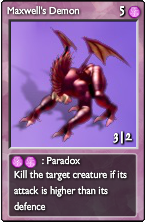 | Maxwell's Demon The name comes from a very interesting thought experiment. Imagine a box with 2 compartments, these contain gases which has different pressure. There is a small "door" between the 2 parts. Normally the system wants to attain an equilibrium, to make it simple the gas will flow through the open door from the higher pressure half to the lower pressure half.* Let's say we have an equilibrium, same pressure and same everything in the halves. But knowing that gas particles doesn't have an uniform speed there will be always faster and slower particles. We may calculate an AVERAGE SPEED, but still: most of the particles will deviate from that average. Statistically there is a chance for a particle to go the other way, but on a large scale we will observe movement from higher pressure part -> lower pressure part. OK, so here starts the story. Let's shut the "door" between the two parts. Let's imagine that there is a Demon (named after Maxwell - the thought experiment was his idea) who opens and shuts the door at will. When a faster than average particle arrives at the door from the left compartment: he will open it, and let it through to the right compartment. When a slower than average particle arrives at the door from the right compartment: he will open it, and let it through to the left compartment. But if the opposite of these happen: he won't open the door. In the end you will have all the slow particles in the left compartment, and all the fast particles in the right compartment. It is a brutal violation of thermodynamics (namely the 2 important things which I mentioned in the first paragraph). You just reversed the original equilibrium? But how is it possible? And that's the PARADOX. Zanz used creatively this concept: ATT > HP? You're dead! Are you greater than the average (X|X)? You shall not pass! Also the most simple solution to the paradox, that the demon also using energy when sorting the particles, so it DOES work to make the whole phenomenon to happen. | 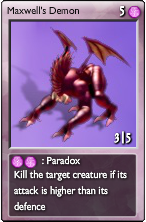 |
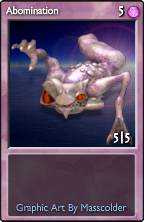 | Abomination/Micro Abomination This creature is just very ugly. No science at all. Zanz just played here the old "chaos/random = entropy" card. Entropy is more than that, you will see that at Discord. The micro version is useful with Butterfly Effect. This creature is so ugly, when it enters a bank, they turn off the cameras. :D | 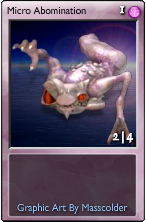 |
 | Purple/Amethyst Dragon Quoting my 12th Trials entry: Quote "Why Amethyst, why not some other mineral? The answer is obvious: the hue of amethyst is the closest to the dominant color of this mark. If you take a look at Entropy values you'll see that quartz (amethyst is a variation of quartz) is far from having a big number, even chrysoberyl (this mineral and emerald are both variants of beryl, so they are like siblings) has a greater Entropy... So the choice of amethyst is only cosmetic - however we can all agree that it was a beautiful choice." But what is a mineral? OK, shiny piece of aesthetically pleasing looking stuff, but let's quote wikipedia: "Minerals are natural occurring elements and compounds with a definite homogeneous chemical composition and ordered atomic composition." Key points: a) can be an element or a compound, b) homogeneous (contains only one material), c) definite composition = fixed chemical formula, d) large scale order, meaning it is crystalline. The old Greek word 'amethyst' means 'not intoxicating', which refers to Ancient Greek beliefs, that these gemstone prevents the user from being drunk. Because of this they made protective medals and drinking vessels from amethyst. The gem gains its violet hue from irradiation or iron impurities (or sometimes from the presence of other d-block elements in its crystal lattice). | 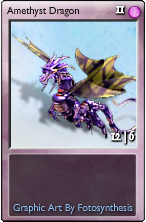 |
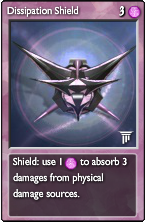 | Dissipation Shield/Field What is 'dissipation'? Another way to say that entropy is at work. Remember when I told you that there is no free dinner, and entropy grows? You have a system which stores energy in some form. Then you try to convert that energy into another form and meanwhile make some useful work. Sadly some amount of said energy will be lost to you*, DISSIPATED. Which means you cannot make a machine which runs at 100% efficiency energy-wise. Some amount of energy is dissipated and you cannot use that amount of energy for useful work. (A good example is how light bulbs dissipate some of their energy through heat exchange. In other words not all electricity is converted to light, some of it is turned to heat. Don't touch the working light bulb! Even LED bulbs can burn you.) Of course the conservation of energy applies, you are just "denied" using that remaining energy for useful work. Zanz implemented this in a really strange way into the game. If you look at the thermodynamical definition of dissipation it says that due to entropy you cannot have 100% efficiency. Here you must use Entropy quanta to dissipate damage. Until you have :entropy quanta you are protected against normal physical damage. In my opinion this is the strangest allusion/metaphor to the original scientific concept. It is sort of an "inside out" version, since it ruins the work of your opponent, by using your :entropy quanta.** Bad thing is that all the while it puts you into a sitting duck position as your quanta goes lower and lower. The 'Field' is even more funky, since it uses all of your quanta to defend. If it would be parallel to the original concept, with each conceded damage you would get :entropy quanta. But that wouldn't be that useful. | 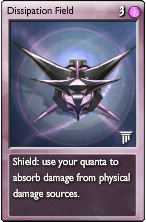 |
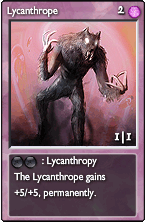 | Lycanthrope/Werewolf Well, this element needs creatures as well, so... again, not much scientific connection. As darkness comes (2 :darkness quanta cost) this puny creature transforms into something bigger and badder. It plays again with the 'mutation, entropy and changes' topic, like the Abomination card. The supposed creature first occurs in Ancient Greek literature. King Lycaon of Arcadia was transformed into a wolf as a punishment for sacrificing his child. There are other variants to the story, but we can safely state that this is the origin of the word 'lycanthropy'. Werewolf originally meant 'man-wolf'. I could list other interesting folk tales, but instead of that let's not forget that it was thought that lycanthropy can be cured by using a flower called 'wolfsbane'. I think there are a few missed opportunities here. Nightfall should affect them as well as Holy Light. I also miss a feature which would enable the werewolf to transmit the curse/disease by biting. (The original 5|5 bonus can be tuned down a bit in these cases.) |  |
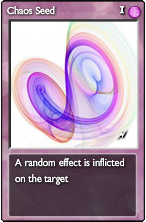 | Chaos Seed/Power Again quoting myself from 12ht Trials entry: Quote "Without further explanation please look at this picture*. It is called the Lorenz attractor, and has a central place in Chaos Theory. https://upload.wikimedia.org/wikipedia/commons/f/f4/Lorenz_attractor.svg http://www.edc.ncl.ac.uk/highlight/rhnovember2006g02.php Both cards are continuing the 'entropy=chaos/randomness' trope as Chaos Seed hurls that soft or hard CC effect to your opponent with a 1:11** chance respectively for each possible effect, and Chaos Power giving you attack/health bonuses (1:25 chance for each combination to happen). You can interpret Chaos Seed as the 'seed', the small changes in initial parameters which result in different outcomes. For better understanding read the Butterfly Effect section. The underlying principle is that even a chaotic system can be described - but prediction is hard (if not impossible). It'll be also discussed at Phase Shield. Shockwave is listed in the wiki for Chaos Seed, but not for Pandemonium, so I omitted that from the eleven CC-possibilities. Sadly, no one can test for that now. :( | 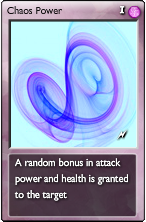 |
 | Nova/Supernova Both are pretty violent and spectacular astronomical events which signify an important moment in a star's life. Novas (or novae) happen if there is a white dwarf in a close binary star system. When the white dwarf gets close enough to its companion star it can start drawing matter (mainly hydrogen) from the other star. The newly acquired hydrogen gets heated by the white dwarf which initiates a rapid runaway fusion. The sudden energy surge also creates a lot of visible light. On the other hand supernovas shows even greater bursts of energy in a short amount of time. A supernova occurs when a massive star's core collapses (due to intense gravity), or when a white dwarf gets re-ignited somehow. Not surprisingly supernovas emit a lot of light and often they can even outshine a whole galaxy before fading away in weeks/months. In the end these stars turn into neutron stars, black holes or got completely destroyed to form a diffuse nebula. And there are also hypernovas, which are very energetic supernovas... (these are the result of a collapse of a 30+ solar masses heavy star). In the game the usage of a Nova will give you +1 to each type of quantum, while Supernova will increase those by 2. This reflects to the fact that certain chemical elements are produced while the star undergoes the supernova phase. To be honest novas produce far less chemical elements, they supply only 2% as much material to their galaxy as do supernovas. As mentioned there is a lot of light emitted, but including that into the inner workings of the card would be against the entropy theme. Also it is quite strange that we have to put :entropy into an event, which makes entropy grow spectacularly. The obvious reason is having some game balance. Funkiness: too many novas/supernovas will create a Singularity! | 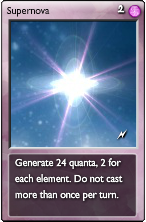 |
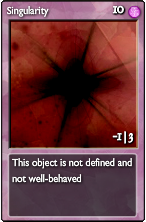 | Singularity In astrophysics it is a condition in which gravity is so intense that spacetime itself breaks down catastrophically. To give "easy" examples: a center of a black hole or the earliest states of the Universe during the Big Bang. Most of the time the word "singularity" is meant to reflect that a system or object won't behave normally after a certain point, and its behaviour will be runaway and unpredictable. Zanz took the description from the definition of 'Mathematical singularity'. (= "A point at which a given mathematical object is not defined or not 'well-behaved', for example infinite or not differentiable".) It is entertaining how Zanz treats 'not well-behaved', giving funky (somewhat random) skills to this creature. Probably due to balance reasons immolation won't give any quanta when destroyed... (In all honesty, exploiting a real-life singularity probably would give an insurmountable amount of resources, energy.) | 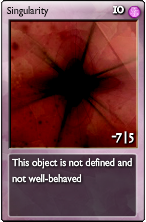 |
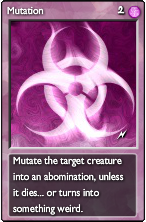 | Mutation/Improved Mutation There are different types of mutations, and you cannot deny that entropy plays a crucial role in their inner workings. In case you don't know mutations are changes in the genetic material, namely the original DNA* structure. Mistakes can happen while the cell copies the DNA, and certain environmental factors (UV, gamma or particle radiation, viruses, chemicals) can also trigger a mutation. The effect is always a chemical change in the DNA. It can be beneficial to the individual/population/species/gene or detrimental. Amusingly enough entropy may kill life in the end (again: may it be individual, a population or a whole species), at the same time it also helps life with mutations**, because the environment may change and newer and newer mutations may help the adaption to this change. So in the end entropy helps life against entropy. In case of some viruses: RNA. It would be a really long story, but diffusion helped in the creation of life, and diffusion itself and entropy walk hand-in-hand. The reason that certain configurations are statistically more plausible causes diffusion. Entropy helps life in more ways than you would have thought! The game reflects real life mutation chances quite well. Of course, not pinpoint accuracy, but I like how it categorizes them into 3 groups: neutral, lethal and random. Many mutations are neutral (=50% chance for abomination, let's say an average critter), there is a chance for lethal mutation (10% is probably not lifelike, but gameplay-wise it is ok), and also you may get something drastically different, which may be completely useless or even a game-changer (=40% for random mutant). Improved Mutation is true to its name: no lethal mutations (which takes away the hard CC possibility), all mutants are random. In fact, they are way too random. I sorta feel Zanz tuned down this spell, seeing that it can produce some really brutal creatures, and maybe he feared balance. Sadly, this way he turned a strong spell into a somewhat useful, but truly fun to use spell. And "fun to use" is not competitive enough. :( | 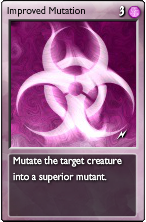 |
 | Discord Oh my, oh my, oh my...! Entropy fans: drooling mouth, everyone else: foaming at the mouth. The ultimate troll weapon! If you don't smile as your opponent's quanta gets scrambled turn by turn... I don't know what you are made of! To understand more the concept of this beautiful weapon (and how does it fit Entropy) we have to look at statistical thermodynamics! Easy-easy... it won't hurt that much... (just like Discord, hehe). In our example we will play with dice. We will roll 2d6s. The table below shows the different possibilities for 2d6 rolls. [First column: sum; 2nd column: nr of events; 3rd column: description of events.] 2: [1] 1 1 3: [2] 1 2, 2 1 4: [3] 1 3, 2 2, 3 1 5: [4] 1 4, 2 3, 3 2, 4 1 6: [5] 1 5, 2 4, 3 3, 4 2, 5 1 7: [6] 1 6, 2 5, 3 4, 4 3, 5 2, 6 1 8: [5] 2 6, 3 5, 4 4, 5 3, 6 2 9: [4] 3 6, 4 5, 5 4, 6 3 10: [3] 4 6, 5 5, 6 4 11: [2] 5 6, 6 5 12: [1] 6 6 We can see that there are 6 ways to roll for a 7. That means it has the greatest chance to happen. Using scientific vocabulary we can name the sums "macrostates" and the events "microstates". So we can reword our previous statement like this: for the macrostate of 7 there can be 6 microstates (listed in the table). From the perspective of nature 7 is the "best" macrostate (most probable) for the system, since this is the system with the most microstates. This defines it as the system with the maximum entropy. The formula for it: S = k ln w, where k is the Boltzmann-constant, and w is the number of possible microstates.* Discord is "only" creating more or equally probable microstates. Oddly enough Discord won't work if you have only a single quantum in your reservoir. (We can say it is an equally probable microstate, no matter which element has that one quantum.) I think Discord is one of the best application of a scientific concept in the game. Both entropy and k has the unit of J/K. | 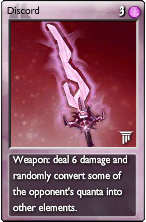 |
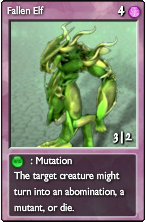 | Fallen Elf/Druid The skill what matters here - Mutation - and you can refer to that earlier part. What I truly love about Zanz's choices that he understands so well natural sciences and implements those notions very well into the game. Here is the most perfect example: life needs mutations and life gets those mutations through entropy. Thus we have this creature of Entropy who uses life quanta for mutating other critters. Beautiful! In most fantasy settings Elves are creatures living in harmony with nature, so choosing an Elf for this role was a good choice, too. (Also true for Druids!) The original 'harmony with nature' idea is subverted here: you can see it in the name and also how this creature changes other creatures at his will like a chaotic evil wizard. |  |
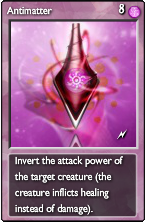 | Antimatter Talking about subversion! This beautiful skill will invert any non-protected creatures' attack. If we look at the scientific background the naming is quite a stretch, but absolutely understandable and logical to the game's inner workings. Matter consists of atoms, atoms consists of protons, neutrons and electrons, while protons and neutrons consists quarks (And gluons glues them together.) Every particle has a so-called antiparticle: antiprotons, antineutrons, positrons and different types of antiquarks. From antiparticles you can build antimatter. For example an antihydrogen atom consists of an antiproton and a positron (which orbits the previous). Creating and containing antimatter is not an easy task: when matter and antimatter meets they annihilate on contact and a large amount of energy is released. (Oh I wish Zanz added this as an option! Antimattering one creature of your opponent then seeing as it destroys another non-antimattered one! :D ) Interesting plot twist: no one REALLY* knows why the Universe contains mostly matter, and what really happened to antimatter. (Or maybe we are just unable to detect it, since they have the same behaviour, chemistry, spectra etc. as their normal matter counterparts.) Ofc there is a hypothesis for the matter-antimatter asymmetry of the Universe. Just too long and complex to interpret that here. So far humanity has created a few nanograms (1 ng = 0.000000001 g) of antimatter. The production of 1 gram of antimatter would cost 5,000,000,000,000,000 euros. |  |
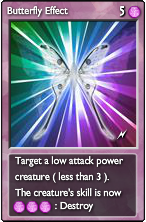 | Butterfly Effect It is the best if I quote again my 12th Trial's Phase 1 text. Quote "Another misinterpreted idea in popular culture. No, a slight movement of a butterfly's wings in New Zealand wouldn't necessarily create a storm in Iceland. Chaos theory states that by minimally changing initial conditions in a system the later state of this system can be radically different. It is not surprising that the term was coined by a meteorologist, Edward Lorenz.The best example to show the butterfly effect is to experiment with a double pendulum.* You may start the pendulum at the - seemingly - same position, and it will operate almost identically for a long while, but after a few cycles the differences will be more and more visible and striking. A tiny difference in initial conditions caused a huge difference much later. This sorta explains why meteorologists suffer with long-term predictions - there are just too many variables describing and affecting our atmosphere. Sometimes these long-term changes are called the "ripple effect", because of how these initial changes propagate and have greater effects on the whole system.** The catch is, that your creature must be tiny, like a butterfly (attack < 3). And what's really beautiful, that the earlier mentioned Lorenz-attractor - at certain values - looks like a butterfly. :) https://en.wikipedia.org/wiki/File:Double_pendulum_simultaneous_realisations.ogv Writing these lines I realized how much it is connected to Parallel Universe, but you will have to wait a bit for those thoughts. |  |
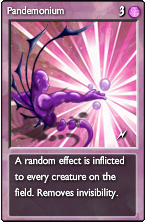 | Pandemonium Mostly a fantasy themed card, with only a slight scientific connection. The word was invented by Milton, used in his well-known book, Paradise Lost, where it is the capital of Hell. It roughly translates as 'all demons', but can also be interpreted as Pandemoneios or 'all-demon-place'. Nowadays the word is used for describing utterly chaotic situations - similar ones which happen when a player casts this spell... Entropy is often interpreted as a measure of chaos - reaching this very point in this text I hope you can see that this is only a facet of its true meaning.* It is 'simply' the unleashing of multiple Chaos Seeds. It also reveals cloaked creatures, which is also a nature of chaos - it shows you what is happening, but good luck interpreting it. :) (And here we just connected to Chaos Seed and Butterfly Effect again.) And it is beautiful how the upgraded spares your creatures if you spend a little more entropy. (You can explain that by spending extra energy to make the spell more organized - from your perspective. And 2nd law got untouched: the entropy of the two systems together indeed grew!) In most definitions you will see entropy as defined by the measure of disorder. I strongly think that the word "disorder" is used poorly. Looking at our previous example (Discord - particles in boxes) you can see that actually it has the greatest probability when particles are equally distributed between the 2 boxes. One can hardly call that situation disorderly... | 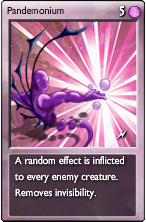 |
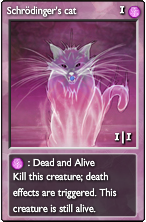 | Schrodinger's Cat Oh, another beautiful scientific paradox, another thought experiment! Named after Erwin Schrodinger, Austrian physicist, one of the most important scientist in the 20th century, famous for his essential contributions to quantum mechanics. Quantum mechanics is beautifully confusing. There is a famous saying "If you think you understand quantum mechanics, you don't understand quantum mechanics."attributed to Feynman.* Schrodinger's thought experiment of the macroworld was meant to show this intellectually painful ambiguity of the microworld (the bizarre duality of particles on a quantum level). Imagine a closed box. In this box we have a cat, a radioactive material in a sealed box and a flask of poison. There is also a monitor which can detect radioactivity** and is also linked to the flask somehow. If a single atom decays it will be detected by the monitor (e.g. Geiger counter). The monitor activates a mechanism which breakes the flask, so the poison will be released. The box is closed, so the cat might be alive, the cat might be dead... Using the interpretation of quantum mechanics: the cat is alive AND dead SIMULTANEOUSLY! However, if you look into the box you will see only one of these events: the cat will be either alive OR dead. Sounds bizarre, right? Of course we know that objects in the macroworld won't behave like this. The above thought experiment doesn't propose that cats can be both dead and alive. It just shows us through an example how objects behave in the microworld (photons, electrons, atoms, even some molecules). They can have something called 'superposition'. For example photons have a dual nature: they are both particles and waves. They have both characteristics at the same time. If you OBSERVE*** them you can only detect one of these properties at a time. Superposition for macroworld objects never been proved or described, so as I wrote before this is only a paradoxical thought experiment - though there were many tries to explain/interpret it fully. Zanz used the paradox as a skill: every time the cat enters superposition (alive/dead) death effects are procced. It nicely synergizes with different cards (Vulture, Soul Catcher, Boneyard, Bone Wall). Chances are that this quote is anecdotal. There is a very similar quote from Feynman, and other quotes from other physicist which might have inspired the above quote. Regardless of origin this quote pretty much describes the strange behaviour of small particles. Radioactivity is used in the experiment, because it is TRULY random. Quantum mechanics explains it with the collapse of the wave function of the particle. If you observe it, you 'force' the particle into one of the options, the superposition ceases to exist. | 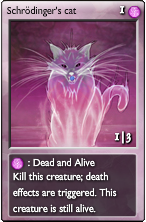 |
 | Purple Nymph Sorry, no science here, just mythology. They are female figures in the Ancient Greek folklore. They are sort of a personification of nature, usually depicted as beautiful maidens. Often related to gods, but different from goddesses. They are bound to a specific place, and they are classified by these places: ash tree nymphs, freshwater nymphs, sea nymphs, mountain nymphs etc. Nymphs are personifications of an Element in this game using an Alchemy spell as a skill. Purple Nymphs use Antimatter. They are playing the inverse game, just like that type of girlfriend who initially loves you for something then later tries to change that something in you... Things get more exciting if you consider the shape of the Antimatter cardart... | 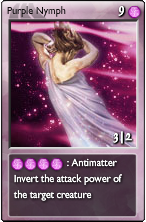 |
 | Shard of Serendipity Zanz again pulled the "entropy=chaos" trope. Pay 3 quanta - get 3 random cards. On another hand we can go back to the Boltzmann statistical explanation of entropy, which just states that more microstates mean a greater entropy. Getting 3 more cards opens a lot of possibilities - one can understand them as more possible microstates. But the naming is so beautiful! Finding something we weren't looking for by chance. We aren't necessarily talking about luck - any game situation can have multiple solutions, and we must see the possibility in those freshly acquired cards, we must play them to their fullest of potential. | 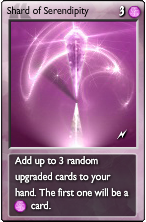 |
Post by: Wyand on May 10, 2023, 09:58:58 pm
:deathbig | DEATH | |
| The final stage of your life. And a starting stage for other life forms. To our current knowledge the biological death of an individual organism is irreversible. But what makes life possible and what make it expire? The answer to both question is: entropy. Entropy was helpful in the creation of life, but it works against individual creatures, and when such an individual cannot fend off entropy anymore it dies. After death the body starts to decompose and compounds with higher entropy created. Like life itself, death itself isn't fully understood. Why do some species have greater longevity than others? While this is explained on a superficial level, our complete biochemical and physical understanding still lacking. Currently we know that the chromosomes has a so-called telomere region, which is a repetitive nucleotid sequence with specialized proteins. Their role is to protect the end of the DNA from sticking together and from other problems. Currently it is thought that the cell divisions shorten the telomere region, which leads to the conclusion that they might be linked to aging. It is observed in humans, but not necessarily for all living creatures (older mice do not have significantly shorter telomere region)*. Genetics, biochemistry, thermodynamics and maybe even quantum mechanics is needed to explain everything in the future. We can be sure only about one thing: death is inevitable. Latest thing I heard about it that even the continuous bombardment of the DNA by water molecules can add to aging. So ultimately :entropy it is. | ||
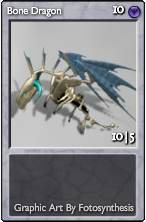 | Bone/Ivory Dragon Nothing but a fantasy creature. Also a very fantasy thingie putting undeads here, :death is always linked with necromancy. The word itself originates from Classical Greek, and was used even in the Oddysey (the realm of the dead souls was named 'nekromanteia'). The word was created from 'nekros' (dead body) + 'manteia' (divination), and originally meant summoning dead spirits and communicating with them for the purpose of divination. There was even a temple, called The Nekromanteion devoted to Hades and Persephone (husband and wife), the gods of the underworld. The originally shamanistic and very spiritual magic nowadays exist almost only in computer games where players have only one goal: to amass a huge army of dead by slaying and converting as much living as possible... | 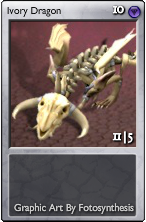 |
 | Virus/Retrovirus This word originally means 'poison'. Quoting wikipedia: "A virus is a submicroscopic infectious agent that replicates only inside the living cells of an organism." Imagine a trojan horse which not just brings the enemy into a factory, but also brings its own blueprint to multiply itself - instead of the original products. Since the virus isn't alive - it needs a host! - it is rightfully placed here, among :death cards. It is practically a parasite, the "deepest" way of parasitism, it happens on a molecular level. Most organisms have some virus(es) specialized on them, even bacteria (a huge % of them! - these are often called phage)! A host species and its virus evolve together (it is called co-evolution). Viruses killing the host cell while infecting them, damaging the host organism meanwhile. A "smart" (=properly evolved) virus doesn't kill the organism, since that ruins its survival and possibility to hop on another host. Their structure is very simple: a bit of DNA or RNA surrounded by a protective protein coat. They "only" have a means to enter the cell and then making it use its own machinery to produce copies of the virus. Retroviruses don't even have DNA, they have only RNA, and a special enzyme* to translate their RNA to DNA. In the game it merely poisons creatures. Their upgraded counterparts are poisonous against multiple enemies, though in real life retroviruses aren't necessarily more dangerous. Mimicking real life infected creatures should transmit their poison damage to neighboring creatures, but I guess that would make it too strong in certain situations. It is called 'reverse transcriptase' - beautiful name, isn't it? Anyways, scroll down to Flesh Spider to see what are enzymes. :) | 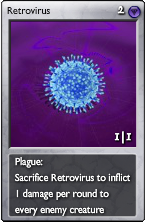 |
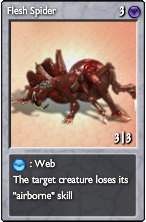 | Flesh Spider/Recluse Another staple fantasy critter. A nice touch that they can cast webs to disable the flying properties of winged critters (just like in Warcraft 3). Zanz probably got inspired by the brown recluse spider, which are able to cause a necrotic wound in humans with its bites. Healing may take months, and even after a scar might leave a mark of the experience. Its potent venom probably got omitted from them game on purpose, because there were already enough poisoner critters - even in this element. But what makes its venom so dangerous? It contains an enzyme* which is able to digest an important component of the cell membrane. It also looks definitely brown on the card art, but its appearence is more sturdy not slender, like its natural counterpart. The upgraded name also reinforces its "origin" in the game. These spider display autotomy, which means it cuts off its own leg when said leg has been attacked by another predator. They probably do this to evade their predator's possible venom injections spreading through their body. They cannot regenerate the leg with subsequent molts, instead of they are able to compensate the loss by adjusting their movement. Enzymes are proteins which are able to catalyze specific reactions. But what does "catalyze" mean? It is a single word for "accelerating a reaction by providing a different reaction route which has lower activation energy". Oh, I'm making it even more difficult, am I? Let's just agree, that it speeds up a reaction - and there are thousands of different enzymes in our body, one for each occasion, goal. |  |
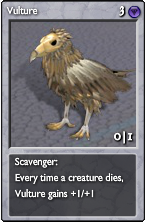 | Vulture/Condor The scavenger ability is one of my favorites, it is a really unique touch. The creature literally feeds on death like a good scavenger animal would do it in real life. There are two big group of vultures: New World and Old World vultures. The latter live in Europe, Asia or Africa. Condors belong to the group of 'New World Vultures'. New and Old World vultures may look very much alike in real life, they have evolved independently (this phenomenon is called convergent evolution). They are not just resistant to the bacteria residing in carcasses, but these bacteria are dominant in their gut flora, helping them breaking down the food! Many have a bald head, this is helping their heat-regulation. Their stomach acid is very corrosive, having a pH of 1. Ironically, these not-so-popular carrion crawling animals are beneficial to humans, because they control disease vector and pest animal populations through competition for carcasses. Many species are considered as endangered, which is troublesome because of the previous roles. Also, Nekbhet, a mythological Egyptian goddess was depicted as a vulture. | 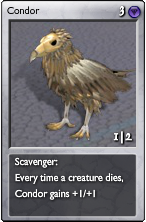 |
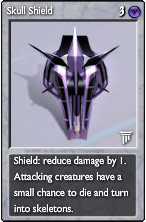 | Skull Shield/Buckler Shield: a portable cover. This one is a fancy fantasy item. Funky behaviour - not only Entropy gets crazy randomness properties in this game. Quite strange for me bucklers always being the upgraded counterpart. Although pretty useful in swordplay, bucklers are just still very small shields. Oh, is it really made of skulls or it is just a decorative name...? | 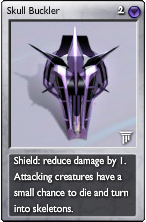 |
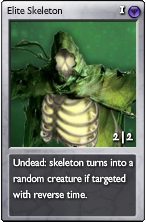 | Skeleton/Elite Skeleton Staple fantasy critter. Creative synergy with Reverse Time - though it can be questionable that in some occasions how a normal skeleton could have been once a mighty Golden Dragon... or a Photon. :D By the way... what is a skeleton? It is a framework for a body of an animal. Mostly we mean an endoskeleton, with bones, cartilages and such, though exoskeletons (e.g. shells) belong here, too*. The endoskeleton have many different roles: giving shape, support and protection to the body, and provides a means of locomotion. For most vertebrate it is also producing blood cells, storing minerals and helps in endocrine regulation. Imagine that, there is a third type, called hydroskeleton, which is a flexible skeleton supported by fluid pressure (often named 'turgor pressure'). Earthworm is a common example. Body parts can also have a hydroskeleton, just like... well, you can guess it... :-) |  |
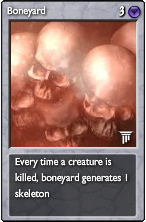 | Boneyard/Graveyard Oh, bones again! Though boneyards/graveyards have a lot of corpses they do not spawn there in normal life, someone gets interred there also before. Not complaining here, I understand it is a fantasy take on the idea. (I miss zombies from Element! They could spread some disease like in Heroes 3!) In real life these are often called burial grounds or cemetery. The latter has a nice etymology: the Greek original word means 'sleeping place'. Graveyards are within a churchyard, while cemeteries are "standalone" objects. Burial methods varies in different cultures. But let's talk about bones! They are part organic (about 30%), part inorganic (about 70%). If you treat a piece of bone in hydrochloric acid (or even in just vinegar) after a few days you'll get a gelly substance, because the inorganic part (bone mineral) is soluble in acids. The gelly substance is mostly collagen, and you can make glue or gelatine from it. So the next time you it some non-vegan gummy candy, you might be chewing on animal bones (and skin) which have plenty of collagen in it. The bone mineral is carbonated hydroxyapatite, which is calcium hydroxyphosphate in other words (chemistry is beautiful: Ca10(PO4)6(OH)2). It gives the bones compressive strength, while the organic matter gives flexibility, elasticity, which further improve fracture resistance. Our bones are constantly rebuilded, remodeled: osteoblast cells building them, osteoclast cells dissolving them. Bones also have a spongy part inside which contain the bone marrow a place where new blood cells are produced (true for mammals and birds). Bones - due to their shapes - can gain another usage after the death of an individual. You can make a drinking vessel (from a skull: skull cup), a weapon (femur for blunt weapon, more slender ones as arrow), game accessories (knucklebones, dice), religious/belief equipment (wishbone), various instruments (needle, button, bead etc.) or they can be even used for artwork (scrimshaw). Or if the bone is still fresh you can simmer them together with other food items to have a nice broth. We mentioned glue already, but charring also produces useful stuff: bone char (pigment, adsorbent). | 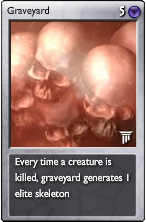 |
 | Poison/Deadly Poison What is a poison? A substance that can be deadly or harmful for a living organism (on a molecular level - thus able to harm organs, tissues, cells, even the DNA) through chemical reaction(s). Quantity matters: there are more or less poisonous materials, which we can quantify through the so-called median lethal dose. (LD50 - the value will tell you that this quantity of the materal is needed to kill off 50% of a specific population. This value is often projected to body mass.) "All things are poison, and nothing is without poison, the dosage alone makes it so a thing is not a poison." (Alle Dinge sind Gift, und nichts ist ohne Gift, allein die Dosis macht dass ein Ding kein Gift ist.) - Paracelsus 1538. There is a lot of truth in this statement, though in Elements only Poison (and Arsenic) is a poison. (Toxins and venoms are different - see later!) Btw, Arsenic is a strong poison, but there are more effective ones, like dimethylmercury which is chillingly scary. An American chemistry professor trickled a drop onto her hand - which where shielded by a latex glove! - and passed away months later. Or maybe you heard of Alexander Litvinenko's case - a Russian ex-agent - who was murdered by using a radioactive isotope of polonium (Po-210) back in 2006. It was heartbreaking to see the news day by day and see him wither slowly. Though polonium-210 is only an alpha emitter*, which can be easily blocked by some simple shielding methods, if it gets into one's body these alpha particles give off all of their destructive energy to the surroundings: the body. By travelling into every nook and crannies of one's body by the bloodstream they effectively bombarding the body from the inside.** Interestingly enough the origin of the word is 'potion', which meant 'to drink'. Funny thing: unupgraded version isn't "deadly"? :D It would be nice to show it in effectivity: it wouldn't kill an opponent, would be able only to bring down its HP to 1.) A small ratio of the decays produce a gamma rays, too. (1 in 100,000 decays.) I know, I know, you are missing cyanide, right? Quite deadly, whether in gaseous HCN form or its salts like NaCN or KCN. Oh yeah, and do not chew and eat 100-150 apple seeds in one sit, because you might die trying that... Many fruits' - especially stone fruits - seeds contain amygdalin, a glycoside compound which decomposes into a sugar and cyanide. | 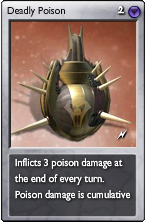 |
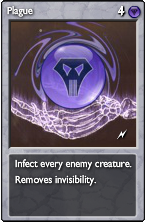 | Plague/Improved Plague There are different types of mutations, and you cannot deny that entropy plays a crucial role in their inner workings. In case you don't know mutations are changes in the genetic material, namely the original DNA* structure. Mistakes can happen while the cell copies the DNA, and certain environmental factors (UV, gamma or particle radiation, viruses, chemicals) can also trigger a mutation. The effect is always a chemical change in the DNA. It can be beneficial to the individual/population/species/gene or detrimental. Amusingly enough entropy may kill life in the end (again: may it be individual, a population or a whole species), at the same time it also helps life with mutations**, because the environment may change and newer and newer mutations may help the adaption to this change. So in the end entropy helps life against entropy. In case of some viruses: RNA. It would be a really long story, but diffusion helped in the creation of life, and diffusion itself and entropy walk hand-in-hand. The reason that certain configurations are statistically more plausible causes diffusion. Entropy helps life in more ways than you would have thought! Biology calls it 'Yersinia pestis'. Fancy name for a bacterium. The vector is a flea, which transmits it to humans from rats. Starts with fever, headache and weakness. Continues with lung problems OR swelling of the lymph nodes OR blackening of certain tissues. In Elements you just see a poison counter, but the end result is pretty much the same (if the game is long enough or the creature doesn't get healed soon). The epidemic/outbreak property is modeled nicely by the mass-poisoning effect. Interestingly and sadly enough there are still around 600 cases reported globally a year. The largest outbreak in human history was The Black Death (1346-1353) which claimed more than 75 million human lives*. We have no information about how much critter were stomped here in Elements due to this spell. And it is hard to imagine, what would do an improved plague do to us... a superbacterium, resistant to antibiotics. Luckily, the in-game Improved spell isn't resistant to healing methods. It was stopped by complex measures, namely the usage of quarantine, improved sanitation and personal hygiene. Though quarantine was used earlier as a method, the word was coined in these times. Having these ideas it is interesting that at the same time many believed that sicknesses are caused by the so-called miasma, 'bad air'. This theory have roots in ancient times, it originated from Hippocrates in the 4th century BC. | 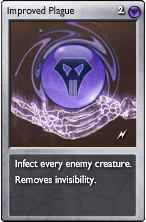 |
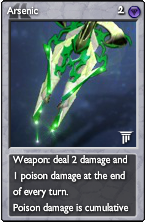 | Arsenic Element 33 in the periodic table. It is categorized as a metalloid, which pretty much means that it is sort of a metal, buuuut has non-metal properties as well (there is no good definition for this chemical concept). Arsenic has multiple variants (these are called 'allotropes'), but only the gray form looks metallic. Elemental arsenic and many arsenic compounds are toxic. It can cause a lot of health problems - even cancer, too. It can interact with more than 200 enzymes in our body. Most of the time people can get a long-time exposure by drinking contaminated drinking water. Currently more than 200 million people globally are exposed to higher than safe levels or arsenic. Since the areas most affected are Bangladesh and West Bengal you should be extra careful when consuming rice or rice milk. (It is easy to understand that this contamined water might be used for irrigation as well.) If you want to be extra safe about the arsenic content in your rice, then do the boiling of the rice in 2 phases (after carefully washing it before boiling). First, you boil it for 5 minutes, then you discard the hot water and replace it with fresh water and continue boiling until it is needed. This way the solvable arsenic compounds (mostly arsenates) can be extracted by the first batch of hot water, and at the same time most of the nutrients stay in the rice. Deliberate arsenic poisonings are usually commited using arsenic trioxide (As2O3). The most popular arsenic poisoning case must be Napoleon Bonaparte's supposed poisoning. We still don't know for sure if he was poisoned (on purpose) or not.* Arsenic can be helpful as well! (Not in the ironic way, hehe.) A medication called Salvarsan - a complex arsenic compound - was the first antimicrobial agent, and it was used to treat syphilis. It was effective, but it had side effects like liver damage... In the game we can see a unique looking dagger which evaporates and drips some green material. Of course arsenic isn't green (but grey), but in fantasy games poisons are stylized with this vibrant green hue. As a poisonous substance it adds +1 poison counter by each successful stab. It is in line with the fact how arsenic accumulates in one's body after long-time continuous exposure. Of course, his hair contains arsenic, but evenly distributed, so he wasn't getting greater doses in his late years, but he was probably poisoned from a young age. Probably it wasn't deliberate, must be some environmental pollution. The prime 'suspect' is the fashionable green pigment of that age, which was an arsenic compound called Scheele's Green (copper hydrogen arsenite; CuHAsO3). Wallpapers were often colored with this beautiful green material. Damp climate can easily make wallpapers moldy, and certain molds are able to break down this chemical creating arsine gas (AsH3) or trimethylarsine ((CH3)3As). Chances are this has caused Napoleon's gastric carcinoma. St. Helena has a damp climate... | 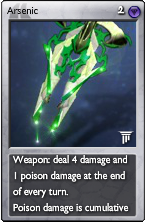 |
 | Bone Wall Another nice fantasy themed card which works very similarly to spells akin in other games. (Yes, it is a permanent here, and in most cases Bone Wall or similar skills work as a spell in those games.) It is interesting that the conception of a bone wall totally subverts the original function and placement of this tissue. In a living organism bones provide you an internal framework and protection. Death as an Element uses them as an outer protective shell... Of course no matter how durable this tissue is, it can only protect you from 1 attack per bones (layers). Consider every hit as big which can break a bone. Also death effects provide more (+2) layers of protection, which sounds reasonable (in most cases - Photons doesn't have bones :D ). Anyways, the synergy is nice, since more death just helps death, right? | 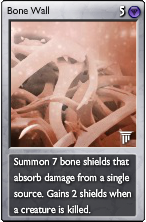 |
 | Aflatoxin Another nasty chemical. This one isn't simply toxic: it is carcinogenic and can be mutagenic, too. It is produced by certain molds, especially by those which favors your food... In fact it isn't one specific molecule, but a group of very similar compounds. They are classified as mycotoxins, a group of toxins produced by fungi, many of them being molds. In this case the perpertrator is one of the Aspergillus species. Once the mold has started to eat up a piece of food (it isn't visible yet to the naked eye!)* it immediately starts to produce aflatoxin. Why? Because it wants to kill off/hinder any possible microbial competition... You eat the moldy cookie, aflatoxin gets transferred to your body, and your chances to get a cancerous disease just grew... The next time you eat, the chances grew again... until... Some say it is safe to eat the moldy food if you remove the fungi along with the infected part of the food. Wrong, so wrong! You see, there is something called diffusion... By the time you start seeing the mold its toxin already wandered into other parts of that food item. (Not talking about that in the mold's life's timeline there are moments when they are already there with their microscopic filaments...) So just promptly discard it before it starts creating a whole civilization in your fridge... Sadly enough there were and are large-scale poisonings. From peanut butter, through milk, until cosmetics many products were contanimated with this toxin all around the world. Hungary is famous for its ground red pepper, and sadly we had a great scandal in 2004 when it was found that many distributors' ground red pepper contained more aflatoxin than the allowed level.** And one more thing. Sadly, we have to choose our poison: be it pesticide or fungi?? That is the question! Because large-scale agriculture provides a great amount of habitat for these opportunists. The danger of mold always looms above grain storages. *** What can you do? You have to use pesticides (pest killers; in this case fungicides - fungi killers), which will stay in your food. Science currently says that pesticides mean smaller risk than the toxins of these fungi. Don't forget that these bastards can cause the creation of malignant cells... not the food, but the fungi is the invisible one :D This has also caused a serious setback in ground pepper production in Hungary, which still has its effects. Ironically enough the poisoned pepper wasn't local, it was imported, and was used to dilute Hungarian products... This happens when a-holes wants to get rich quickly... and entropy favors them... And not just storage, even the crops can be infested with mold. | 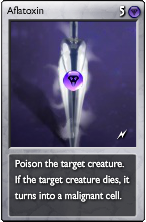 |
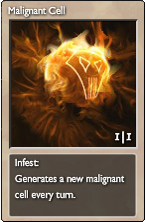 | Malignant Cell Oh, boy, what can you say when something purely evil is so beautifully adapted to this game? What? You say cancer cells can't be evil, they are just cells? Let me prove you that you are wrong. What is life's greatest achievement? It is cooperation. First: the cooperation of molecules. Later: the cooperation of cells. Even later: the cooperation of tissues and organs. Different parts of the body work together for higher efficiency. A heart alone is just a heart. Legs may look like servants, but without legs your chances for reproduction, transmitting your genes are lower (than it would have with 2 perfectly working legs). So every organ and body part are playing along. The same is true on a cellular level. Cells might "think" that 'hey, I'm more important than my neighbors', but in fact that's no true, they are replaceable, and they have to work for the common goal: ensuring the ongoing existence of the whole body. There is a yin and a yang: each cell wants to survive and they have their own 'agenda', but in the and they have to cooperate to achieve that goal together. It might sound like a fairy tale, but that's how evolution works: cells, genes may compete with each other in an individual, but they achieve a common goal together by submitting themselves for the greater good. If the body survives, they survive. And that's why malignant cells are evil. They only care about themselves. In their "blind wish" for immortality they disregard the needs of any other cells, they need an improved amount of nutrients and water, because they somehow dropped the shackles of programmed cell death. Every cell is deserved to die. They disobey that through biochemical malfunctions, which leads to the eventual death of the organism. Such cellular immortality is not compatible with life. That's why this card belongs here. | 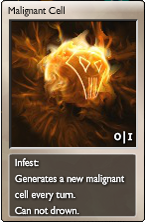 |
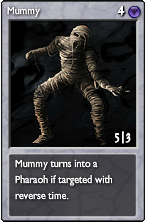 | Mummy/Elite Mummy Ohnoes! More undead! Next fantasy staple. Mummification can be natural (by ice - see ?tzi, the Iceman - by dry conditions, or by having little to no oxygen present - in bogs) or deliberate, using different embalming materials. In fact the word 'mummy' comes from Persian, where 'mum' meant 'wax'.* Many cultures used mummification for their corpses. Often not only for humans, but also for animals. In Egypt over 1 million mummies have been found, many of them are cats or sacred ibis birds. The world's oldest mummy is more than 9,000 years old, but resembles more to a sack of bones than to a 'classic mummy'. Anthropogenic mummies were created most commonly for religious purposes. There are many important steps for conserving a body. Most importantly the internal organs must be removed (the Egyptians also washed out the body with a mix of spices and palm wine). They left only the heart in the body (which they believed was the center for thoughts and feelings and might be needed in the afterlife). After that the body was desiccated using natron - mostly Na2CO3 which was plenty in Egypt. The process usually took 40 days. The same was done to the organs which were put back in the body or enclosed in separate jars. After drying out the remains were wrapped in many layers of linen. Between the layers amulets wered place by the priests to guard the deceased from evil through their underworld journey. Mummy's or Pharaoh's curse is often mentioned in popular culture. Hieroglyphs have been found in Giza which warn people that if they disturb the dead that might have serious consequences (in a "don't steal because the gods will punish you" manner). But 6 weeks after Tutankhamons's tomb was opened a wealthy sponsor of the expedition died. This was enough for the press to scare people with the "curse" again. Since some ancient mummies carried mold (including Aspergillus niger and A. flavus) it was hypothetised that these microbes (and others) might have cause the blood poisoning of the mentioned sponsor. It is easy to picture a scenario where a damp, closed area gives habitat for a lot of microorganisms to flourish. While the above scenario might be true, many scientists still doesn't agree with the notion regarding the sponsor' death, arguing it isn't realistic that the microbes took their sweet time, and killed the man only 6 weeks later. They think it is more probable that the sanitation level of Egypt wasn't really good in the 1920s. Regardless of these, there is no Mummy's curse in the game (wait for a conclusion at the Pharaoh card), but there is a nice touch that they get into their "original shape" (Pharaoh) when targeted with Reverse Time. 'Mumiya' meant 'asphalt', so this wax was bituminous, dark. Both words' 'u' has a small line above it, but forum engine still hates special characters. | 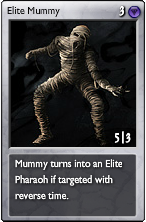 |
 | Deathstalker "Scorpions are ugly and dangerous" fantasy trope. First of all: deathstalkers are yellow or green! They are venomous animals. There are different toxins in nature. A venom is a toxin injected by a bite or a sting. A toxin is called poison if its delivery method is ingestion. So the rule of thumb: you get poisoned by a bite - it was a toxin, you get poisoned by 'biting' something - it was a poison. Like licking a poison dart frog. Don't do that please. Deathstalkers' are one of the most dangerous species of scorpions. Their venom is a mixture of different toxins. These are polypeptides, which means they consist about 30-40 amino acids. They block different ion channels (K+,Cl-) which are important in communication between cells especially regarding the inner workings of our nervous system. In short, these toxins screw up the nervous system and by that the operation of muscles effectively paralyzing the prey. Though the sting is extremely painful, it would only kill a human if the recipient is too weak - being elderly, sick (allergy, heart problems) or very young. Scorpion venom is extremely expensive. It costs about 10 million $ per liter! From all the different scorpions Deathstalker has the most dangerous and most expensive venom. Their venom is used to treat arthritis, cancer (still experimental), for brain tumor detection, preventing organ rejection during transplants etc.. One scorpion can produce only a small droplet of venom (about 1 mm3), hence the big pricetag. One must say that these critters in the game are sorta impotents since they have an attack of zero, and they are in the need of a buff to actually deliver that deadly venom... It is like their sting needs a sharpening, or what. But the 2 poison damage counter correlates with their very potent venom. |  |
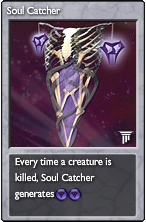 | Soul Catcher Originally these are amulets used by shamans of Alaska. They were constructed from bear femurs. The shamans used these to cure patients in case their sickness proved incurable by herbal methods. So in fact these were used to catch and get back the soul of these afflicted people. Another possible use was to suck malevolent spirits out of the patient (sounds like exorcism). One of the coolest effects in this game are produced by this less used permanent. As the name says it catches the spirit of fallen creatures. Then it converts it into death quanta. Creative usage - but again, no science, but mythos and fantasy here. | 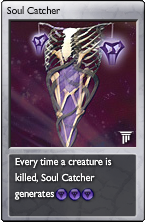 |
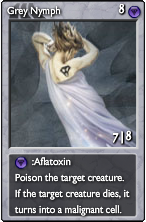 | Grey/Death Nymph Definitely not the Nymph you want to share your bed with. Getting aflatoxined from your girl isn't a fun thing.* The only slight connection I found are The Grey Sisters (Graeae) from Greek mythology who shared one tooth and one eye. They took turns using these body parts, which means simultenously only of them could see and/or talk. The hero Perseus forced them to give informations about certain magical items needed killing Medusa by stealing their eye. Their names were Deino (dread), Enyo (horror) and Pemphredo (alarm). They must have HPV or something... Not so fun fact: men can have cancer developed (tongue or similar oral cavity / esophagus-related) by performing oral sex on women who have HPV... (ask Michael Douglas). You might think it is funny, but recently these type of cancer cases significantly grew. |  |
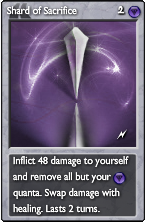 | Shard of Sacrifice Another creative, but non-scientific card. "Pay by your own blood and spirit, and hopefully get healed by your sacrifice." |  |
Post by: Wyand on May 10, 2023, 09:59:48 pm
:gravitybig | GRAVITY | |
| Gravitas means 'weight' in latin. If you look around here you will see big, bulky creatures. But what is gravity as a force? It is one of the four fundamental forces, and surprise, surprise: it is the weakest of 'em all. 10^38 times weaker than strong interaction, 10^36 times weaker than electromagnetic force and 10^29 times weaker than weak interaction... It has almost zero effect on the level of subatomic particles. But as the weight of objects grow grows gravity as well, and on a macroscopic level it is the most significant interaction, it governs the motion of moon, planets, stars, galaxies and even light. Gravity was needed for some star formation, this was the force which gathered, pushed together the gaseous material to form stars in the first place. Gravity has an infinite range - though the force itself diminishes as the distance grows between interacting objects. Furthermore the general theory of relativity states that gravity is not even a force, it is the curvature of spacetime caused by the fact that mass isn't distributed evenly in the Universe. But for everyday use we are happy with Newton's equation (F=G*(m1*m2)/r^2 - where G is the gravitational constant, m1 and m2 are the mass of the objects, while r is the distance between them), which states that gravity causes any two bodies being attracted to each other. (Is it a too corny pickup line, guys? :D ) Gravitational waves were just recently (2015) detected and for that we needed to witness the merger of two black holes. You might say, but that's easy-peasy, they have produced massive waves for sure. Well yes, you couldn't ask for bigger gravitational waves. We had to build interferometers with 4 km long vacuum tube arms to detect them! These are capable of detecting changes in spacetime as a fraction of a size of a proton! But we still haven't detected the theoretized gravitons, which must be the carriers of this 'force'. Considering the technical difficulties of the wave's detection, and the immense energy which would needed to detect such a particle by using particle accelerators or similar techniques... It isn't plausible that we would detect them in the next 100 years. But still, it is a 'force' which is the closest to the average person. It is what we sense everyday, as it binds as to Earth, to the Sun and to the Milky Way and to other greater structures on this cosmic carousal. | ||
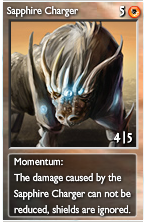 | Sapphire/Elite Charger Pretty much a fantasy rhinoceros. A very badass version, since some parts (horn?) are named after (made of?) sapphire, which is a variant of corundum which has a Mohs-hardness of 9. The maximum on the Mohs-scale is 10 (diamond). Corundum is the 3rd hardest natural gem. Curiously enough this rhino can bypass (=destroy) every shield, including a Diamond Shield. :) | 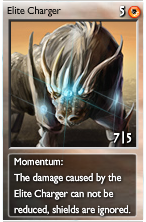 |
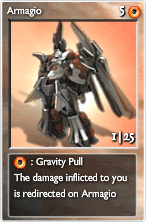 | Armagio/Elite Armagio Big bulky creatures looking like they've been dragged here from a mecha-anime, named after the Basque word for "armor". With looks like this you would expect they could turn into a car or a plane, but instead of that they just eat up damage directed at you using their "gravity pull" skill. I bet the main idea is that "it is big, it is heavy, it has big gravity". It is quite as a stretch, as a metaphor. The gravity of a celestial object is related to its mass and its surface area. (More closely to the radius of the object.) So if an Armagio has greater density than a normal creature, it will have greater surface gravity. And it will have a greater chance to 'catch' other objects (pulling them), which has smaller gravity. Translating this to Zanz-metaphor: as long the Armagio has some hp to block damage, it will do so. Which is strange, because following both 'game logic' and 'science logic' it should only block if 'Armagio hp' > 'incoming damage' and this way we could explain it with a strange gravity metaphor (greater gravity object draws in smaller gravity objects). But nevertheless, this card was still just a nice niche card having that "extra bonus" which it got from Zanz. |  |
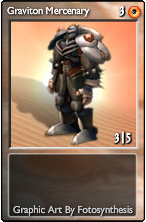 | Graviton Mercenary/Guard Guess :gravity needed a cheap and effective creature, too... But hey, what's with that fancy word? Well, that's the aformentioned hypothesised particle, the force carrier of gravity. Let's stop here for a moment. Human beings have a tendency for categorizing things. We like to dissect things (physically or logically) just to build up a logical structure from them. Every science has its own taxonomy. Often these categories have a master category, which includes everything (or just sits atop everything else). It is not a novel idea, even ancient philosophers were thinking alike. Think about Thales, who taught that water is the first principle, everything originates from water. Others (Anaximenes) held that everything is composed of air. Heraclitus considered fire as the fundamental element. Later, Empedocles came up with the idea of an "unified hypothesis", naming all four known elements (fire, air, water, earth) as principle elements (archai)**. This was later popularized and polished by Aristotle. Some 2500 years later physics trying/tried to pull a similar shenanigan. According to our current model there are 4 fundamental forces: electromagnetic, strong interactions, weak interactions and gravity. The Standard Model can only unify the first 3, because gravitons are only hypothesised. The problem is that if gravitons even exist they are virtually indetectable... Another model, the Electroweak Theory unifies weak interactions with electromagnetism, and the Grand Unified Theory (GUT) unifies the strong interaction with the Electroweak Theory... On top of everything the GUT would be unified with gravity, and voila, we have the Theory of Everything! At this point you may sense what is my problem. First of all: I ain't no theoretical physicist. Secondly: I do have some common sense and a degree in natural sciences (chemistry), which sorta means I had to learn a bit about elementary particles and forces*. This unification madness always bugged me. I mean, part of it totally works, the success of the LHC proves it. But there are some "plotholes", which sorta tells me, that again our categorizing and "Final Truth"-seeking human nature wants to construct something which looks perfect (like Aristotle's idealized version of four fundamental element hypothesis), but doesn't really work. Perhaps we should accept that there are no perfect theories which cover EVERYTHING in our Universe. The Universe isn't necessarily perfect. Perhaps physicist should learn more chemistry. There are many, many situations in chemistry where you cannot explain a phenomenon perfectly with one theory or model. You just simply use multiple theories - one theory will cover one part of the problem, another theory will work for the rest. If we try to create ONE PERFECT THEORY it is possible that the thing will work only on paper. And to me chasing a perfect theory sounds pretty much like religion... Consider this. Empedocles just found the four basic states of matter: gas (air), liquid (water), solid (earth), plasma (fire). Too bad they thought these are basic elements. https://upload.wikimedia.org/wikipedia/commons/thumb/7/7f/Particle_overview.svg/1280px-Particle_overview.svg.png | 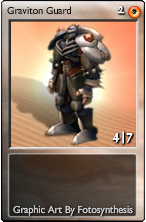 |
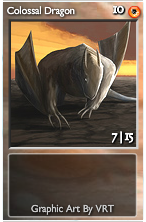 | Colossal/Massive Dragon Fatso = heavy = mucho gravity. It sorta looks like a fat bat-rodent-kangaroo-dinosaur. Bet its main attack is to jump on someone's face. Jumping... to be fair it shouldn't even fly, but in that case it would suck even more. Since :gravity already has Charger and Momentum, a sedentary dragon (with small extra ability relating to its size) wouldn't have been a problem, I think. | 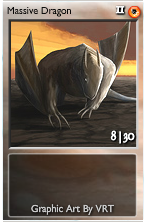 |
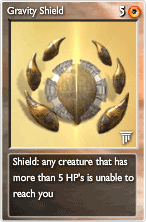 | Gravity Shield This permanent works like a narrow road, or a keyhole. You are big? You shall not pass. Finding the logic here evaded me. Sure, it works well gameplay-wise, it has nice synergies with other cards of this element, but gravity itself doesn't work like this. I wonder what sort of reason can we find for it. Does it have an anti-gravity field made of anti-gravitons?* And maybe that repulses objects with big gravity? Errr... theoretical physicists say gravitons would be anti-gravitons at the same time, just like photons are anti-photons, too. Then this shield has negative mass, thus causing a repulse effect? Okay, but it has to be tuned somehow, because smaller objects tend to reach through it...** Sadly, an anti-gravity machine remains imaginary, because its existence would violate Einstein's general theory of relativity. Interestingly its upgraded version is not a 'Buckler'. :) | 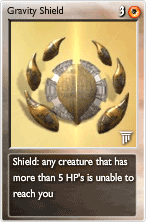 |
 | Momentum/Unstoppable "Mass in motion." The product of the mass and velocity of an object (p=m*v). It is a vector quantity, possessing a magnitude and a direction. Momentum is conserved (just like energy). Imagine billiard balls colliding. Or a Newton's cradle*. Or imagine a speeding Sapphire Charger. :) In fact all moving objects has momentum. In that sense Element's idea is plainly wrong, or all monsters - except Chargers and Momentumed ones - are just sitting there, doing nothing. Another metaphor which is pseudoscientific, but works well in the game's ruleset. Since :gravity contains a lot of physics-related cards, we can say it just follows this pattern. You know, those bouncy balls, where there is a series of small balls in a row, each one suspended by a thin strand, and the first one moved sideways then released... causing it to bounce into the second ball which transmits the received momentum to the next ball... ah, but hopefully it was enough to make you remember! There is also angular momentum, also called rotational momentum. If you ever saw a gyroscope you must be at least a bit familiar with the concept. It is also conserved, and this is the cause why hurricanes form spirals and neutron stars have high rotational rates. |  |
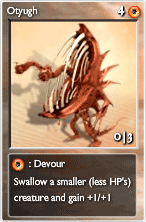 | Otyugh/Elite Otyugh Borrowed from AD&D. Most of the time they were eating trash, dung and well, pretty much everything disgusting. Of course it didn't mean that they would have scorned the possibility of eating some fresh meat - they just didn't have the opportunity open all the time. They work pretty much the same in Elements - except they are much less dangerous creatures initally. After gaining some weight they can be feared even by the mighty dragons as well. Being a big creature who mostly lives in the underground it could have been easily ended up as an Earth creature, but I guess Zanz put it here due to balance reasons (though :gravity has GP, I feel this type of CC is more direct). Other reason to put here that it grows in mass as it eats more and more, and it makes its gravity grow, just like in the case of any celestial object. (Moon or Earth 'eating' small meteroids, asteroids, a star eating planets, or a black hole eating its neighboring star etc..) | 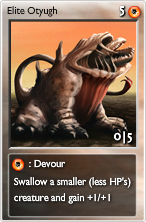 |
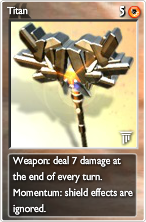 | Titan Greek mythology again. The Titans were the 12 children of Uranus and Gaia*. They also had children, who are also categorized as Titans. The Titans were pre-Olympian gods, who were defeated by Zeus. The word 'Titan' ended up in English language as well, in the form of 'Titanic', meaning huge or very powerful. This weapon is just both... so it was easy to capitalize again on the "big and chunky = gravity card" trope. Oceanus - titan god of sea and water, Thetis - titan goddess of fresh water, Hyperion - titan god of light and observation, Thea - titan goddess of the sun and light, Coeus - titan god of the oracles, wisdom and foresight, Phoebe - titan goddess of prophecy and intellect, Crius - titan god of constellations, Mnemosyne - titan godess of memory, Iapetus - titan god of mortal life (or of death), Themis - titan goddess of law, order and justice, Cronus - titan ruler of the Universe, Rhea - titan goddess of fertility. A very democratic roster. Looking at this list, an item dubbed 'Titan' could have easily ended up in other Elements as well. | 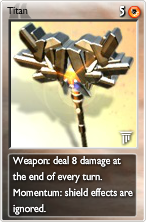 |
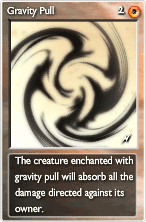 | Gravity Pull/Force This has been discussed at Armagio. | 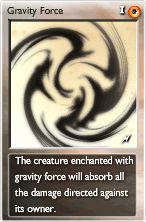 |
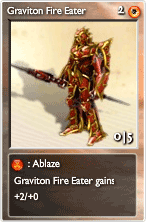 | Graviton Fire Eater/Firemaster Hypothetical particles as an attribute again, this time it also eats fire! Makes me think of creatures from the deepest bowels of Earth, eating magma and such. Which makes them grow. Again, would fit :earth as an Elemental choice, but since our closest relation to Gravity that we always fall back to Earth... it isn't a bad choice either. Still, it is quite whimsical that both :gravity and :fire gets lava-related cards, but :earth is omitted. Tried to find something along the lines that the gravitational well effect might be so strong near the core that it helps melting rocks, but found nothing which would confirm this idea. | 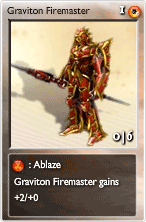 |
 | Black Hole Black Hole! The one that consumes all! Even light cannot escape its fearful gravity! The natural phenomenon is perfectly used in this game, eating up your quanta (if you have any) - at the cost of a few :gravity quanta. Also heals the caster, just like if it would just give the previously gobbled up energy/materials to the caster. Since it is an Alchemy spells it is presented in a small vial. Imagine such a real life vial, and the consequences when it is opened...* Huge amounts of energy is needed to create a black hole. A Type II supernova can form a black hole - if it had enough initial mass. Normally, a star has an internal pressure (points outward), and a huge gravity because of its enormous mass. They are - sorta - balancing each other out. When the internal pressure can't compete anymore with the gravity a gravitational collapse happens, and a compact star - whit dwarf, neutron star or black hole - is created. If the remnants of the original star is greater than 3-4 Solar mass then it'll turn into a black hole. Black holes can largely differ in size. It is hypothesised that the seeds of supermassive black holes - which are at the center of galaxies - are created in an earlier epoch of the Universe. Since we are talking "only" about gravity, we can calculate what size is needed for an object with a given mass to form a black hole. (Remember that gravity correlates not only with mass, but with radius as well!) Doing that calculation we can see that if we cram the Sun's mass into a sphere with 3 km radius than it'll operates as a black hole. If we do that same with the Moon, its radius would have to be no greater than 0.1 mm**. The radius which corresponds to the mass of the object (in order to become a black hole) called the Schwarzschild-radius. Stars rotate, so black holes also rotate. But since they have an enormous mass and small size they rotate blindingly: they can reach up to the 90% of light speed! (This is in concord with the conservation of angular momentum!***) Getting closer to a black hole one will reach a point of no return, the so-called event horizon. Anything closer than that means no escape from the gravity of the black hole. In the center of the black hole there may lie a gravitational singularity (see above at Supernova). There are still a lot of questions about the nature of the black holes. Even detecting them can be tricky, since they don't emit any electromagnetic radiaton (except for the hypothesised Hawking radiation). Their high gravity can have an influence on their surroundings great enough to be detected. For example black holes can cause gravitational lensing, distorting the light of any objects behind them in space. Also let's not forget how black holes contributed to the discovery of gravitational waves - see in the prelude for :gravity cards. Extra topping on the cherry: where gravity is stronger, time passes more slowly****. Because of this time seems frozen on the event horizon. Makes me remember to my favorite Monty Python animation snippet. Won't give an exact timestamp, because if you like MP you'll watch it anyways, and if you don't, well, it doesn't matter... https://www.dailymotion.com/video/x3cwnjs (Monty Pythons Flying Circus Season 3 Episode 6 The War Against Pornography) Before the LHC started, there were rumors on the Internet that the high energy collision of particles MIGHT form a black hole, causing the end of Earth. Though there are some hypothesises which would allow such event, these micro black holes are still expected to evaporate after 10^-25 seconds... If you read the spoiler at Momentum, you already know what 'angular momentum' is. The easiest way to understand why black holes rotate crazy fast is to remember how figure skaters behave when they are spinning. When their arms are stretched and far from their body, they spin slowly (mass farther from the central axis of rotation), when they pull their arms close to their body they spin faster (mass closer to the central axis of rotation). Because of this the a normal star (like the Sun) rotates slowly - big mass, but also big size. Neutron stars and black holes have that big mass in a very small size - they have to rotate faster to conserve angular momentum. This has been verified by satellites. Gravity is greater on the surface of the Earth, and smaller where the satellites move. Because of this time passes more slowly on the Earth, which causes a 45.8 microsecond daily difference (compared to the receivers of the signal which are closed to Earth). | 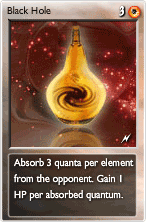 |
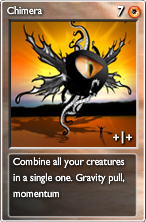 | Chimera Greek mythology strikes again! The Chimera was an obnoxious creature, which sorta looked like if it was tailored together from different other creatures: a lion's head and body, a goat's head protruding from its back and having a snake as a tail. Chimaira means she-goat. She was able to breath fire. It was killed by Bellerophon from his winged horse, Pegasus, the hero hurled a piece of lead with a spear into the throat of the monster, which suffocated from it because its own fiery breath melted the metal*. The game only takes the base idea of the monster: let's put together a lot of creatures, which will result a big, ugly fearful baddie. Again the huge --> heavy --> gravity logical line. It has momentum and gravity pull for balance reasons. It would have been nice to have an extra weakness for bow attack (maybe sustaining double or triple damage from Owl's/Eagle's Eye) - adding extra connection to its myth. Nowadays all sort of mixed creatures or ideas are called a 'chimera'. Genetics also using this abstraction to explain organisms which has more than a single genotype. The simplest example - which also helps understanding what genotype is - a single rose with 2 different colors: half of it white, half of it red**. Bellerophon is my favorite Greek hero, and I kinda don't like the version of his story I find almost everywhere. They state that his rebellion against the gods was caused by his hubris. When I was a kid I had a favorite Greek mythology book penned by a Hungarian author, where Bellerophon rebelled against the gods because despite his heroic deeds he was punished by them and that lead him to challenge them. More details later at the card 'Pegasus'. Hybrids are different. When to different species gets crossbred that will result a hybrid, in which each cell will have genetic information from both species. |  |
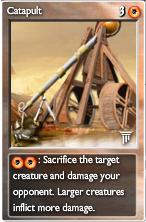 | Catapult/Trebuchet Generic strategy game unit used in a very funky way. The word catapult is used in two different ways: as an umbrella term for all types of siege weapons which bombard the enemy with various items (without the usage of gunpowder!) OR for a specific type of catapult which has the exact name of 'onager' (a Roman weapon, that's what you mainly see in strategy games like Age of Empires). Meanwhile the trebuchet is a type of catapult, probably the most precise and deadly "big sling"-type siege engine. The catapult was invented by ancient Greeks (and around the same time ancient India did the same, too!). Originally it fired big arrows - we can state they were the precursors of the Roman ballista*. Later on stones were used, too. Catapults suddenly release stored potential energy thus transforming it to kinetic energy. They usually convert tension or torsion energy, what was built up tediously by human workforce. Which means the operators of the catapult first must e.g. cock a bow, use a restraining rope, springs, elastic material etc. (building up the energy; triggering) then release it later. There are two types of trebuchets, but in most cases the counterweight trebuchet was used (due to being much easier to operate). These are using gravity to throw a projectile (mostly stone) by a lever (a beam connected to the counterweight). First the counterweight is raised, which is held in place by a trigger mechanism. When it is released the counterweight falls and the beam pulls the sling (making the payload fly). It worked like a double pendulum. Really good trebuchets were able to propel the projectile to 400 m. The weight of the payload depended on the weight of the counterweight. 100+ kg payloads weren't rare, but that needed 10+ ton of counterweight. Extremely accurate shots are possible with a trebuchet (if the operators are experienced enough). One of the most creative usage of existing ideas in this game by Zanz! Shoot livestock (or undeadstock), cause damage according to a nice mathematical formula (HP*100/(HP+100)). Also frozen creatures add 50% extra damage (discouraging your opponent using that CC), while poisoned ones will also give a nice poison counter to your opponent (this was also done in the middle ages, catapulting corpses and/or excrement to spread diseases in the castle under siege). The choice for cardnames is good since trebuchets in real life were superior to catapults, a true upgrade. And why :gravity ? Well, the already mentioned projectile trajectory is greatly affected by gravity. :) They look like big crossbows. What I learnt from Witcher 2: you cannot except to hit the exact same spot twice in two successive shots with a ballista, since after the first shot it will move a bit from its original position due to the momentum it gains from the discharge of the projectile. :-) Ballistas also used smaller projectiles than catapults. Better watch a video about it, hard to explain it perfectly within these few lines. :) | 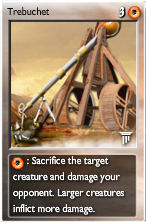 |
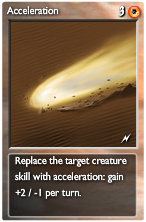 | Acceleration/Overdrive Gravity already had Momentum, now we have Acceleration, all we miss is Inertia. It sorta feels that Zanz added a lot of Newtonian stuff here on purpose. (Hint-hint: Newton - apple - gravity.) Simply put, acceleration is how does an object's velocity change with time. If it is a negative number might be called deceleration. Since they are both changes in velocity, deceleration and acceleration are treated the same. If you are interested why I mentioned Inertia, just remember what happens when you don't have anything to hold on in an accelerating/decelerating bus/tram. :) The metaphor for acceleration in this game: as your velocity gets higher you are more susceptible to possible damage (due to momentum, but that's another story). Here our creature's attack gets greater, meanwhile its health slowly degrades. Overdrive shows a better way how it works, imagine overdriving an engine through we attain a higher velocity, but the engine gets irreversibly damaged*. There is an alternative engineering meaning for overdriving a car, that's not what I was talking about here. | 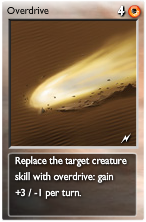 |
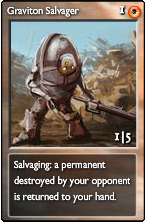 | Graviton Salvager A strange, Wall-E-like creature which magically gets back your recently deleted permanent. Hard to explain its inner working with gravity. Even gravitational time dilation won't explain this, since that only slows time, does not reverse it. (And you would need a huge gravity for that.) A Time Salvager (through time-reversal) or Entropy Salvager (same) would work better. Maybe they were added here due to balance reasons: some defense against PC. They are the enviromentalists of Elements, since they sorta recycle items. | 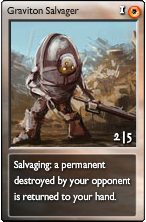 |
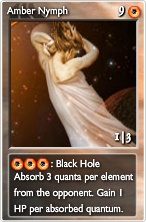 | Amber/Gravity Nymph Oh, so tongue-in-cheek! A babe which casts Black Hole... Sucking away your... quanta. Again and again, until you'll get empty. And the effect also nurtures the caster. Well done, Zanz, well done! ;D | 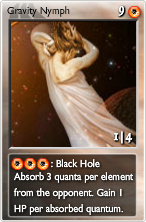 |
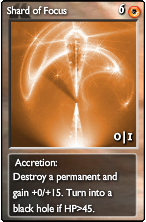 | Shard of Focus Let's start with its skill: accretion. This is a word rarely used (at least in its astronomical meaning) in news, though if you were observant enough you may heard it when poor Pluto got stripped of its "planet" status. Why? Because the definition of 'planet' changed. The new definition states that - among other things - that a planet must have cleared its neighborhood around the orbit.* That clearing often leads to the accretion of the bigger object as smaller objects collide with it.** That is the astronomical meaning of accretion. Most astronomical objects (galaxies, stars, planets) are formed by accretion processes. With this we explained how can the Shard of Focus delete permanents, and more importantly, why does it grow in health. But why does it turn into a black hole over a certain limit? Black Holes (like other massive bodies, stars) also have accretion disks, though the game's logic is reversed: when the black hole is "born" it will start to grow an accretion disk, because it continually draws matter from its celestial surroundings. Interestingly enough the new official definition of 'planet' is already under attack. Some planetologists find it controversial how they (IAU) changed the definition by a concept which is almost never used in researches. Other two thing which can happen to the smaller object: disturbed to another orbit or be captured as a satellite or into a resonant orbit. | 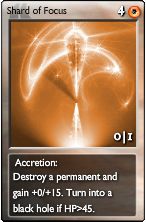 |
Post by: Wyand on May 10, 2023, 10:00:03 pm
:earthbig | EARTH | |
| Our home planet, and everything solid it contains. The surface we stand on. And the layers under. Both soil and rocks. Even the core*. The word 'Earth' has many meanings. Firstly, the planet. Secondly the solid surface of this planet (29.2% of the total surface area). Thirdly, the material in which plants grow. And last, but not least: the classical element, to which this game refers. By the way: this is the first classical element we meet on our way of exploring the game's elements. As discussed earlier Ancient Greeks and later alchemy treated every change as a change in a state of matter, sadly. (This greatly hindered natural sciences, especially chemistry**.) According to them 'earths' were the materials which stayed the same while heating. Unbeknownst to them these materials weren't really elements: they were oxides, such as magnesium oxide (MgO) or aluminium oxide (Al2O3). The group IIA in the periodic table still called 'alkaline earth metals', and the group IIIA as 'earth metals'***. Different types of rocks will be explained later, so instead of that just a quick recap of the layers of Earth. Crust - on which you walk (soil is the outermost fertile layer****); mantle - thickest part (about 2900 km), flows like molten asphalt; its movement causes the plates of Earth to move; outer core - mostly liquid iron and nickel, temperature is between 3000 and 8000 Celsius degree; inner core - temperature still in the thousands, and the pressure is 3 million times greater than on the surface, and because of this it is a solid material. The core is partially liquid, hard to classify it. Lava is a liquid, too. They are both part of Earth, part of the inner spheres. The game treats lava as a continuity between earth and fire. It wasn't called chemistry back then. We had to wait until the 18-19th century to get rid of the 'al', together with the philosophical/mystical approach to see it blossom to a real science. The groups of the periodic table has different numberings. Mendeelev originally used Roman numbers, but he had to use duplicates, for example both the scandium group and the boron group had the number III. To tackle that later they got a letter attached to them (A or B). But confusingly there were still two different versions. IUPAC (Europe) added an 'A' for the first 7 columns (from alkali metals to the manganese group), then 'B' from the copper group to the halogens (penultimate column). CAS (US) had a more logical approach: 'A' for the main group (s- and p-block in the periodic table - the left and the right part) and 'B' for the transition metals (d-block - the middle part). I think IUPAC hated that this might have caused some disarray, and wanted to unify things, so nowadays the official approach is to number all column with a single number from 1 to 18 (left to right). It is boring, lacks fantasy, and does not relate to valence electrons - which the CAS method did fantastically*. (The valence electrons are very important for chemistry - these are the ones which are able to create bonds with other atoms.) Pick any main group elements, then check its column, it equals the number of valence electrons it has. (E.g. boron is in IIIA, it has 3 valence electrons.) The same is somewhat true for transition metals, but it relates to the maximum possible valency (valence) of an element (manganese is in VIIB, it has a maximum valency of 7). (Valency(/e) is not the same as valence electrons. It tells you the combining capacity. For example hydrogen's valency in H2 is 1, sodium's and chlorine's is 1 in NaCl, while oxygen has a valency of 2 and carbon 4 in CO2, due to double bonds.) And as always: there are exceptions. Yeah, chemistry is hard. Oddly enough all of my Hungarian textbooks used the 'American' (CAS) version. I have a feel the previous IUPAC version was used in Britain. The color of soil depends on composition. The well-known brown (or black) color is due to the high organic content, which was broken down by microbes. Higher percentage of charcoal means a darker color. A long article could be written about humus, a very important constituent of the soil organic matter - it is formed from the decomposition of animal and plant matter and also adds to the dark color. 'Humus' means 'earth' in Latin. | ||
 | Antlion/Elite Antlion The strangest critters in the entire game. I mean I can't name fantasy games which have huge antlions. Half-Life 2 had bugs named antlions, but they looked so different than real life antlions. Antlions in nature range from 2 to 15 cm (wingspan). If you do a quick search for pictures, you will find two types: big-butted, huge-jawed larva and a bit dragonfly-looking adults. The picture on the card resembles neither, but due to the jaws and the burrowing ability we can safely say the original intention was to bring the larva to this game. True to their names they mainly hunt after ants, but ready to eat other small arthropods as well, like other insects and spiders. Knowing how this little fella hunts (making small conical pits in the sand/dirt and ambushing from below) one would imagine a deadlier skill than just defensive burrowing.* I guess Zanz thought the game already has one deadly burrower, and in the same element... I still do wonder about the size of this critter in this game. Unupgraded version packs as much damage as an Elite Skeleton, while the upgraded not just on par with Hematite Golems, but they are extremely cheap/effective. It can also play dead to evade predators, but the defensive burrowing skill does the same in the game. | 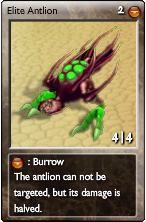 |
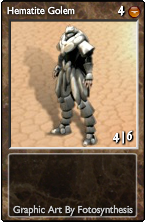 | Hematite/Steel Golem Half science, half mythology. This time not the Greek mythology, but Jewish. Many fantasies contain this animated antropomorphic creature, which is often created from clay/mud. It is interesting to notice two things here. One is that many creation myths imagine that humans were created from clay by a god. Even the word 'golem' appears in the Bible, meaning 'my light form', 'raw' material, meaning the unfinished human being before God's eyes. The second thing is psychological. One of the earlier materials we were able to manipulate, form into a shape by our will and goals was clay. Clay was malleable and needed only a good firing to make it stay in the chosen form. Our ancestors understood that they are creating something new from raw materials. While searching for answer for one of the ever-present big questions of life ("where do we come from?") it was natural for them to think that some force bigger than them made them from clay. (I think this was the first point in human history where we started to think too much about our significance. :D ) Let's head back to mythology. Golems don't have own will. They follow orders. This is the greatest difference between human and golem. (OK, we can argue about it, hehe, but let's skip this, shall we?) In some stories the golems have a few letters (Hebrew word) on their head, and by changing the word one can inactivate them. Oddly enough Elements' unupgraded golems are made of hematite. Hematite is a mineral, which is metallic grey or rusty red. The latter color isn't surprising since rust's chemical composition is very similar to hematite's. Hematite is iron(III)-oxide (Fe2O3). Its Mohs hardness is around 5.5-6.5, which is not bad at all (quartz is 7). Though it is brittle. It is an iron ore and because of that it is used to produce iron. OK, let's "upgrade" our hematite to steel. But here is the plot twist: ordinary steel is actually less hard than hematite, having only a Mohs hardness of 4-4.5! Hm... but steel is less brittle, actually it can be very flexible! Also don't forget that we can alloy steel, for example stainless steel has a Mohs hardness of 5.5-6.3. Still around hematite's hardness, but again, don't forget that flexibility bonus! We can say that the health bonus for the Steel Golem shows this extra flexibility, and the greater attack can be explained with how a much more flexible material gives some movement/swiftness bonus to the creature. | 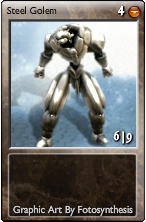 |
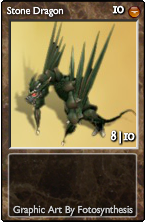 | Stone/Basalt Dragon OK, another dragon, cool. Stone... so vague. Another word for 'rock'. Basalt is a rock. Geological question: what is a rock? Answer (wiki): "any naturally occurring solid mass or aggregate of minerals or mineraloids." (Check back for the definition of mineral to Purple Dragon.) There are 3 types of rock: igneous, metamorphic and sedimentary.* Basalt is an igneous rock. More than 90% of all igneous rock on Earth is basalt.** Other planetary bodies, like Venus, Mars or the Moon also contain a lot basalt. It has a Mohs hardness of ~6. Its name also shows this hardness: 'basanites' in Latin means 'very hard stone'. With a misspell it turned into basalt. Basalt is good for making cobblestones,statues and can be used in construction. Also a very good thermal insulator, stone wool is gained from basalt. Admit it, you were thinking something like "hard rock, blues rock and folk rock". :D A close-up photograph about basalt showing its constituent minerals: https://upload.wikimedia.org/wikipedia/commons/c/c5/%D0%9C%D1%96%D0%BA%D1%80%D0%BE%D1%84%D0%BE%D1%82%D0%BE%D0%B3%D1%80%D0%B0%D1%84%D1%96%D1%8F_%D1%88%D0%BB%D1%96%D1%84%D0%B0_%D0%B1%D0%B0%D0%B7%D0%B0%D0%BB%D1%8C%D1%82%D1%83_%D1%96%D0%B7_%D0%B7%D0%B0%D0%BF%D0%BE%D0%B2%D1%96%D0%B4%D0%BD%D0%B8%D0%BA%D0%B0_%D0%91%D0%B0%D0%B7%D0%B0%D0%BB%D1%8C%D1%82%D0%BE%D0%B2%D1%96_%D1%81%D1%82%D0%BE%D0%B2%D0%BF%D0%B8_%D0%B2_%D0%BF%D0%BE%D0%BB%D1%8F%D1%80%D0%B8%D0%B7%D0%BE%D0%B2%D0%B0%D0%BD%D0%BE%D0%BC%D1%83_%D1%81%D0%B2%D1%96%D1%82%D0%BB%D1%96.jpg A famous basalt formation: Giant's Causeway: https://upload.wikimedia.org/wikipedia/commons/thumb/0/0d/Causeway23.jpg/800px-Causeway23.jpg How rocks get transformed into each other: https://upload.wikimedia.org/wikipedia/commons/7/7f/Rockcycle_edit.jpg | 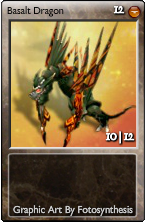 |
 | Titanium/Diamond Shield Titanium is the 22th element in the periodic table. It is named after the Titans (Greek mythology, see above at the Gravity weapon). A low density metal, which is also very strong (Mohs hardness = 6). This makes it a perfect candidate for the creation of lightweight alloys. And the list of good properties doesn't end here: it is highly resistant to corrosion, even in sea water! Despite the fantastic properties most of the titanium ends up as a TiO2 compound, and this boringly looking white material is mainly used as a pigment (possibly the very wall painted in your room also contains TiO2, a lot of white medicaments, and also used in sunscreens as a UV blocker)*. Balance reasons made it cost 4 quanta, but in reality titanium isn't an expensive metal, since Earth is abundant in its ores. Diamond, on the other hand is quite rare. At least, the natural ones. The hardest natural material, with a Mohs hardness of 10. Diamond's name is derived from the ancient Greek word 'adamas', meaning unbreakable/unalterable. Good quality diamond can be pricy as hell, the quanta need of 6 is understandable, even from a scientific perspective. I assume the shield has only a fine layer of diamond, otherwise it would had a stellar price. As rare on Earth, they are quite common in the Universe. Meteorites may contain microcrystals of diamond. It is theoretized that some stars may have a diamond core. Looking at the chemical composition we can say that diamond is only a piece of carbon. The extremely rigid arrangements of atoms in diamond doesn't allow much impurities, though colored diamonds exist, and their color is caused by these impurities. Most natural diamonds were formed billions (1-3.5) of years ago. High pressure and temperature is needed for the formation. Volcanic eruptions were able to bring them to the surface. Oddly enough its sibling, graphite (also consist of carbon atoms) is more stable than diamond. Diamond can also withstand a lof of chemical abuse, too. Though in oxygen atmosphere it starts to burn around 700-800 Celsius degree. (In 1772 Antoine Lavoisier made this experiment, using a lens to concentrate the rays of the sun.) Diamonds has a high refractive index, which - with appropriate faceting together - causes its famous sparkle. Though diamond engagement rings were used by the upper class earlier, its popularity started around 1938-39, when the De Beers company started a huge marketing campaign, convincing people that diamond is the only acceptable gem for an engagament ring. The sales increased a hundredfold in 40 years... Personally, I think diamond is the most boring gem, I find even a simple garnet more attractive. Lots of controversies as well... It is possible that nanosized TiO2-particles can can cause cancer, and because of that it is banned in the EU as a food pigment (E171). | 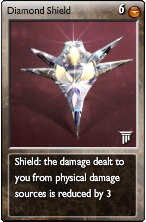 |
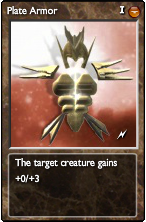 | Plate/Heavy Armor Well, not much science here, nor mythology. The only thing I'd mention that the name of the upgrade is somewhat silly: typical fantasy "let's give it a similar, but 'more upgrade'-y sounding name" approach. In fact plate armors are heavy armors. Maybe using 'Armor' (maybe 'Ring Armor') for normal and 'Plate Armor' for the upgrade would have been a better choice. Another possibility is play around with the type of metal used, since an armor can be made or bronze, iron or steel. Partial plate armor (for chest and lower limbs) were even used by Ancient Greeks from the late Bronze Age. Plate armors has a long history, and they were popular until the 16th century*. Flintlock muskets sorta made them retire, but they still had some significance after that for two reasons. One is aesthetic (it was still cool to pose in a full plate mail for a painting), and the other is to defend against shrapnels (even used in World War II!). I'm personally a sucker for these type of armors: https://preview.redd.it/ls4oq9d3p3s51.jpg?width=1080&crop=smart&auto=webp&v=enabled&p=e&s=9cd1ca2ecb00330ae033091fd88b3b26f80bf655 |  |
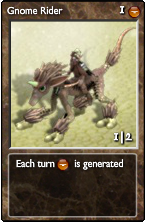 | Gnome Rider/Gemfinder Fantasy stuff: gnomes love gizmos. They also love gems. Somehow, the simple riders here are unable to find gems. Maybe they've just lost their doodlebug*. :) It fits the game's logic nicely that they produce earth quanta, though it is strange only the Gemfinders' name imply this. Anyways: what the heck is that hairy, brown, unicorn-thingie they ride? That's a doodlebug. Its usefulness has never been confirmed. :D https://img.atlasobscura.com/NWjMJdpEi2aeu6SPXIQI80Cv1UEgFUggSxov-b0Qmv8/rs:fill:12000:12000/q:81/sm:1/scp:1/ar:1/aHR0cHM6Ly9hdGxh/cy1kZXYuczMuYW1h/em9uYXdzLmNvbS91/cGxvYWRzL2Fzc2V0/cy81YzgxMGVjNDNi/MDU0OTUzOTdfQWdy/aWN1bHR1cmVfaW5f/QnJpdGFpbi1fTGlm/ZV9vbl9HZW9yZ2Vf/Q2FzZWx5J3NfRmFy/bSxfRGV2b24sX0Vu/Z2xhbmQsXzE5NDJf/RDk4MTcuanBn.jpg |  |
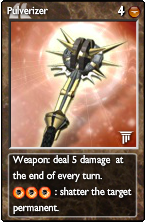 | Pulverizer I like how this artifact works. And such a cool name! A heavy weapon, and it hits - it completely destroys something, while using :gravity quanta*. Again, nice game lore inside logic. (Though a maul would be more fitting than a spiked mace.) There is a real life machine called 'pulverizer'. These are grinders, and can be used for the milling of different materials, for example coal for power plants. It is quite justified if it is a huge item which just passively falls onto something, using only :gravity to make its destructive effect. | 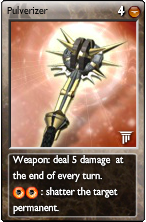 |
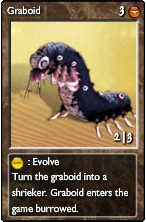 | Graboid/Elite Graboid Everyone loves them grabbies. (What? You don't like them? Man, what's the problem with you??! ;) ) Do you know their origin? The 80s and 90s were filled with so many honest little fun movies, like Tremors. I remember as a kid I had some nightmares after watching that movie, but as and adult I feel it is some light-hearted horror fun, like an 'Aliens' light version, but on planet Earth, and the baddies can travel in the ground, and surprising you from under... you get it. They were called graboids and they are the inspiration for graboids in Elements. In the movie they looked half-reptilian, half-worm, here they look like a centipede. Oddly enough they are out of the sand on the card. With :time they turn into Shriekers and leave the soil fully evolved into a menacing beast. | 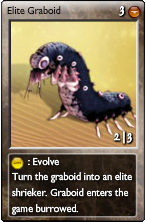 |
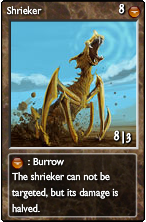 | Shrieker/Elite Shrieker Well, good movies are often doomed to have a less interesting sequel(s)... these sequels featured the shrieker, a type of graboid which is another metamorph of the already known underground tunneling type, and is able to emerge to the surface and travel there... and also attack there... | 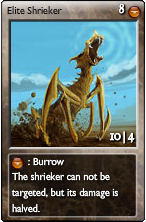 |
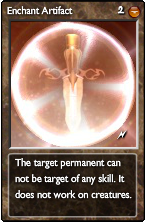 | Enchant/Protect Artifact Standard fantasy thinking (and of course card game thinking): "if there is something destroyable, you must have a protect spell for it!". Hard to explain how a yellow infinite sticker makes the permanents even more permanent. :) But the design of that sticker refers to :time in a cool way! | 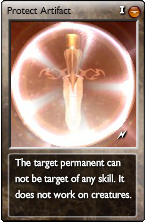 |
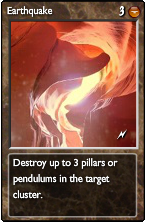 | Earthquake/Quicksand I was always dumbfounded by these names. I mean... how the hell is quicksand more fearful for PILLARS than earthquake? In my opinion landslide/earthquake would have been the way to name these. Let's have a few words about these phenomenons! Quicksand is a disperse system*** consisting of fine granular material (sand, silt, clay) and water. In other words: just a bunch of sand with a lot of water to make it muddy. It is interesting how popular media made them look more dangerous than they really are. OK, I wouldn't want to get in such predicament, but physicist say it is impossible to drown all the way by a quicksand. You can sink like to your chest, but that's it. Though the suction force is huge, one can escape from it using the correct technique. Slow movement of the legs increase the viscosity of the quicksand, accompanied by the rotation of the body helps you to float where you must take a position where your face and torso is facing up. And here is a picture of a crusty bread. :) https://www.melskitchencafe.com/wp-content/uploads/rustic-bread-updated3.jpg https://res.cloudinary.com/teepublic/image/private/s--_aWU5_In--/t_Resized%20Artwork/c_fit,g_north_west,h_954,w_954/co_000000,e_outline:48/co_000000,e_outline:inner_fill:48/co_ffffff,e_outline:48/co_ffffff,e_outline:inner_fill:48/co_bbbbbb,e_outline:3:1000/c_mpad,g_center,h_1260,w_1260/b_rgb:eeeeee/c_limit,f_auto,h_630,q_90,w_630/v1599836090/production/designs/13928893_0.jpg Wikipedia uses the word colloid here, which is a mistake I think, because the dispersed material's particle size must be between 1 and 1000 nanometers which isn't true for quicksands. | 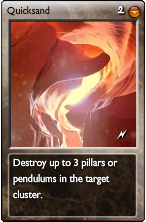 |
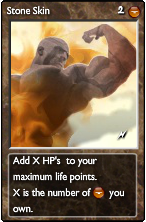 | Stone/Granite Skin Stone skin is a staple fantasy spell. Granite is also a stone - the effect of funky fantasy upgrade names hit again. It has a score of 6 on the Mohs scale, which isn't bad at all, though I can imagine a better name for an upgrade. Diamond was already taken as a flavor for the upped shield. :) But granite is well-known, and easy to associate with EARTH. Granite is an igneous rock (meaning it is created through the solidification of lava) consisting of quartz (SiO2; on average about three-quarter of the mass), alkali feldspar and plagioclase (these two are group of silicates - both consist mainly of Na-, K-, Ca-, Al-, Si- and O-atoms). Granite is an important material of human history, it was and is widely used as a construction material - though ancient and modern uses differ. | 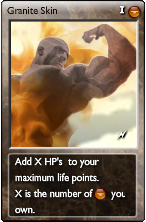 |
 | Basilisk Blood Another fantasy-related spell. I wouldn't call it a staple, though basilisks tend to rear their ugly heads in fantasies and in most cases they petrify their victims (most of the time reversibly) by looking at them or by spitting at them (maybe biting). The origin of the fantasy creature basilisk is very interesting. The word originates from the Greek word basiliskos, which means "little king". This imagined creature has a crown-shaped protrusion on its head, which can be named as a crown, a crest, a diadem, or a mitre. Resembles pretty much to another fantasy creature, the cockatrice. It has a venomous strike, and some versions also give it the ability to breath fire. The monster's weakness is the odor of the weasel. By looking at these properties we can safely say that the legend of the basilisk originated from encounters with cobras. Cobras can maintain an upright posture and we also know that mongooses are able to kill them. (In fantasy games basilisks often resemble huge lizards, especially the Komodo dragon, which also has a poisonous bite, which is fatal for all animals.) | 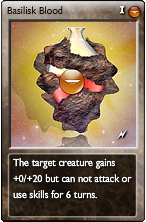 |
 | Iridium/Vanadium Warden It was a conundrum for me. I had to check the properties of these two metals to figure out why these were chosen for these creatures and not other metals, and why Vanadium is the upgraded one. Iridium is the second densest element (22.6 g/cm3), outmatched only by osmium. Has high melting and boiling point as well. Iridium is very resistant chemically, in fact it is the most corrosion-resistant metal known, it isn't attacked by almost any acid. It is a VERY rare metal, only 3 tonnes are produced yearly worldwide. Its name come from the name of the goddess Iris who is the personification of the rainbow in Greek mythology. It has a lot of interesting compounds, which are greatly varied chemically and in color, hence the naming. Vanadium might sound strange for a lot of people, but in fact it is much more common than Iridium in the Earth's crust. It was named after the Scandinavian goddess of beauty and fertility Vanadis (Freyja). The name also based on the fact that vanadium has a lot of vastly different compounds which has a wide range of colors. It is a malleable metal, with a density of 6.11 g/cm3... which means that iridium is almost 4 times denser than our subject. But vanadium is even harder than iridium! There aren't many metals which are harder than vanadium. (That's something the creature's health points represent.) Two metals, a lot of interesting properties: high/low density, corrosion-resistance and hardness (--> guard skill!). I find it interesting that both metals are named after colors*. Two be honest both is good enough to represent the upgraded version of this creature, but I guess vanadium's low density - hardness combo made it winning this one. And maybe its funky name. :) Another example is chromium - d-block metals (the middle part in the periodic table) tend to have a lot of different oxidation states, which results in many colorful compounds. | 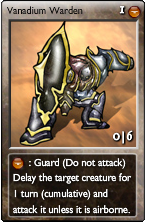 |
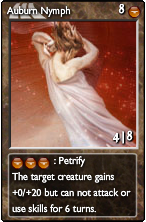 | Auburn/Earth Nymph These girls must have auburn hair. With their touch they can make you hard... I mean... petrify you... :) But you can't do anything for a very long time...* Just telling you before you start wishing for the not-right thing. Having a prolonged erection can be painful. It is called priapism - if it lasts at least 4 hours. By the way: Priapus was a fertility god in Ancient Greek mythology, and was renowned for having a huge boner. (Go, google it. NSFW. :D ) | 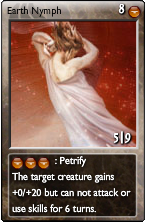 |
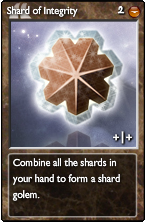 | Shard of Integrity All shards are interesting, and maybe SoI is the most unique shard creating you a specific Shard Golem using your Shards in your hand (all shards 'integrated' into one object). (The mythology of Golem was discussed at Hematite Golem.) Sadly, not much science here, just game mechanics. But using this card can be so satisfying! | 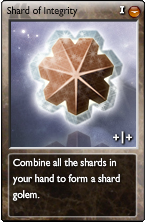 |
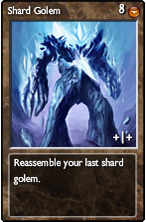 | Shard Golem Out of courtesy and for depicting all elemental cards in this list. Fun fact by Element's wiki: there is no upgraded version for this card (hmm, just look right). Fun fact you already know: damage, life and abilities depend on the combined shards. This creature is a really unique feature of the game! | 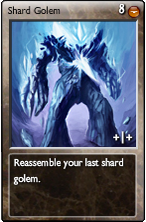 |
Post by: Wyand on May 10, 2023, 10:00:26 pm
:lifebig | LIFE | |
| What is life? The answer will entirely dodge metaphysics, and will focus on natural sciences and will try to put together an exact definition for it. To do that one have to check the commonalities of living systems. But before we do that, let's explore what does :life mean in Elements The Game! Green. The color which is so lovely for our eyes. One of the three main colors of additive color mixing. And it is not just lovely for our eyes: 555 nm is the wavelength* to which our eyes are the most sensitive under daylight conditions. Check the lightest part of the Life Mark: it is that color! Under darker conditions our sensitivity shifts to 507 nm, which is also green, but a bit darker and bluer. But still green, a bit like the darker green of the Life Mark. This is probably evolutionally related to the green color of plants. That color is caused by chlorophyll**, the green pigment of plants. These pigments are crucial for converting the Sun's energy to chemical energy. This color dominates this Element, and it mostly contains green creatures and some life-related positive buffs. My favorite Element :entropy has a strong connection to :life. And not just in this game, but in real life as well. We already talked the relation through mutation, and how entropy wins in the end over life. But here is a little thingie to consider: life wouldn't exist without entropy. Think about diffusion, and think about how diffusion is governed by entropy, how the more probable microstates create a new scenario, a new macrostate***. Living organisms share some common properties. They are separated from their environment (cell wall and/or cell membrane), they have metabolism (biochemical processes) and they are able to copy themselves (mitosis, meiosis, reproduction) to ensure the continued existence of information. They are also reacting to the environment and adapting to it. Long-term adaptation is governed by selection and evolution. All of this happens between certain time boundaries - be it on an individual level, or on a species level. Let's summarize this! Life is an emergent phenomenon of matter, which consist of a collective of cooperating macromolecular structures capable of organizing, reproducing and sustaining themselves by exporting entropy to their surroundings - from which they are physically separated - for a limited amount of time. The difference in efficiency causes a competition both between individuals, populations and species. More about light at :light. :) It is worth noting that yellow-green's complementary color is purple (:death), while pure green's complementary color is magenta (:entropy)... I admire these little nuances in this game... Well done, Zanz! At the same time I don't quite understand why does Life's starter deck contain :fire cards. Lime green and tangerine looks funky together, all right, but not much relation between the two. There is more than one type of chlorophyll molecule, namely chlorophyll-a and chlorophyll-b, and their color is also affected how they are attached to their surroundings (they are bound to protein molecules). Diffusion is a spontaneous process which is caused by the seemingly random Brownian motion of particles. | ||
 | Emerald/Jade Dragon Another normal/upgraded pair which surprises me. Emerald is harder, rarer and more expensive than jade. It also has a nicer, darker hue. If the names would be reversed it would be easy to argue that emerald is much harder than jade and that causes the high hit points of the upgraded dragon. I guess here we just experience a typical symptome of "upgraditis", when the original name got coined without considering the possibility of future card additions to the game. Emerald got its name from ancient Greek 'smaragdos' (they borrowed it from Semitic languages), which means 'green gem'. It is a variety of the mineral beryl (which is a berillium-aluminium silicate by chemical composition), which gets its nice color from trace amounts of chromium (interestingly enough there is a vanadium variant, too, but that is considered as emerald only in the United States). Tha name 'jade' refers to two different minerals: nephrite and jadeite (the previous is a silicate of calcium and magnesium, the latter is a silicate of sodium and aluminium). Jadeite is the more precious one (of course it is the rarer). East, South and South-East Asian art made it well-known. It was also very important for Mesoamerican cultures. Both nephrite (Latin origins) and jadeit (Spanish origins) got its name from 'kidney', because it was believed it helps curing ailments of the kidneys and loins. It can also play dead to evade predators, but the defensive burrowing skill does the same in the game. |  |
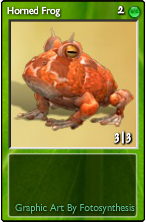 | Horned/Giant Frog It's a frog. With horns. And it is big. The picture resembles to real life horned frogs. There are 3 different genuses. By the looks it seems Zanz - or Photosynthesis - modeled this one after Ceratophrys cornuta (Surinam/Amazonian horned frog). Not just the artwork's color and the horns, but also the skin pattern matches the real life frog. It is a big frog, can grow up to 20 cm. It is a predatory frog, eats fish, lizards, mice and even frogs, too (even other horned frog species, too!). Their attitude shows right after hatching: the tadpoles attack each other just like as a cruel game of selection. These frogs can burrow, which isn't represented in the game. Oddly enough these in-game small, non-poisonous critters deal as great damage as a big graviton mercenary. Also oddly enough the upgraded card doesn't picture a BIGGER frog. |  |
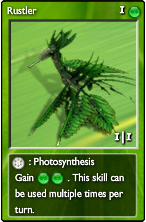 | Rustler/Leaf Dragon The word 'rustle' means "to make a soft, muffled crackling sound like that caused by the movement of dry leaves or paper". The way these creatures work is one of the most beautiful scientic metaphors of the game. They photosyntethise: they use light quanta to create life quanta. Just like in the real world... where plants use carbon dioxide, water and the energy of the Sun the synthesise glucose. The useful by-product is oxygen. Both materials are crucial for living organisms - this closes the metaphor as the newly created :life quanta can summon new creatures to the field. Maybe we can name the upped one Link Dragon, I faced them so many times against Linkcat. :D |  |
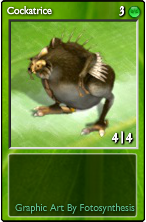 | Cockatrice/Elite Cockatrice As seen before, the history of the cockatrice is linked together with the basilisks'. It seems it was due to a specific translation, before that these creatures existed more independently in different folklores. Though their descriptions and supposed properties were very similar. Both are able to kill people by looking, touching or breathing at them. Both serpent-like. The cockatrice has a rooster's head and a two-legged dragon for body. | 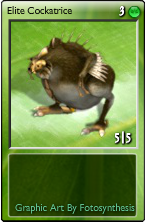 |
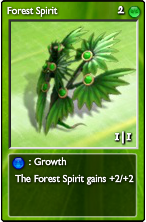 | Forest Spirit/Spectre There are many, many different forest spirits in different mythologies, folklores. I checked dozens of these mythological creatures, most of them are human-looking, unlike this... leaf-creature. Many of them are shape-shifters. There is a forest spirit named 'Archura' in Turkic mythology said to be able to shape-shift to a blade of grass or even to a very tall tree. These different forest spirits often have a ghostly appearence, that explains the 'Spectre' upgrade name. Here it brings another nice real-life metaphor: give water to the plant, and it'll grow. | 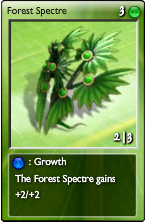 |
 | Heal/Improved Heal Staple fantasy spell, normally linked to druidic magical knowledge. Biologically healing is a self-repair mechanism of the body. Tissues can recover from both physical damage and disease by healing. Sometimes the damaged tissue regenerates (replacement with fresh cells), or just gets a scar tissue replacement (which is mostly collagen, but functionally inferior to the original tissue). The in-game spell speeds up this process. (These 'Improved' cardnames are so strange to me. I mean the effect isn't really improved, it does the same, just for less cost.) | 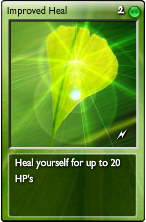 |
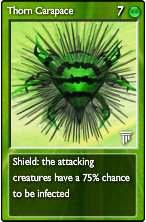 | Thorn/Spine Carapace Let's talk about thorns and spines, because they are entirely different. Botanically speaking a thorn is a modified stem, while a spine is a modified leaf. Moreover thorns are deeply seated, while spines aren't. Most plants' having only prickles, which are the extension of the epidermis (outermost layer consisting only 1 row of cells) and the cortex (the layer under it). For example, roses has prickles. Sorry, they aren't thorns. :) Thorns and spines aren't necessarily poison the user, but they can damage to the skin, and help pathogens and/or garden chemicals enter the body. Most of these diseases are fungi-related. You can imagine how the rose picker's disease got its name... It is sorta strange that the shield itself looks like a mite - except it has 3 pair of legs. Don't know what was the idea. Granted, there are parasitic mite which can cause damage to you, but still... | 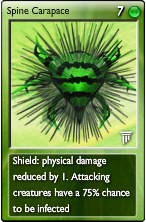 |
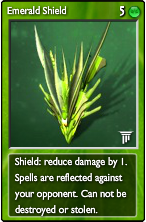 | Emerald/Jade Shield See Emerald/Jade Dragon for these nice minerals. I must add again: emerald is harder than jade, it makes no sense that Jade Shield can stop more punishment. (I must believe that Zanz originally didn't plan for upgraded cards, and he got hit by the "upgraded name disease" again.) OK, jade is more mystical due to certain mythologies and ancient usage. Being softer means also easier to use for example as a sculpting material. | 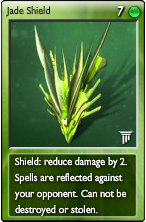 |
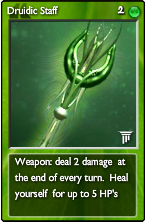 | Druidic/Jade Staff Druids originate from ancient Celtic cultures. They were the "educated" members of these societies, acting as priests, teachers and judges. Their name may stem from a Celtic word which means "knower of the oak tree". Very little is known about them, since they kept no records. Knowledge was transferred orally. One thing is sure, that they played an important part in their society. They were also the organizers of sacrifices - though there is a controversy here, we really don't know much about it (some archeologist think that mass graveyards prove the existence of human sacrifice in their society, some argue that they are monuments for the fallen in war, and most of the written mentions may be just Roman propaganda). The in-game item only refers to the medical knowledge of the druids. The damage is low for balance reasons, though knowing their in role in Celtic culture and society, it could have been more significant. If we accept the human sacrifice hypothesis, this could add an extra skill to the staff, for example damaging own creatures for self-heal (and at the same time no auto-heal when attacking). Druids believed in the immortality and reincarnation of the soul, which also opens a few possibilities for certain skills. | 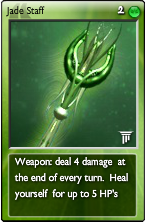 |
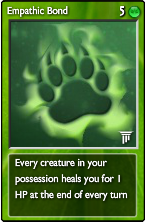 | Empathic/Feral Bond Druids are staple fantasy characters. Here we have Fallen Druids, and this staff. Maybe the Fallen Druid accidentally dropped his staff which has fallen to the ground... Errr... maybe it isn't the druid who is fallen, but his staff? :D A fantasy-themed permanent, with almost zero scientific connection. We could argue that being in a group can reduce stress levels - be it a human individual or an animal - which can have a healing power. If we really try to bring some science here, we must explore the idea of altruism. It is shortly when you help someone, not considering that you might end up with less resources and get into a slightly worse situation. Altruism is something that is beneficial for the group, but can be detrimental to the individual. There are different ideas what brings evolution to select these kind of behaviours, and how an individual decides subconsciously to help someone. It seems that people tend to help those who are closer to them genetically or have some similarity (face, behaviour etc.). If we are altruistic to our group it also means that the group's survival chances has grown. Altruistic behaviour can also show your strength, by signalling that you do have enough resources to help others (and stay strong at the same time). Altruism is also observed in many animal species*. Plants can also signal each other, can recognize kins, which can also be seen as altruistic. In the game there is no individual drawback of altruism, it would be interesting to see something like that, but that would completely change the balance of this permanent. It works perfectly as it is. Many, many years ago read about an interesting observation. (Maybe it was a biology textbook? I don't quite recall it.) This article stated that only members higher on the hierarchy are allowed to share with others, and if a lower ranked member tries to be altruistic with a higher ranked member of the group, the latter simply won't accept the offering. I remember being upset by the "uppity" of the fellow animal, but this behaviour has its reason, because this way the weaker would get more weak, while the stronger more strong, which is bad for the survival of the group. |  |
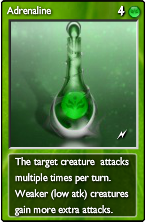 | Adrenaline/Epinephrine The stupidest example for the upgraded name disease. Adrenaline = epinephrine*. They are the same. Totally. Just a different name for the same substance. :D Adrenaline as a word originates from Latin, while epinephrine from Greek. Our body produces a lot of adrenaline when we face some stressful situation. Adrenaline puts our body into a state of alarm. It is called a "fight-or-flight response". In short it readies your body for battle or for a quick retreat. Your heart rate and lung action increases, the same applies to your blood flow for your muscles, blood sugar levels elevate (by breaking down your glycogen** and fat), your pupil dilates, your peripheral vision reduces (tunnel vision - better focus on the danger), mouth dries, digestion slows, face pales or flushes, body shakes. They are both produced by your adrenal glands (situated on top of your kidneys) and your medulla oblongata (to a smaller extent). There is another similar substance called noradrenaline, which has similar functions in the body. An interesting side note is that adrenaline can help in long-term memory in certain stressful situations. This might explain why we remember clearly our worst memories. Adrenaline itself is found in a lot of animals (even single-celled ones), and oddly enough there is a plant which also contains it. You may knew this substance from medical tv programs or movies like Pulp Fiction prior to getting acquainted with Elements. Medically it is used for treating anaphylactic shocks (serious allergic reaction) or cardiac arrests (see PF again). Despite the popular belief it isn't needed to administered into the heart... a simple intravenous injection suffices for the purpose. Regarding our inquiry it is a well done spell, resonates greatly with the original workings of this chemical. The attack power dependence is a nice touch game mechanics-wise, though it isn't necessarily refer to how it works in real life (just think about bears, those huge animals can be deadly quick!). https://upload.wikimedia.org/wikipedia/commons/thumb/c/c2/Epinephrine.svg/512px-Epinephrine.svg.png That's a polysaccharide, a big molecule consisting of thousands of glucose molecules attached to each other. | 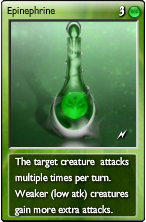 |
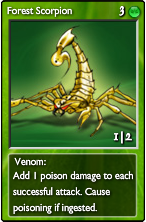 | Forest Scorpion/Scorpion Venom again - which is explained at the Deathstalker. 'Cercophonius squama' is the proper name of the species. It is mostly brown - contrary to the depiction on the card (sometimes it CAN be yellow). It is a scorpion of Australia (the only scorpion in Tasmania). Its venom is far from being lethal. |  |
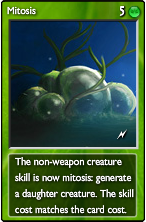 | Mitosis Oh, another beatifully crafted metaphor! There are two different types of cell division: meiosis and mitosis. Meiosis produces haploid gametes, which means that in the divisive process the number of chromosomes are halved in the daughter cells. On the contrary mitosis is a vegetative division, where daughter cells are genetically identical to the parent cells, all chromosomes are kept (diploid cells). Let's pick human cells as examples. A normal body cell have 23 pair of chromosomes. Mitosis produces identical cells with 23 pair of chromosomes. Meiosis produces cells with only 23 chromosomes, which means only one constituents of those pairs get into one cell. Mitosis itself has different phases. If you think about it division is a very important process of life, I'd say this is one of the defining attributes of living organisms that they are able to copy themselves. With each division the telomers shorten. These are the protective sequences of DNA at the end of the chromosomes. To our current knowledge these shortenings play a great role in aging and our lifespan. Ironically enough cancer cells do not have this shortening mechanism, this makes them "immortal", and they can divide "forever" (at the expense of other cells in the body). For single-celled organisms mitosis is the way to reproduce (asexual reproduction, since it doesn't need gametes, and the whole of the chromosome set gets doubled).* Normal body cells of multicellular organisms (like us) are often mitoting, leading to growth, development, replacement or regeneration. It is an interesting question in biology that why the heck does sexual reproduction even exist? Sure, the process can be pleasant for certain species, but evolution isn't famous about letting mechanisms slip by just because they are considered fun. Sexual reproduction has a double drawback. Cinema and dinner. Seriously: the different genders must seek out each other AND one is only admitted to transfer the half of its genetic material. The first poses a spatial and logistic problem, the other is a game theory problem, where you have to sacrifice a bit of your advantages. So why does sexual reproduction exist? Asexual reproduction in an unchanged environment is just enough, because producing the same genetic material again and again doesn't have a drawback. Plus more offsprings are created by that way. In a changing environment sexual reproduction have an edge, because it can give more variations to offsprings, thus a greater chance to adapt to those changes (and also probably suppressing some deleterious mutations). So, this is the great advantage of sexual reproduction, creating greater variety. This notion doesn't fully answer the question, so it stays as a big question, a major unsolved problem in biology. But consider this: entropy agrees with a greater variety... A mesmerizing video about mitosis. https://upload.wikimedia.org/wikipedia/commons/6/62/Mitosis_Mesenchymal_Stem_Cells.gif |  |
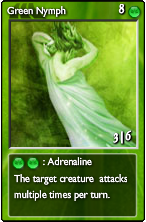 | Green/Life Nymph These girls secrete an interesting pheromone which turns on everyone completely. When turned on these influenced creatures are able to sedate their (and of course the nymph's) urges very quickly, say they become on par with bunnies. :D Smaller guys get a larger speed bonus, while more corpulent fellows gain only a slight increase in pace. :D |  |
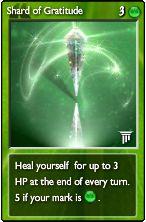 | Shard of Gratitude This card was one of the first shard, so it was buyable. We can interpret it as a "thanks for paying for the game"-card, hence the name 'gratitude'. But it also fits the :life environment, where if you feel gratitude, you are rewarded. (In this case with regeneration.) |  |
Post by: Wyand on May 10, 2023, 10:00:41 pm
:firebig | FIRE | |
| What is fire? It is taught everywhere that 3 conditions* are needed to coexist at the same time and place for fire: suitable material to burn, oxygen as the other reagent to oxidize the previous material and an ideal temperature for the phenomenon to happen. This temperature differs for each material (for solid materials even the surface area available matters!). Understandably ancient cultures looked upon fire as a mythical phenomenon, as a basic element, building block of the Universe or a god or goddess to hail. The ancient Greek philosopher Heraclitus revered fire as the primordial element. Oh, and staying in ancient Greece: the well-known story of Prometheus tells us how the fire has been stolen from the Olympian gods. The usage of fire is a distinct feature of humans (and hominins). (Animals try to evade fire - though they aren't terrified of fire as previously thought.) Cooking, tool and weapon making, art and ceramics, artificial heating and lighting, social development - just to name a few things which were enabled and/or improved thanks to the taming of fire. From the first time we started controlling fire had to wait about 1-2 million years - and arrive into the second half of the 18th century - to truly understand this everyday phenomenon. It is "just" a chemical reaction - more precisely an accompanying phenomenon of it. Although the element oxygen was discovered by Priestley and Scheele, but Lavoisier was the first correctly explaining how combustion works, the role of oxygen in this type of reactions. He also coined the name 'oxygene' which means literally 'acid producer'**. It is also interesting to add that not just oxygen, but other strong oxidants, like chlorine or fluorine can start a fire in presence of a suitable fuel. The flame itself consists of different gases and other intermedier products - depending on what was the fuel. The color of the flame is also dependent on the fuel, the fuel:oxidizer ratio and other reactants/additives***. If the temperature of the flame reaches a certain point it can be considered a plasma (a state of matter in which we can find free electrons and ions). We can consider the flame as the visible portion of fire, since the heat emanating from it isn't visible to human sight. A flame has different parts, which are very well visible even in the case of a candle. The hottest part is the thin outer layer, while the yellow part contains a lot of soot (these are glowing from the heat producing the familiar yellow color of the candle), and the dark spot under it doesn't contain any oxygen, so no burning happens there (just breaking down of the molecules due to heat). The candle's flame can be considered a (not pure) black-body radiation. You can observe similar parts of the flame in case of a Bunsen burner or a kitchen stove (although the flame is mostly blue due to having more oxygen; both are being premixed flames). The temperature of the flame also varies: a candle's temperature can reach 1000 Celsius degrees, while a common oxy-acetylene welder can produce up to 3500 Celsius degrees. An oxy-dicyanoacetylene**** flame can reach about 5000 Celsius degrees! Interesting stuff: when a liquid material gets oxidized (i.e. you see alcohol burning) it isn't the liquid which burns, but the layer of vapour above it. The same is true for a candle or wood. Thanks to the great surface of the wick and the heat the paraffin evaporates and only the gaseous form starts burning. When you see wood burning in fact they are the gaseous thermal decomposition products which are burning (check a piece of burning wood closely, it seems as if the flame is hovering). Even metals can catch fire, a notable example is magnesium - guess many of you know its blinding white flame from school*****. Often a 4th prerequisite is added - turning the fire triangle into a fire tetrahedron - the possibility of a chain reaction by having a great enough rate of rapid oxidation. The previous theory for combustion revolved around a strange fabricated material "phlogiston". The theory was pretty complex, because its usage didn't really explain everything relating the combustion of different materials, so they had to figure out strange explanations for every occasions where some contradiction appeared. Certain metals or metal salts can add beautiful tint to a fire. For example sodium creates a pure orange-yellow flame, strontium a bright red flame or barium (or copper, or boron esthers) a beautiful green flame. https://en.wikipedia.org/wiki/Dicyanoacetylene#/media/File:Dicyanoacetylene_Structural_Formula_V2.svg Magnesium fire is a hard-to-extinguish, dangerous one. Magnesium readily reacts with water at high temperatures, so using water is a major no-no (hydrogen is also produced this way causing extra fire and explosion risk). Another option would be carbon dioxide, but magnesium loves oxygen so much, it just removes it from CO2 as well making this option non-viable as well. Fire prevention says we should cover burning magnesium with dry powder such as sand... problem is that magnesium CAN react with SiO2, too... Best option is using common salt (NaCl) to lower the mood of this easily excitable fellow. | ||
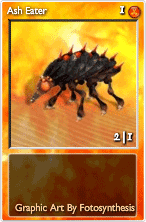 | Ash/Brimstone Eater Brimstone is an older name for 'sulfur', it means 'burning stone'. It is a bright yellow, crystalline solid material, which can be often found in volcanic areas. It wouldn't be smelly on its own, but elemental sulfur is always accompanied by some bacteria which can produce a nasty smell. (Internet likes to cite hydrogen sulfide which smells like a brutal fart, but in fact it is sulfur dioxide, which is just simply pungent - just like the smell of all of my sulfur specimens). It is an essential element for all life, can be found in lots of biologically important compounds (amino acids, vitamins, cofactors). The disulfide bonds are extremely important regarding the structure of many proteins. Penicillin molecules also contain a sulfur atom. Also important for making vulcanized rubber from natural rubber (latex). It is also a main constituent of black powder. In alchemy it was a very important material, it even had its own alchemical symbol. Chinese alchemy used 'sulfur' as a property name: it represented 'yang' (masculinity, daylight, light, dryness) and non-metallic properties as well (brittleness, combustibility and volatility). (You can figure out that the opposite was 'yin' and 'mercury'.) This notion got transferred to Arabian alchemy which popularized it (and got into European alchemy as well). Oh, and ash... is just the solid residue of certain burning processes. Different materials leave different ashes. Wood ash is quite alkaline can be used as a disinfectant or as a starting material for obtaining a strong lye. It also contains some unburnt organic matter and coal as well. And why does the Brimstone Eater produce :fire quanta (opposing to Ash Eater)? Let's say you can burn sulfur - which isn't completely true for ash. This creature is the sole reason why it would be fun to create a "pr0n cards in Elements" thread. :D | 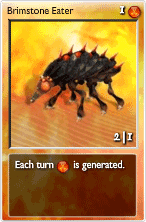 |
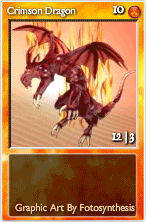 | Crimson/Ruby Dragon Just dragons. Though ruby is interesting from our perspective. It is the brethren of sapphire, because it is also a variant of corundum (Al2O3). It means it also has a high hardness (9 on the Mohs-scale) which isn't really represented in its properties. Ofc it can cause some nice damage, but with that 2 hp it is a really squishy creature. Ruby has a beautiful hue which can range from light pink to blood-red. Its name also comes from this fact (latin ruber means red). The color is caused by chromium impurities. Crimson is a rich, deep red color. Originally it was meant for the color of the kermes dye produced by an insect. (Don't mix it up with carmine, that pigment is produced by another insect. :) ) |  |
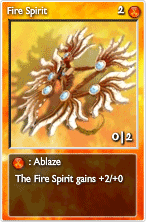 | Fire Spirit/Spectre See Forest Spirit. The only difference that this creatures grows by fire - understandably. Fire can be self-sustained if there is enough material to burn. There was a cute Hungarian child show about a fire spirit causing trouble everywhere to teach kids about the dangers of fire. https://snitt.hu/system/covers/big/covers_19419.jpg?1617129583 https://nlc.p3k.hu/uploads/2018/01/trombi.jpg https://musor.tv/img/fb/72/7299/Trombi_es_a_Tuzmano_I_.jpg |  |
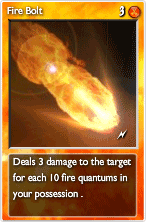 | Fire Bolt/Lance Fantasy staple. The equivalent of hurling something burning towards someone. More :fire quanta = greater damage - we can say that more burning stuff means more damage and/or energy released. In this occasion I like the chosen name for the upgraded counterpart, it really has some edge over the original. | 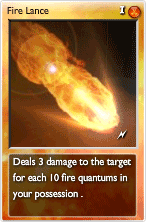 |
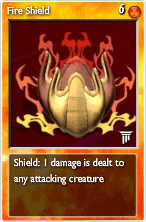 | Fire Shield/Buckler Another often used thing in fantasy games, though most of the time it is either a spell or an ability, not an item. Logic is simple: if you touch fire, you get burnt. | 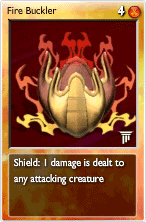 |
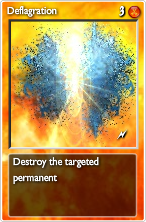 | Deflagration/Explosion Being the nit-picker I think 'explosion' should have been 'detonation', but to be honest it is something I wasn't aware until a long time (had to look up exact definitions). Besides, explosion sounds better, differs more in tone from the unupgraded spell. What is deflagration? It is when you have a moving flame front, which propagates by transferring heat and mass to the unburned air-vapor mixture ahead of the front. The combustion wave is subsonic, meaning it travels less with than 340 m/s. I bet you saw youtube videos which depicted a big 19 liter water bottle filled with alcohol vapor (and air), which after ignition showed a nice blue flame front travelling downward the bottle (often accompanied by a 'woosh!' sound). Now you have a picture about what is deflagration. Detonation happens when the flame velocity reaches supersonic speeds (definition says above 600 m/s, which can even raise into the ~2000 m/s range). Detonation also creates a shockwave in front of it. Certain chemicals are more likely to detonate, for example hydrogen, ethylene or acetylene (this last one can cause brutal explosions).* Using real life logic detonation should destroy accompanying permanents, too (with a certain percentage of chance), but that would make it all too powerful. Let's assume Zanz really meant explosions. Explosions are not necessarily detonations. Let's say explosions are the bigger set and one of these subsets are detonations. Using this logic subsonic explosions are deflagrations, supersonic explosions are detonations. (Now I really think Zanz meant 'detonation', but 'explosion' simply sounded better.) By definition explosions are rapid expansions in volume accompanied by huge release of energy usually through heat and high-pressure gases. The word's etymology is funny. Classical Latin 'explodo' meant "to drive an actor off the stage by making noise". Some 2000 years was needed to transform the word into its current meaning. I remember when at a chemistry lecture it was shown to us the power of acetylene. They detonated only a small bag of acetylene (about the size of a small balloon), but we felt the shockwave from ~6 meters... and we were also shielded by a big table! | 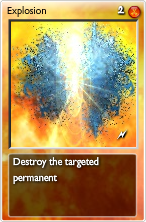 |
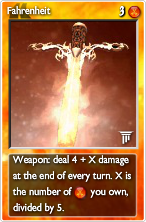 | Fahrenheit Oh, boy. The Fahrenheit scale. Obviously, the name Fahrenheit sounds cool, but the science behind it... When I explain to kids the different temperature scales I always mention this as a horrible and/or amusing example. I don't want to badmouth Herr Fahrenheit, because he made some nice groundbreaking stuff, like inventing the mercury-in-glass thermometer. But how the hell can a scientist come up with such a janky temperature scale? It was the first standardized scale, he must have the credit for it, but the basis was pretty strange. The zero point was determined by a mixture of ice, water and ammonium-chloride (or sea salt). It was measured by his self-invented thermometer, obviously the height of the mercury in the glass capillary became the zero point. The second point was the average human body temperature (96 degrees). The third point was marked by the melting point of ice (32 degrees). Pretty strange and overcomplicated. His motivation was to exclude negative numbers from his scale. Why did he used that strange mixture for its 0 point? Because that temperature (-17,8 Celsius degrees) was the coldest measured in his home city, Danzig (today: Gdansk). A VERY subjective scale. Celsius' work is much more elegant (using water's melting and boiling point for the definition of 1 degree), no wonder it became the standard. We must add it is still a bit subjective, because the pressure must be atmospheric. That's why the Kelvin scale is the best - that's the absolute temperature (also called thermodynamic temperature), where the 0 point is unreachable - per definition*. And at this point we can finally discuss what is temperature. Particles are constantly moving. They have an average energy. At higher temperature they move faster, at lower temperature they move slower. This is also true reversed: when they move faster the temperature gets higher, and when they move slower the temperature gets lower. At absolute zero most of their movements are ceased, they have no transferrable kinetic energy, and only quantum mechanical effects and movements stay - the so-called Zero-Point Energy**. Shortly thermodynamic temperature is related to the kinetic energy of atomic free particle motion. And obviously: cranking up the heat (:fire) means more damage to your opponent. This is the third law of thermodynamics. You can approach it indefinitely, but never actually reaching it. The current record is 38 picokelvin (0.000000000038 kelvin). Here we relate again to entropy. The Boltzmann constant (kB) expresses the relation of the average relative thermal energy of gas particles with its thermodynamical temperature. Its dimensions are the same as entropy's: energy divided by temperature (J/K - no, not 'just kidding' :D ). The exact value is 1.380649*10^-23 J/K. This constant is also in the statistical expression of entropy: S = kB * ln W. Oddly enough the constant was calculated first by Max Planck, but got named after Boltzmann due to he was the first to link probability with entropy. | 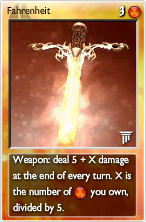 |
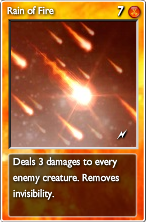 | Rain of Fire/Fire Storm Well, let's try to shoehorn some science here? A rain of fire can happen in case of a volcano eruption. A fire storm can be created by a wildfire and a storm/hurricane together*. A volcanic eruption can be explosive... or not. It depends on the composition of the magma. Thin magma releases gases more easily, so it just flows out of the volcano. Thick magma on the contrary cannot easily release gases, so the pressure builds up which results in a violent explosion. The ejected material - its size can range from ash to huge boulders - is called 'tephra'. Let's define firestorm more precisely: it is a conflagration which creates and sustains its own wind system. Usually it is a natural phenomenon, though aerial firebombings can cause it as well (many, many examples in World War II :( ). The cloud itself named pyrocumulonimbus - the 'pyro' affix shows it was created above a source of heat (which causes an upward movement of hot air due to buoyancy). In lucky cases it can extinguish the fire which caused it - unlike the in-game spell, where firestorm literally means multiple fire bolts hurled from above. In most cases it makes the situation worse, and helps spreading the fire (via winds, thermal radiation etc.). You can see a special, wonderful example in The Powerpuff Girls S04E08 Forced Kin. :D | 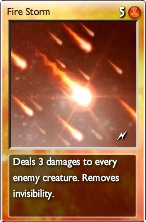 |
 | Immolation/Cremation These words exactly tell what will happen to the subjects of these spells. Immolation is a word for death by fire type sacrifices, while cremation happens with already dead 'recipients'. Hard to explain scientifically why does a simple burning give us the same amount of resources like a nova, plus a large amount of fire... (Of course the human body contain lots of different elements, but their percentage is largely different.) We must deal with the fact that it was much more of a game balance choice. |  |
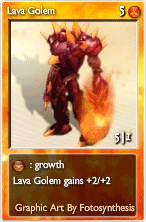 | Lava Golem/Destroyer I strongly think Zanz meant 'magma' and chosen 'lava', because it is a more well-known scientific term. Some may argue that the two terms are equivalent. Basically, it is the same material, yes. It is called magma, when it is beneath the surface of the Earth. It is called lava, when it escapes the bellies of Gaia and starts flowing on the surface (or flying in the air - temporarily). Why do I bother about the difference? Observe how this creature works: by using earth quanta it grows. That's why I think the name 'magma' would be more fitting, because it grows stronger inside due to the "earth power", then later comes out doing some rampage. Regardless of this small difference in our perspective I think it is another pretty metaphor. Magma compositions can greatly differ. Most magmas contain a high amount of silicon and oxygen atoms. (In form of silica or silicates.) Other prevalent elements are iron, aluminium, magnesium, calcium. Viscosities (which defines how does it flow) vary a lot. It can also contain different gases, especially water vapour. Temperatures of lava can range from 500 to 2400 Celsius. Fun fact: if you happen to fall into magma, you won't submerge, because our density is about the half or third depending on the type of magma. So, you'll just burn alive on the surface, partially submerged... |  |
 | Rage Potion/Elixir This is just another fantasy thingie. Some players doesn't even need such a potion to enter a state of Rage. :D Several biochemical changes happen in the human body in this state. Adrenaline production is enhanced, that's for sure. It is hypothesized that the first step is that our hypothalamus produces a lot of oxytocin, vasopressin and a tropic hormone (no, not sunshine and beach) that makes our pituitary gland releasing another tropic hormone which makes our adrenal cortex producing said hormone (adrenaline) and similar ones. A nice line of dominoes... As you can see it, rage is very much linked with adrenaline. But the mechanism here is different, it really makes you defenseless (or having less defense) when using it. Rage also can be helpful. It can help you focus by sharpening senses, raising strength and endurance and dulling the sensation of pain (be it a physical or a mental one). It is thought that a small amount of adrenaline can be beneficial in maintaining a good memory. (Of course high doses can have the opposite effect.) If you have problems containing your rage a cognitive therapy might help. If you are happy with short-term (half-)solutions, a rage room might come in handy as well. | 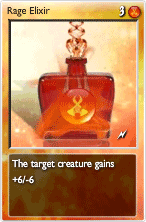 |
 | Phoenix/Minor Phoenix Oh, the ancient magical bird which resurrects from its ashes! Mythology again, from Greece, maybe with Egyptian roots. The etymology itself is too long, let's mention only that maybe it has some connection with the plant Rubia tinctorum (madder) which has a red dye. It would be fairly logical, looking at the usual colors of the bird. Hard to figure out what was the origin of this fantasy bird, because different descriptions tend to visualize it differently. Sometimes it is compared to a rooster, sometimes to an eagle, sometimes to a peacock and sometimes to a golden pheasant. There isn't even a consensus about its size or coloration (only modern fantasy tend to paint it fiery). It was surprising to me to find these conflicting informations. There are analogues in different cultures, an example is the Slavic firebird. Not surprisingly the phoenix was favored in heraldry and still favored as a symbol due to the underlying positive metaphor (renewal - especially the Sun's, resurrection etc.). Also it is the first appearence of 'kid creatures' a. k. a. 'minors'. :D Less cost, less damage, disappearing from the field after 8 o'clock*. :-) |  |
 | Seraph Understandably fantasy games have two favorite sources: Greek and Judeo-Christian mythology. Angelic beings often represented in fantasy games. Sometimes they are on the good side, sometimes they are evil. But we must have them rather on OUR side. The hebrew word 'saraph' means 'burning', though it is also used to describe a 'fiery flying serpent'. In the Jewish angelic hierarchy they are in the fifth rank (out of ten), while in Christian they are in the highest rank. It is thought that the image of the seraph has roots in Egyptian mythology as there were periods when Israelites borrowed a lot of Egyptian motifs. The third Abrahamic religion, Islam also has angels which can be identified as seraphim (plural of seraph). Thomas Aquinas has an interesting explanation about the fiery nature of these angels. He argues using 3 arguments. Firstly: fire moves upwards, showing that they are moving towards God. Secondly: the active force is heat which is penetrating everything and reaching even the smallest of things and cleansing them with their heat. And thirdly: fire is bright, showing that these angels have the inextinguishable light, and they perfectly enlighten others. Nice reasoning. To summarize all this: seraphim are fiery angels (fliers who ignore the shield Wings) who knows how to pack a punch to unbelievers (-10/-12 to our opponents' hp) able to defend themselves (divine shield). They truly have a place between the cards of the element Fire. When I hear the word 'seraph' an old game, Heretic II comes into my mind instantly. | 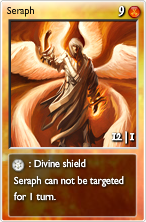 |
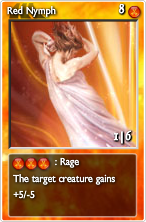 | Red Nymph You know, this is the type of girlfriend who screws up your mind so much, that you even might hurt yourself in your Rage. Sometimes you even wonder if they are only annoying you so much to have that fiery make-up sex after the quarrel... (Understandably you'll get drained, and you'll be in need of a Light Nymph... but let's come back to this later.) | 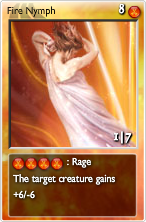 |
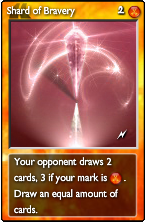 | Shard of Bravery The notion is that you must be brave to toy with rng. Because you might get good cards quickly, but that can be true for your opponent as well. You are playing with fire... Also, if you remember, a proper fire is a chain reaction, the inner working of this card shows that perfectly. |  |
Post by: Wyand on May 10, 2023, 10:00:59 pm
:waterbig | WATER | |
| A classical element. The famous words 'Panta rhei' (='Everything flows') are assigned to Heraclitus. Though it isn't recorded nor proved he said exactly this, but his philosophy based on the continuous change of things, he explained the Universe as an ever-changing, renewing stream. He was only partially true1. Earlier I mentioned the concept of 'archai'2. Thales thought water is the archai, the principle of all matter. Today we know that it is 'just' two hydrogen atoms and an oxygen atom glued together by covalent bonds (shared electron pairs). H2O. It is understandable that water seemed a fantastic material3 to the people of ancient cultures: a material which flows, changes it shape. And yes, water is a fantastic substance. It has a lot of crazy properties (relatively high melting and boiling point, high enthalpy of evaporation, high surface tension, capillary action etc.), all of them can be explained by its relatively strong hydrogen bonds. You could make a 2 hours long lecture about water and still have enough interesting material to make 10+ more lectures about it. Look around! Water is everywhere! Rivers, lakes, seas, rain, snow, clouds, ice... our body is a big, gelly blob, containing at least 55% water (depending on body size and age). It is basically colorless, but a blue tint gets visible as the amount gets greater4. Pure water also doesn't have a taste. Tap water's pleasant taste is caused by Ca(HCO3)2 and Mg(HCO3)2, which are chemically extracted by the slightly carbonated rainwater from limestone mountains. The fact that all 3 states of matter of water is present on our planet can be explained that Earth's average temperature is very close to water's triple point5. It is also worth noting, that pure water contains more than just simple H2O-molecules. Firstly, water molecules are capable of doing an almost black magic like thingie: to give a proton to another water molecule. This creates H3O+ and OH- ions in the water making it very slightly electrically conductive. Secondly, hydrogen has 3 isotopes (protium [1H] 1 p+ in the nucleus, deuterium [D, 2H] 1p+ and 1 n0, tritium [T, 3H] - 1 p+ and 2 n0), and oxygen, too (16O, 17O, 18O)6. This results in 9 different water molecules, "normal" water (1H216O) being only one of them - but this makes up more than 99% of water. Probably you heard about heavy water, which is D2O, or semiheavy water, which is HDO. Oddly enough heavy water can be lethal to biological systems at concentrations over 50%, because it affects enzymes, hydrogen bonds and cell division. Heavy water has its industrial usage, for example it can act as a neutron moderator in nuclear reactors. About 71% of Earth is covered by water. But only 2.5% of our water is freshwater to drink. 10 billion tons of freshwater is used daily. The biggest user is agriculture: more than 70% of this water is used by them. The Virtual Water usage by an average person is about 4000-5000 liter. But what is Virtual Water? Every item needs a certain amount of water to produce. There is a 20 liter water consumption in the making of a single sheet of paper (A4). You need about 15,000 liter water to produce 1 kg beef! (It is worth looking up similar data, you'll be surprised!) These numbers add up to form your personal Virtual Water need - depending on your daily consumption. (A side note: fruits and vegetables need MUCH less water for their production than different types of meats.) It is almost incomprehensible how many uses water has! Drinking, washing, using for heat exchange (steam, water), producing electricity (hydroelectricity), solvent, fire extinguishing, food processing (boiling, steaming, simmering), recreation... people even lick coloured and flavoured ice for fun... :) The first mirror ever used!7 Not just prevalent, but omnipresent and VITAL for life... no wonder even religions incorporated the usage of water for ceremonies8. The Water of Life is present in many myths and religions9. Indeed, water is crucial for life, not just for hydrating your body, but life made its babysteps in a watery solution some few billion years ago10. Things tend to change only until the maximum possible entropy is reached. For a closed system it can be reached sooner or later (in most cases quite quickly), and to our current knowledge with many, many eons later the Universe might come to a halt, reaching thermodynamical equilibrium, maximum entropy, a system without further macroscopical changes. I mentioned earlier that Ancient Greeks misunderstood the states of matter as the 4 classical elements. It is strange since they knew that water can freeze and evaporate as well. Maybe I don't quite understand them, but from this they should have really figured out that it is the same matter, just changing its form. I'm pretty sure they found other materials which were easy to melt (example: sulfur), this makes the situation more interesting and more baffling. (Also mercury is known since ancient times, even its name 'hydrargyrum" means 'water-silver'.) Water is my favorite *MATERIAL*. Water is my all time favorite compound, a fantastic material with fantastic properties. There are resources which claim that even a glass of water looks slightly blue to a good observer. According to this there is something wrong with my eyesight, because pure water always seem colorless to me. Triple point is where all 3 states of matter are in equilibrium with each other. For water it is at 0.01 Celsius degree and a partial vapor pressure of 612 Pascal. Isotope atoms have the same amount of protons, but different amount of neutrons in their nucleus. Also think about Narcissus, the mythological character who fell in love with his own reflection, after seeing it in a pool of water. Central/Eastern Europen Easter is lots of fun... at least for boys. We are watering girls on Easter Monday, who in return give us painted Easter eggs. Watering nowadays means the sprinkling of some perfume, but back then it meant... https://i.ytimg.com/vi/vezEd3q5J2o/maxresdefault.jpg much more. :) This wetter custom still exist on the countryside at some places. As a little kid I had the plan to create the Water of Life as an adult... And we haven't even talked about the occurence of water on other planets. I very much miss a real :water vs :fire opposition. Like water should put out fire and fire should melt ice. | ||
 | Chrysaora/Physalia Chrysaoras are a type of jellyfish. Taxonomically speaking it is a genus, which contains 16 different species. Their common name is sea nettle. I must think that the first known ones were yellow, because the name 'Chrysaor' means 'he who has the golden armament'. This Chrysaor was the son of Poseidon and Medusa.* Physalias are strange creatures. They look pretty much like a jellyfish, and because of that one can think that these "units" are single organisms. In fact they consist of very small organisms which work together to create these visible COLONIES. They have a gas-filled bladder and long venomous tentacles. These properties make them easily recognizable. The Portuguese man o'war (Physalia physalis) is the best known example of this genus. Due to their cheapness these creatures are quite liked, both in bows and in death duos. The real-life venomous capacity is nicely done here using death quanta. The only thing I miss here is to somehow differentiate the two, only superficially similar organisms. An idea is to use the fact that Physalias have a nice buoyancy due to their bladder. Maybe Zanz thought that one air synergy (Toadies) is enough for this element. But Physalias have another interesting property: when they get stranded on beaches their venomous capacity can remain potent for weeks or months. This is a good starter idea for a passive skill like "not possible to lobotomize". Strange family... don't forget Poseidon raped Medusa when she was a beautiful women, then Athene turned her into that snake-hair abomination... to prevent such things happening to her again... Greek gods were pretty good in blaming the victim. Just like humans. (That's why I like Greek mythology, it shows pretty much that humans created gods and not the other way around. Every good or bad property is just a human property exaggerated.) |  |
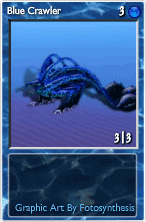 | Blue/Abyss Crawler Just a strange-looking blue creature which makes iancu's heart melt. Cheap and effective creature for bows. Not sure if there is a real life equivalent for these creatures. Starfishes, octopuses, stingrays, sea cucumbers, crabs, sea turtles, some sponges, worms, sea snails, shellfishes, young barnacles do crawl. This one is a deep see crawler (abyss), but reminisces none of them. Seems Zanz wanted to show that deep see creatures might look strange and can possess odd properties (6|6 is quite good for such a simple creature). Some thoughts about the color blue. Linguist were surprised that they haven't found a word for 'blue' in ancient Greek texts. Moreover there is no distinct word for blue in Chinese, Sanskrit or Hebrew. Blue was often associated with other, similar colours like green. Egyptians had a word for blue, because they knew blue pigments. My resource didn't mention it, but my guess would be azurite - they used a lot of different powdered minerals (even toxic ones) for make-up purposes. My other guess is indigo, that's a proper blue dye. (Normally they must have known both. I left my musings here instead of editing out, but later I found that Egyptian blue was another mineral: calcium copper silicate.) Amusingly enough linguist also had the idea that the Greeks might have been colorblind. They had three arguments. First, Greeks often communicated colors as light (glaukos - yellow, grey, light green etc.) and dark hues (kyaenos - violet, black, dark blue etc.). Other argument arose when an Aboriginal tribe was discovered who considered the sky rather black than blue. And lastly, Homer used some strange description about certain things in his work, like calling honey 'green', and sheep 'violet'. Maybe Homer was colorblind? :silly: Or he just liked to use funky attributes? Nevertheless humans have color vision, and all ancestors had it in the last few million years. Let's step back to that ancient pigment, indigo. Many, many cultures* have known this dye, since it was obtained from a common plant, Indigofera tinctoria (true indigo). In fact, the oldest known fabric dyed indigo dated to 6000 years ago, and was discovered in Peru. Greeks also knew this dye. There is something wrong with those linguist arguments, explanations. The sky is blue, the oceans are blue, there are blue eyes and there is this omnipresent beautifully dark blue dye. No way they couldn't perceive blue as a color. The real explanation is more interesting. An experiment with the Himba people (native to Namibia in southwest Africa) helped to solve the conundrum. The Himba people are able to maintain their tradition to live a life entirely cut off from Western influence. They have only five words for colors. They would use the same words for shades for which we have a spectrum of different words. At the same time, being the children of Mother Nature they can differentiate a lot of different green shades, and they treat them as entirely different colors. Scientists showed them two color wheels. One of them featured only light green squares - but one of these squares had a very slightly different hue. They easily picked it out. The other picture also featured light green squares, but with an extra light blue square. They had a difficulty naming the light blue one. But when they were asked to handpick the different square, they easily did it. This shows that they were able to see the color blue, they just didn't meet with it daily, it haven't got incorporated into their language. Languages are formed by experiences. If a group of people sees a light reddish hue often, sooner or later they might create a different word for it: pink. Ancient people saw blue. They might have categorized colors a bit differently, but nevertheless they were able to detect them - we are talking about million years of evolution, that won't disappear magically for certain selected centuries. Peru, India, China, Japan, Mesopotamia, Egypt, Britain, Mesoamerica, Iran, West Africa, Greece, Rome. | 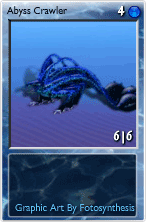 |
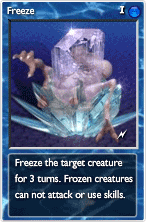 | Freeze/Congeal Ever wondered why do we use 'melting points' instead of 'freezing points'? Of course, the term freezing point is used as well, but rarely and only in specific situations. (Like freezing point depression, but that's a bit different topic.) First we must compare melting and freezing. Solid materials have their crystal building particles fixed in place where they can only oscillate (vibrate). Imagine them like little balls connected by springs (metaphor for the bonds between them). The springs hold them in place, though they have some sort of flexibility (the aformentioned oscillation/vibration). Higher temperature means stronger vibration. If the vibrations get strong enough it can break the springs (bonds between the particles). At this moment the solid material melts, and the current temperature is its melting point. Stronger bonds mean a higher melting point. For example nitrogen has a melting point of -210 Celsius degree, while water melts at 0 Celsius degree, and wolfram melts only at 3422 Celsius degree. So what's the difference with freezing? It must be the same - just backwards - right? Well, nope. When we have a liquid and we cool it down it won't necessarily freeze at the melting point. Crystal formation is a tricky process. Logically we would expect that as particles get closer and closer, because of the weaker vibrations, bonds start forming, and voila: freezing. Thing is that first a nucleation must happen: there have to be a starting point where the crystal can start growing. If the liquid already contains a piece of solid of the same material then it'll happen quickly. If not, we must wait, until the particles collide in the correct orientation and a nucleus forms (the "starting" crystal). From another perspective: there is an energy barrier when we move from liquid state to solid state and because of that energy barrier the crystallization happens often below the melting point. The phenomenon is called supercooling. For example water can be supercooled to -40 Celsius degree before freezing. (It is an experiment which you can try at home. Won't be successful all the time, but sometimes when you put a plastic bottle full of water into the fridge it won't freeze, but when you remove it, disturb it a bit, it freezes instantly.) So, that's why we use 'melting points', because freezing points are unreliable. Luckily 'freeze' is a reliable enough spell in this game. Though sometimes it is questionable that you can freeze some fiery creatures, plus icy creatures oddly enough doesn't have any freeze immunity. Guess the reason is balance, or it would have been just too difficult to implement something like this (it would have been cool if stony creatures would have got some damage after freezing due to erosion). Congeal is again the "oh my, what synonym should I use for the upped card?"-sillyness. The first meaning of congeal is pretty much the same as freezing. The second meaning works for colloids as well, for example when blood curdles it can be called congeal as well (coagulation). All in all any sort of solidification or thickening can be called congealing. From this perspective it is a strange choice for the upgraded counterpart. | 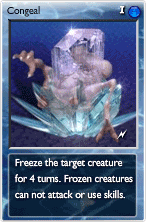 |
 | Ice Bolt/Lance Fire Bolt ice version. It is a very nice touch that they are able to freeze weapons with a certain percentage. (Random Submachine popping up in my mind and starts smiling and saying: "Hey Wyand, do you remember that tournament when my lances froze your weapon in every try?" :D ) Also less damage because of it. |  |
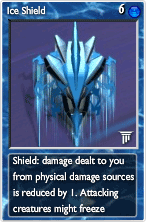 | Ice/Permafrost Shield A thermodynamically supported permanent. :) If you touch something cold it'll draw heat from your body. (See? Heat travels from the hotter place towards the colder place.) It is nice how it got implemented to the game. Ofc an instafreeze shield would have been op, so logically it got its own rng as well. Still a very strong - often underestimated (maybe due to its cost) shield. Permafrost is an upgrade name I like, because it draws your attention to something important (if you have the curiosity - and I do hope you have, playing such a science-based game). Permafrost. 'Always frozen'. By definition, always is about at least 2 consecutive years. The ground must remain continuously under 0 Celsius degree, and it must be on land or under the ocean. Interestingly enough it doesn't have to be the first layer on the ground which is frozen. It can be even several miles deep under the surface. Usually permafrost contains a lot of biomass. Why is it interesting? Because permafrost areas are getting warmer and warmer, and ultimately the overall permafrost areas will shrink. OK, so what - someone might say. Look back a line: it contains a lot of biomass... mainly in the form of methane... Methane is a strong greenhouse gas. And it can create a vicious feedback cycle: hotter days, more methane gets released, even more hotter days... goto more methane... and so on... | 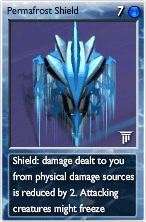 |
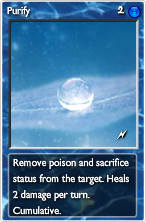 | Purify Oh, the purifying power of water! Such a beautiful and ancient symbol! Water is life. Without food your body might use your reserves and you get to live for weeks. Without water you'll die of thirst within days (about 3 or 4, depending on person and situation). When you go home after a tiring day, it feels so good to have a glass of cold water! You get a small cut: let's clean it with water first! Getting sick or poisoned: water is always good. Water is an elixir itself! People always wanted to create the elixir of life, those fools haven't seen that we already had it, and it is called water! Thanks Zanz for strengthening this beautiful metaphor! | 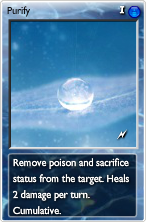 |
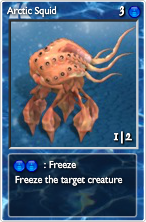 | Arctic Squid/Octopus Two very similar molluscs, though they belong to different subgroups. They are both quite intelligent animals, especially among invertebrates. They can't really freeze targets, but they can grab them with their arms/tentacles - guess that's what brought Zanz to give them some sort of restrictive ability. Needless to say they are op, no wonder they have only 2 hp (though they are much bulkier than a froggy, right?). One thing that puzzles me that squids have 2 tentacles and 8 arms, while octopuses* have only 8 arms. Which is sort of a downgrade. Maybe the Giant Squid was the inspiration (the Colossal lives in Antartic regions), though the card graphic doesn't really resemble to it. Octopi if you like, though I think it is pointless to use Latin plural in English. Quoting wiki. "In shallow-water species of the continental shelf and epipelagic or mesopelagic zones, it is frequently one or both of arm pair IV of males that are modified into hectocotyli.[26] However, most deep-sea squid lack hectocotyl arms and have longer penises; Ancistrocheiridae and Cranchiinae are exceptions.[27] Giant squid of the genus Architeuthis are unusual in that they possess both a large penis and modified arm tips, although whether the latter are used for spermatophore transfer is uncertain.[27] Penis elongation has been observed in the deep-water species Onykia ingens; when erect, the penis may be as long as the mantle, head, and arms combined.[27][28] As such, deep-water squid have the greatest known penis length relative to body size of all mobile animals, second in the entire animal kingdom only to certain sessile barnacles.[27]" |  |
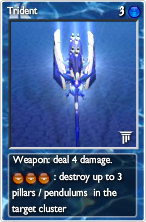 | Trident/Poseidon Poseidon had a trident. Now a Trident has an upped version: Poseidon. Greek god of the sea, storms, earthquakes. No wonder this op little thingy is able to sink your pillars, pends (sometimes even marks, as well). Water can cause some havoc on the land, too, so this is not just a good synergy, but a good metaphor as well. Btw, his trident was made by the Cyclopes. He used this trident to do some practical magic, like creating a spring with a single strike, or doing the opposite: drying out a land. (Not exactly earthquakes, but magical stuff happening to earth.) According to mythical texts the trident symbolizes 3 properties of water: liquidity, fecundity and drinkability. Another source claims it is three-pronged because "the sea is said to be a third part of the world, or because there are three kinds of water: seas, streams and rivers". | 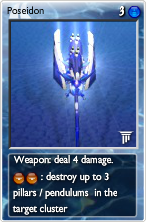 |
 | Ice/Arctic Dragon Upgraded name extravaganza again: something living in the arctic zone is somehow better than simply just being a block of ice. True, ice isn't that hard (Mohs 1.5; you can scratch it with your finger). Considering other solid materials it is quite soft. Also a cold dragon like this should have an ice breath or something, but the freezer portfolio is already taken by those seawater molluscs mentioned earlier. (Somehow I feel Ice Dragons preceded squids, so I don't know why haven't they got such a random property - freezing creatures/weapon with a X% chance.) |  |
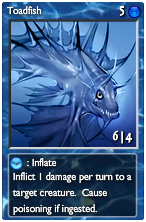 | Toadfish/Puffer Fish There is much, much confusion here. In fact the card picture also looks like a crossover between a toadfish and a pufferfish. What I found that toadfish groups are often named pufferfishes and vice versa... There are different families, though. Batrachoididae are called toadfishes. Most of them are living on the ocean floor (not necessarily in deep ocean, it can be a shore line as well, the emphasis is on the 'floor'). Tetraodontidae family consists mostly of pufferfishes, though some of the species are called 'toadfish', too. And there is the Diodontidae family which are also called pufferfishes, though they are only related to the Tetraodontidae. And lastly there is the Psychrolutidae family, which also has a few species called toadfishes. Many of these fishes are brutally poisonous (they have a toxin named tetrodotoxin* which is 100 times more lethal than a black widow spider's venom). The toxin is produced by bacteria probably acquired by the fish by eating other animals infested with this bacteria. Through evolution the fishes got insensitivity for the poison. Their liver (skin, ovary and eyes too) contain this toxin. There is no known antidote for this poison. That's why you have to remove certain parts of these fishes when preparing a fugu... Pufferfishes are able to inflate themselves, this isn't common for toadfishes... I don't know if Zanz got confused looking up these critters, or just wanted to show the confusion with the mixed look and properties. Gameplay-wise inflate is a nice skill, and it is also interesting how differently works the poisoning for the upgraded creature. https://upload.wikimedia.org/wikipedia/commons/thumb/4/4b/Tetrodotoxin.svg/640px-Tetrodotoxin.svg.png TTX. A nasty, nasty neurotoxin. It is more poisonous than cyanide. It simply blocks sodium channels in animal's nerve cell membranes. Why is it problematic? Because our whole nervous system is built upon the changes of certain ions' concentrations. Sodium ions play a crucial role in creating the so-called 'action potential', without them there is no action potential, thus no messaging between nerve cells, which ultimately will cause the absence of muscle contraction. The victim simply suffocates, meanwhile being absolutely awake. Nasty stuff. | 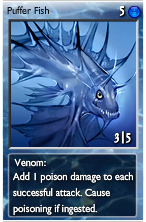 |
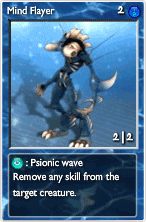 | Mind Flayer/Ulitharid Powerful D&D creatures (they are also named 'Illithids' there). They are able to dominate the mind of other creatures. Or we can say that they have psionic powers (:aether, see later), though in Elements they are "only" able to take away the skill of others instead of true mind control (let's call it mental castration, which is fundamentally different from mental subjugation, domination, abuse). They look somewhat like miniature skinny Cthulhus. :D The elite mind flayers are the ulitharid. | 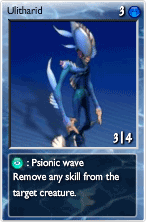 |
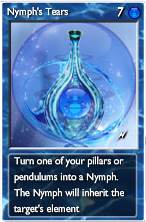 | Nymph's Tears In the Greek mythology Pirene was a nymph, a daughter of a river god. When her son (Cenchrias) was killed* her grief was so immense that she completely turned into tears then into a fountain that still bears her name in Corinth. In another story Atlas' son, Hyas was killed in a hunting accident, and his sisters, the Hyades wept from their grief. (Hyades means 'rain-maker'.) A cluster of stars, the Hyades are named after them, since the myth claims that they were turned into this group of stars located in the Taurus constellation. Though, none of the stories mention something like tears turning pillars into beautiful magical women, they were probably a good basis for Zanz's fantasy. Nymph's Tear is also a component for crafting a magical ring in the computer game Baldur's Gate II: Throne of Bhaal**. ...unintentionally by Artemis. Artemis, and unintentional kills, yeah... In-game flavor text. "Legend holds that Nymphs who die of a broken heart shed crystal tears. This rare gem is as hauntingly beautiful as its name, and lends creedence to the folklore by evoking sorrow and longing in all who view its solitary perfection." | 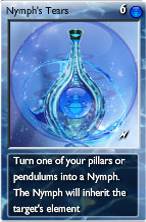 |
 | Flooding/Inundation A small flood which only scares people a bit, can be even "fun". A proper flood isn't fun at all. A nice definition for it states that "A flood is an overflow of water (or rarely other fluids) that submerges land that is usually dry". Both flood and inundation cause the same effect, the difference is that an inundation isn't a sudden natural event, but a planned, man-made coverage of an area with water for agricultural, military or other reasons. If you want to keep up with these, you'll need lots of water (:water). |  |
 | Steam Machine Oh, boy, a little physics! And what a beautiful metaphor created by Zanz again! You have water (needs water quanta to deploy the creature), you boil it (needs fire quanta to make it happen), and voila, you have steam! Which is more powerful than you would have thought! Since the attack always grows when creating more steam, it would imply that it accumulates kinetic energy somehow. Because of this personally I would prefer if the machine would have some limitations, like more and more steam means constantly growing pressure and also damage to the equipment. By definition it is a heat engine converting part of this heat energy into work using steam as its working fluid. The hot steam expands under pressure which pushes a piston back and forth in a cylinder. The remainder of the heat may be allowed to escape (This is what I mentioned before, this is the great difference from this card's operation.) The first documented steam engine was the Greek aeloipile in the 1st century. Most likely it didn't have any practical usages, it was just a curiosity. The first patented invention happened in the 17th century - it was used for pumping water in mines. But later on locomotives, cars and even ships were powered by steam. Steam turbines are still used nowadays. Nuclear power plants generate electricity by heating water (the heat is due to splitting atoms) to provide steam that drives a turbine connected to an electric generator. | 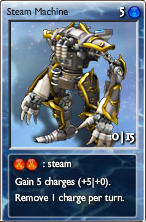 |
 | Dry Spell/Desiccation The first is a long period of dry weather. Not as serious and long as a drought, but still pretty bad. Desiccation is the process of extreme drying. Like when you have some leftover pasta on your plate and you 'forget' to do the dishes for a week. Or 2. (To me it sounds like Abi-Dalzim's Horrid Wilting /AD&D spell/.) Since most living tissue, and a lot of food items are gels, these gels' water percentage can change over time. In this context desiccated gels are considered as xerogels (gels with very low or zero water content). Gels contain a colloid/polymer network which remains after desiccation. Simply put it is a remove water spell, which would fit more rationally to :fire or :death, costing :fire or :death quanta and generating :water. Understandable that balance reasons made Zanz to put it between :water cards. Go check the second meaning of dry spell. :P Something which can be ended by the next card's character. :) | 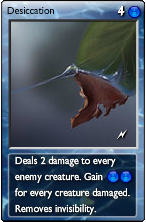 |
 | Nymph Queen Since this is a :water card, we can safely say that nereids (sea nymphs) and naiads (different types of freshwater nymphs) are the closest link in the Greek mythology. Looking at hierarchies, we find that Amphitrite is the eldest of the Nereids, also the wife of Poseidon. She is also the goddess and queen of the seas. To complicate matters there is also Thalassa, who is the primordial goddess of the sea. In a way Thalassa is the goddess, while Amphitrite is her antropomorphic version, the ruler of the elemental Thalassa. (The same is true for the male counterpart, Poseidon/Pontos.) | 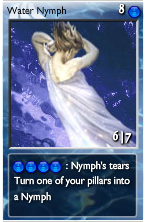 |
 | Shard of Patience Nothing here. You just need a little patience* to get some overpowered creatures. No idea why it ended up here, no connection to water whatsoever. Maybe Zanz thought that water cards aren't beefy enough. The +5|5 for :water creatures might be explained how Zanz must have realizes that instead of helping only water with this card, he helped all other elements as well. The only patience you need is to wait until you get your copy for instawin from your deck.** But I'm getting circular. https://www.youtube.com/watch?v=ErvgV4P6Fzc Or you need patience until your bathtub gets filled with water before having a bath? I'm really lost here. :D | 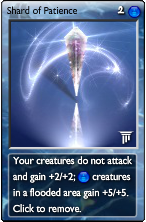 |
Post by: Wyand on May 10, 2023, 10:01:18 pm
:lightbig | LIGHT | |
| Another common phenomenon which wasn't really understood until the modern times. From the 17th century two different theories were vying for supremacy - the corpuscular and the wave - just to got unified by quantum mechanics. Also let's not forget that electromagnetic theory added its ideas to the understanding of light in the 19th century. Summarizing all of this: light is an electromagnetic radiation which consists of photons and can be interpreted both as a wave and as a particle.* If we talk only about visible light then we must add that its wavelength is roughly between 400 and 700 nm. The whole spectrum is interesting, and it might surprise you what sort of other radiations count as light: radio waves, infrared waves, microwaves, ultraviolet waves, x-ray, gamma rays. This order is in increasing frequencies, increasing energies and decreasing wavelengths. The visible spectrum is only a small portion of it. Another interesting property of light is its speed. We usually claim that light is the fastest ever phenomenon. Though the relation is reversed: there is a maximum reachable speed in the Universe, and that's why even light cannot be any faster (special relativity claims it is the upper limit for speed - be it matter, energy or information travelling)**. This limit is 299,792.458 km/s (universal constant, c). No wonder that this element's symbol resembles to the Sun - which is our natural source of light. Most of the outer space light sources - other stars, the Milky Way itself etc. - are too weakened when they reach us to provide any meaningful lighting***. We can find natural light sources on planet Earth as well: fires (even volcanic), bioluminescent creatures (see later), lightnings (see at :aether and :air). Just a short list about a few type of artificial lightings: lamps operating by burning fluids, gas lamps (Bunsen), candles, electric discharge lamps (those beautiful orange-yellow sodium-vapor lamps), LEDs, lasers. As a chemist I just couldn't have omitted the significance of light for our science. Firstly, let's talk a bit about the colour of things****. Photons have different amounts of energy (as mentioned above). Some of these photons are able to interact with certain electrons (exciting them), some are not. If the energy carried by the photon is able to put the electron on a higher energy level then we count that photon as absorbed by the material. If it doesn't have the needed energy, the material will just bounce it back. White light contains all of the different type (wavelength, frequency, energy) of visible photons equally distributed. Some of these photons can be absorbed by a material, some can't. The unused photons are reflected back and that gives the color of the material. Let's take a few examples. Diamond is usually colorless, because it has very strong covalent bonds, which means it is really hard to excite those electrons in the bonds: all of the light is either reflected or simply just transmitted through the material. Graphite is almost black, because it contains delocalized electrons, which means it has a plethora of loosely bonded electrons with different energy levels - these can get easily excited by visible light to different energy levels, which causes a lot of different wavelength photons absorbed. (Some of them get reflected from the surface causing a metallic shine.)***** A red material means that the object was able to absorb every visible photons - except red ones. But photons can do so much more with electrons, not just exciting them! They can also cleave specific bonds, which means they can induce reactions. For example chlorine molecule is very susceptible to this, blue/ultraviolet light can transform it into chlorine atoms, which are very reactive. Both organic and inorganic chemistry uses this. Classic photography depends on a photochemical reaction (2 AgBr -> 2 Ag + Br2). The formation of vitamin D - that's why you need getting exposed to sunlight! And also don't forget photosynthesis where specific chlorophyll molecules absorb red photons to start the creation of glucose (and oxygen) from water and carbon dioxide. And how do we detect light? This is chemistry as well. The topic would be really long to discuss it adequately, so only one thought. The visible region of light have just enough energy to cause excitations within molecules, which causes changes in the bonding of these molecules (retinal). Lower energy light cannot do that, so we cannot see infrared light, while higher energy light is destructive. Of course if you delve deeply enough into physics you might find more interesting and profound definitions. There are cases when a particle can go faster than the speed of light - without breaking the aforementioned rule. When we talk about the speed of light we forget to add that it is in vacuum. Which means that the speed of light is different in different mediums. For example the speed of light in water is "only" 230,000 km/s (0,77c) and 200,000 km/s (0,67c) in glass. So theoretically you can reach higher speeds than light in those mediums (but still obeying the 299,792.458 km/s as speed limit law). In fact charged particles (most commonly and electron) can do that, and this produces a radiation, called Cherenkov radiation. It has a nice blue glow. Underwater nuclear reactors emit this color. The medium must be dielectric (=an electrical insulator, which can be polarized electrically). The Moon and the planets doesn't have their own source of light, they just reflect the sunlight. Also the night sky's apparent dim lights are heavily obscured by artificial light sources, like streetlights. Some meteors can put up quite a light show - these ones are called bolides. Auroras can be spectacular as well. I'm writing about chemical color here. Physical color is different. An example for it is the color of certain butterflies or birds' plumage. These are also called 'structural colors', because it is the result of interference caused by the minute structural pattern of the object (fine parallel lines for example). Peacock's feathers, soap bubbles, opals, the color of the sky - just to name a few examples for those colours which aren't caused by the above explanation in the main text. I know that the explanation isn't full, but it would be pointless to delve deeper into the physics of the topic. A lot of missed opportunities in this element. A really miss a :water :light synergy, like creating a rainbow. Maybe the idea was dropped, because there are easier ways to gain quanta for all elements. Or a :gravity :light synergy, knowing that gravity affects even light. | ||
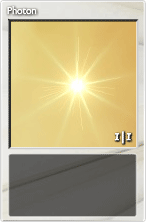 | Photon/Ray of Light As discussed above, photons are the elementary particles of light (be it visible or not, any kind of electromagnetic radiation consists of photons). They are massless and have no electric charge. Other than that they are the force carrier of electromagnetic force. They do have a momentum, it can exert pressure on objects, and we are using that in solar sails. Also worth noting that you can create high-energy photons by annihilating matter with antimatter*. A "Ray of Light" - well, it sounds like a bunch of photons, right? Still, you will only summon one when you play a card ("wooow, creating more than one RoL with one play!" - dtd starts drooling :D ). Hard to find out perfect upgraded names in every game. As mentioned at Antimatter it would be fun to see such thing in Elements, which would create a lot of photons (:light quanta). | 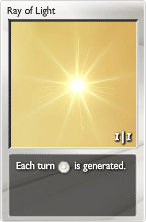 |
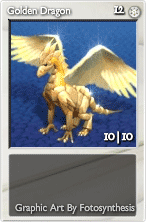 | Golden/Light Dragon Every element has its dragon. All metals are shiny, so choosing gold here was probably because of the age-old alchemist sun-gold metaphor. Though you should know that the Sun only (i)seems(i) yellow - it is because of the Earth's atmosphere, which scatters the Sun's light, thus creating its seemingly yellow color and the sky's blue. (Lower wavelength light scatters more easily, that creates the latter color.) If you would watch the Sun from the space you would see it in its perfect splendor: blindingly white. It is also funny, that the upgraded version called "Light" dragon despite the fact that it is the 2nd fattest dragon (along with Basalt Dragon). :) (Also don't forget that Gold has a whopping 19.3 g/cm3 density! Man, these dragons of Light are quite heavy! :) ) But hey, aren't we forgetting something? Metals are usually shiny grey, why is gold shiny yellow? We must ask Albert Einstein about it, because it is related to special relativity. Electrons have a huge speed while spending their time around the nucleus, and this speed grows with atomic number (the number of protons in the nucleus). In fact, gold's innermost electron has a blinding 0,53c velocity! (About half of the speed of light.) Normally an object's color is defined as described above. For d-block metals this excitation happens with an electron on the d-orbital* which jumps to the next s-orbital. Let's look at silver as a counterpart: its 4d -> 5s transition needs a big amount of energy which corresponds to ultraviolet light, reflects all visible wavelenghts equally and because of that it stays grey, silvery (means visible light cannot excite it, only UV, the result isn't visible to us). The mentioned huge speed for electrons in the gold atom causes a relativistic increase of mass (momentum) of those electrons. Because of this the electron's orbit shrinks, a relativistic contraction occurs. This is especially true for s-orbital electrons, p-, d-, f- and g-orbital electrons are less affected. Now, let's look at gold's orbitals which are liable for the color, the 5d -> 6s transition. Because of gold's massive nucleus the electrons move faster, the 6s-orbital shrinks, gets closer to the 5d-orbital because that shrinks to a lesser extent, and voila, the ultraviolet absorbance (what we saw at silver) shifts into the visible range, to blue color! The rest of the visible light is reflected, a lot of reds and greens which together produce that beautiful golden hue. Let's just agree that orbitals are the special places where electrons reside in the atoms. The letters signify different types (symmetry) of orbitals. In our examples these are the outermost electrons of the said atoms (silver, gold). | 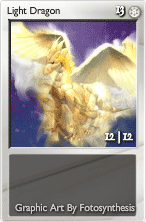 |
 | Pegasus/Elite Pegasus Greek mythology again! The famous winged horse, the brother of the earlier mentioned Chrysaor. Their (unwilling) mother was Medusa, and their father was Poseidon. Oddly enough they were born when the hero Perseus has slained Medusa, cut its head off, from its blood the brothers sprang forward. The hero Bellerophon tamed Pegasus (in other tales Pegasus allowed him to ride him), together they were victorious upon the monstrous Chimera and had many other successful adventures. With each exploit Bellerophon's pride grew and grew, until he thought he is allowed to fly to the Mt. Olympus, to the habitat of the gods. Zeus thought otherwise, sent a gadfly to make Pegasus drop his rider. Bellerophon had fallen into a thorny bush, losing his eyesight and also getting hurt so badly that he also got crippled. The rest of his days were spent lonely and bitter. Pegasus got into the custody of Zeus. In another version (Euripides' tragedy) there is a quite different reason for the hero to visit Mt. Olympus. He loses his faith, because he experienced so many unjust events through his life. In the end he decides to visit Mt. Olympus, but the outcome is similar: both rider and mount fall. Personally, I prefer this version. The first version wants to show the hubris of Bellerophon - ironically enough it shows the mafia-like hubris of the gods. The second version depicts a more sensitive and heroic Bellerophon. Of course, the ending cannot differ - powerful figures can toy with mere mortals quite easily. The card's synergy with air is well-executed: from greater heights one can deal greater damage by diving on the unsuspecting victim. Two more interesting footnotes which could easily add water and aether synergy for this card. Early myths stated that Pegasus was able to cause springs bursting forth from the ground by strucking it with his hooves. Also after Bellerophon's demise he became the thunderbolt-carrier of Zeus. Pegasus also stayed an important symbol through the centuries often used as a heraldric decoration. | 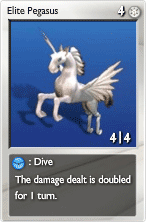 |
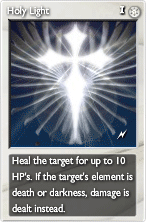 | Holy Light/Flash Classical fantasy thingie. Holy Light often punishes evildoers, or heals soldiers of the light - in this case it does both. Not holy water - like in many fictional stories, but pretty much does the same. Holy Flash is thermodynamically improbable: it is free of charge. I sorta expected at least a 'holy flash' from a pretty priestess. :) That has its curing properties as well. Especially if it is free. | 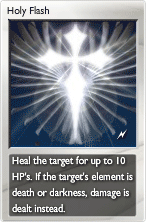 |
 | Solar Shield/Buckler Converting reduced damage into light quanta: the idea probably came from solar panels - hence the name. Solar cells convert light's energy into electricity, thanks to the photovoltaic effect. This means that the absorbed light causes the excitation of an electron or other charge carrier to a higher-energy state. (Excitation pretty much means that we put a particle to a higher-energy state. Excitation can happen by different means, for example heating (e.g. the color of the different fireworks come from the excitation of different metals' electrons), or by light (our example).) If you look at how solar shield works, it is sort of a backward solar panel: damage=excitation, electricity=light quanta (which is produced here). | 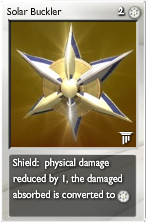 |
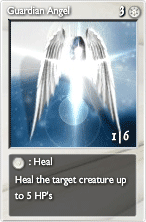 | Guardian Angel/Archangel Along with Greek the other favorite repository for fantasy games are Hebrew/Christian mythology. Hard to track down the original idea, Zoroastrianism seems a likely candidate, though it is easy to imagine that early humans probably had the vision of powerful, winged humanoid beings. In these religions they are supernatural beings which serve God and they often provide a mean of communication between God and humanity. There are a lot of different categories and hierarchies for angels in different religions. Some of these angels aren't really winged humanoids, they can have various strange shapes and looks. Interestingly enough Angels and Archangels are in the lowest order in Christian mythology. Some of these religions also believe in the existence of Guardian Angels. | 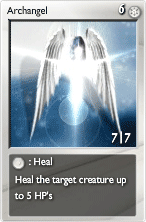 |
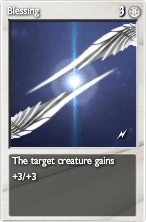 | Blessing/Improved Blessing The element of Light often associated with goodness, helpfulness thanks to Judeo-Christian mythology (again). No wonder the spell Blessing got categorized here, as a Light spell. The origin of the word 'bless' refer to paganism's blood sacrifice rituals, while the modern meaning probably have been influenced by Bible translations. In many religions being blessed means to be favored by God. Here creatures get a 3|3 per spell, which is pretty good as far as virtual blessings go, I think. :) | 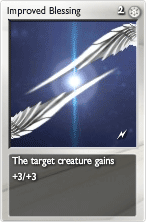 |
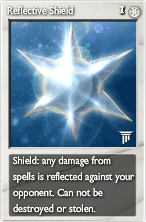 | Reflective/Mirror Shield Mirrors are interesting objects. They are capable of reflecting images. More precisely they reflect waves. Any surface can be a mirror which is smooth enough: its texture/roughness must be smaller than the wavelength of the waves. Even our eyes can serve as a mirror. The first mirror - after eyes :) - human beings experienced was probably the surface of water. Later mirrors were made out of stones (e.g. obsidian), glass, and metals like bronze, copper, steel, silver or aluminium. The surface of these materials were polished. The invention of the silver mirror is credited to Justus von Liebig in 1835. A type of telescopes (reflectors) use a single or a combination of curved mirrors to reflect light and form an image. The Greek mythical hero Perseus got a mirrored shield from Athena, thus he was able to slay Medusa (who had a deadly gaze, turning people to stone) looking only at the reflection of her. Seems her gaze did not have a wave form, so the mirror haven't reflected it. :) But this in-game shield reflects magic, that's its main power, reflecting back that nasty magic damage to the user. In fact you can do a reverse Perseus trick with this shield: apply magic damage to yourself, and it will be cast upon your opponent! | 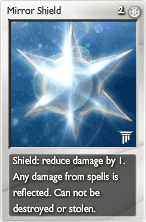 |
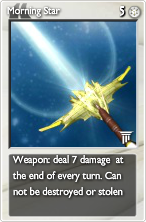 | Morning Star/Glory In many cultures Venus is the morning star. (And also the evening star - because many of them didn't recognize they are the same entity.) The name was also used for the Sirius, which appears in the sky in summertime. Also morning stars are spiked club-like weapons. You see, this is a quite popular name, can refer to a lot of different ideas or even people. The weapon in the game doesn't really resemble to a spiked club, so it is logical to conclude that its shininess matters, and it must borrow the traditional name of the 2nd shiniest object of the night sky. (Talking of that, where are the Moon-related Light cards, Zanz?) And just don't ask from where did the upped version's name originate...! (Really, Zanz? :D ) In all seriousness: there is a well-known flower with this name. But obviously Zanz just wanted to tell us that the Venus looks glorious. Btw: these weapons cannot be targeted when flown - probably just a balance idea, but we can say that it is sorta hard to target Venus as well. :) |  |
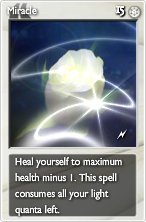 | Miracle/Improved Miracle For me, it is a great Queen album from 1989. By definition it is a supernatural (and beneficial) event which goes beyond scientific explanation. But the word's everyday usage only refers to very very very very lucky events, like being the sole survivor of a plane crash etc.. For a theist it means that God somehow intervened in people's life by himself or by a middleman (a saint, a religious leader etc.). In this game the Miracle is guided by the player. It would be more in conjunction with the original definition of 'miracle', if it would be auto-casted in the last moment to save your game. :) It would be even more fun as an :entropy card: imagine that at a random moment in the game you just would get a random huge boost, like hp refill, mass invulnerability cast on your creatures, or mass Parallel Universes, or getting a Mirror Shield when your opponent has only magic damage to attack you. :D That would be a real improvement over the basic card Miracle. The name Improved Miracle is so funny. I mean... What are we talking about, odds? Unupgraded Miracle fixes things having a 1:10000 odds, an Improved one fixes 1:100000 odds events? :D Funny thing that Blessing has also and Improved counterpart, but not Sanctuary... though the 'improvement' is the same for each cards: less casting cost. | 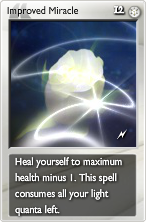 |
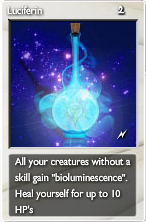 | Luciferin/Luciferase If you ever used/seen light sticks then you had seen a chemiluminescent reaction. If you have seen a luminol test in some thriller then you also saw the practical application of a chemiluminescent reaction, when it happens due to blood's iron starting the lightshow. If you have ever seen fireflies in the night, you saw a bioluminescent reaction. Luciferins are a group of bioluminescent substances produced by different animals. The light is produced when the luciferin molecule undergoes an enzyme-catalyzed reaction with molecular oxygen. The enzyme is called luciferase. As you can see, both substances are needed to create the aforementioned shiny effect, so it is quite silly that they are a normal/upgraded pair, strange choice of names. Luminescence is the emission of light by a substance not resulting from heat. Chemilumincescence when this happens due to a chemical reaction. Bioluminescence when this chemical reaction happens in a living organism by its normal biochemical inner workings. An excited intermediate is produced which decays, thus lower energy products are created and this causes light emission. There are bacteria, fungi, algae, jellyfishes, molluscs, arthropods and so on capable of bioluminescence. Maybe the most well-known of them are the fireflies. The light is used for example for signalling, defense, mimicry, camouflage, attraction... The card's effect works in align with these, the creatures affected by it will start producing light quanta. The HP-boost is inexplicable by the science above, so we just conclude it was a gameplay-related balance (magic healing with light nr 2. - after Holy Light). | 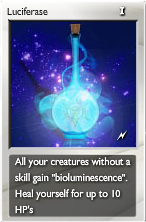 |
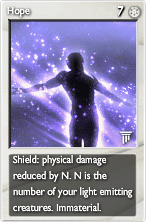 | Hope Another idea/notion/feel which universally deemed positively*, as a card it resides at the Element of Light rightfully. Zanz's take on hope is very optimistic. It is based on the idea that many people together (even if they are puny alone) with the same positive thought/mindset can make a huge change. Sounds good, let's hope sometime humanity will be able to radiate this message... (Fun fact: the card art was possibly inspired by the poster of The Shawshank Redemption, which is probably the greatest movie about hope.) I must add that in my opinion hope can be a toxic feeling, can make you cling to seemingly impossible scenarios without really propelling your life forwards. No wonder that a famous Hungarian poet wrote a beautiful, but bittersweet poem about hope. https://www.babelmatrix.org/works/hu/Csokonai_Vit%C3%A9z_Mih%C3%A1ly-1773/A_rem%C3%A9nyhez/en/2001-To_Hope | 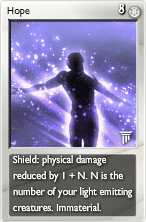 |
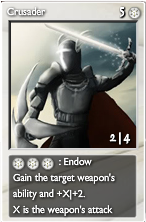 | Crusader The Crusades were a series of religious wars initially to conquer the Holy Land, and many of the soldiers fighting there were crusaders - noble knights. Later the wars expanded to other territories, finding other enemies of Christianity, and commoners joined the ranks as well. The history of these Crusades are vast, the events are... let's say divide people. Initially a defensive war, which often turned to self-righteous even to a bloodboiling level*. Hard to find a metaphor for the in-game ability of this card. This is the only really human character in the game, it has a weapon, let's give it some meaning. The only weapon it cannot use is ironically the Element's own weapon, the untargetable Morning Star. Let's say this card is a metaphor for the versatility and malleability of human beings. I must add that's true for a lot of wars when it tries to justify itself. | 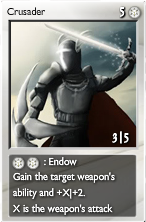 |
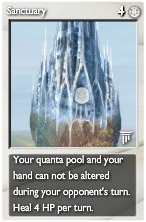 | Sanctuary A place to feel safe. To feel safe against distraction and hurt. A sacred place. A shrine. You can see that again the everyday meaning can differ from the religious one. It can mean a whole temple or just a part of it, for example the area around the altar. Personally, it can mean your home, or your bed, just under your blankets. In the game you are protected against mental (Nightmare, Silence, Shard of Bravery) and energy harms (Discord, Black Hole, Devourer) - just like in real life, and gain some recuperative benefits. Sadly, it also "protects" you from possibly positive interventions as well (Solar Shield, Dissipation Shield/Field, Soul Catcher on opponent's turn). | 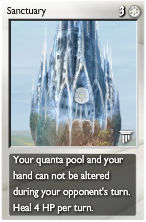 |
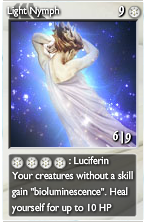 | Light Nymph The holiest between nymphs: they cast luciferin, so their touch can cure your wounds (HP boost), plus affected creatures will be light quanta producers. They spread light in a magically effective way. Practically they multiply light, which is impossible in the real world. The only thing close to it is the photomultiplier tube, but it doesn't multiply photons: it strengthens the signal of a photon(s) to make it/them easier to detect. Such an instrument is capable of strengthening the current produced by incident light by 100 million times! This makes it possible to detect even a single photon! The working principle of the instrument stems from the photoelectric effect discovered by Hertz, but explained fully by Einstein 18 years later. Shortly, when electromagnetic radiation hits a material electrons are emitted. You need metals which are ready to give those electrons, like cesium or rubidium. The photocathode is coated with this metal, light makes them emit electrons, which are accelerated and these electrons hit another metal surface and create even more electrons. If we interconnect enough pieces of these primary elements together they will together create lotsa lotsa electrons. Historically this was a way to create better computers, today they are mostly used for light detection and analysis. One of the main inventor of the technology was Hungarian physicist, Zoltan Bay. Despite the fact that vacuum tubes are largely got retired due to newer technologies existing, these devices are still in use. Also the fact that we can count photons this way shows that light indeed corpuscular (besides being a wave as well). Extra coolness: our eyes are capable of detecting a single photon. Caveat: the brain has neural filters and won't allow the signal to pass unless 5-9 photons arrive in 100 milliseconds. | 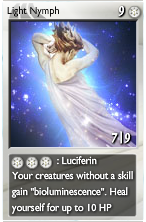 |
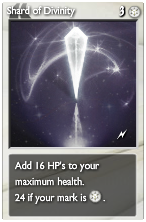 | Shard of Divinity A divine intervention can extend your life - possibly that was the basis for this shard, which adds 16/24 to your max hp. We won't get immortal due to it we just get a shard of divinity. |  |
Post by: Wyand on May 10, 2023, 10:01:34 pm
:airbig | AIR | |
| The gaseous layer of Earth. Classical categorization divides this into four further sublayers: troposphere, stratosphere, mesosphere, thermosphere* - with the latter ending at around 600-700 km height. There is also a fifth layer, the so-called exosphere (which almost spans an extra Earth diameter into space; ~10000 km), but it is so sparsely filled with gas particles that some scientist consider it a part of interplanetary space. The troposphere is what common people consider as "air", for a very good reason. Til the start of the stratosphere the pressure drops to the one fifth of the sea level pressure - not much life is found here (bacteria, and only a few birds has been spotted here). 99% of the atmosphere's mass is concentrated in the troposphere and the stratosphere together. Air contains about 78% nitrogen, 21% oxygen, and 1% other gases (mainly argon, but carbon dioxide and water are also important constituents; with small amounts of neon, helium, methane, krypton). The amount of industrial pollutants (and natural sources like volcanoes) depends on area. The ratio of these gases are very important. Less oxygen would mean a global civilization stuck at stone age, because it would be impossible to ignite fires. More oxygen would mean much, much more wildfires. Less carbon dioxide and water would mean a weaker greenhouse effect and a colder climate. We can currently feel the opposite as global carbon dioxide levels changed drastically in the last hundred years (about 40% rise!!!). Air is a classical element. Since this is the last such Element in this list, we can conclude now, that Ancient Greeks mixed up elements with states of matter. Earth - solid, Fire - plasma, Water - liquid, Air - gas.** As a classical element Air's opposite is Earth. Easy to understand this, since we can feel how solid materials feel more substantial. Air is also related to flying - no wonder this element contains so many flyers/flying related cards. Also, when we think about air we often picture light blue skies. This light blue color is caused by Rayleigh scattering. The air molecules in our atmosphere are able to scatter the Sun's photons, and because shorter wavelength photons gets scattered easier we see this beautiful blue color***. Relation to sky is another important aspect of the Air deck****. The Internation Space Station resides in the middle of the thermosphere. I wouldn't call them stupid for it, clearly, just a different thinking, but sorta shows their idealism. Funny how Plato was the idealist and Aristotle the realist - still the latter was the one who promoted and popularized the theory of 4 elements. Aristotle's influence was so strong that for some 1500 years it was enough to cite him to win an argument. This greatly hindered the evolution of natural sciences - especially chemistry's. Yes, I know, violet has the shortest visible wavelength. But our eyes are much more sensitive to blue color than violet, plus the solar spectrum doesn't contain much violet. The sun's different color at different stages of the day can be explained by the same phenomenon. (The sun's true color is white!) Normal daytime we perceive the sun yellow: the blue light has scattered, the remaining dominant color is yellow. At dawn or sunset we perceive our central star red because now light has to travel through a thicker atmosphere - think about the angle of incidence! -, and more scattering happens (even yellow color gets scattered), and orange/red stays. I somewhat miss a Rainbow card! It would be such a nice trio synergy card between :water :light and :air. I guess Nova and Immolation sorta kills the possibilities, but still, it could operate like a special Quantum Pillar: eating up :water :light and :air quanta, while producing :fire :gravity :time :life and one random quantum (except those 3 needed). | ||
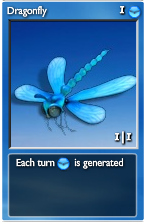 | Dragonfly/Damselfly These flying insects share a group (order) named Odonata. Their ancient ancestors from 325 Mya (=Million Years Ago) had even a huge species, with a wingspan of 75 cm! Dragonflies are beautiful creatures who are great fliers. They can propel themselves in all 6 main directions. They even have 4 different styles of flying. Larger species can have a speed up to 54 km/h. They really need this speed since they are predators. And what else does a predator need? Good eyesight. If you've ever seen up-close a dragonfly, you must agree, that their eyes are like enormous gems. They are able to see 200 images per second, see in 360 degrees, and almost 80% of their brain is dedicated to sort and analyze the info got through their eyes. They often have an iridescent/metallic color which is a result of structural coloration (producing colors with microstructures through interference instead of pigments). Dragonflies are/were important symbols for certain cultures or tribes, either as amulets or medicine animals. There are interesting names for them in some languages which show that other cultures have feared dragonflies. For example the Norwegian word for them is Oyenstikker* (eye-poker). Their Hungarian name is really funny: szitakoto* (sieve-knitter). Damselflies are the smaller cousins, with worse maneuvering capabilities. Basing stats on this data they should be reversed, Damselfly being the unupped. This is dictated by another fact: they are the older group and have existed since the Lower Permian, 299 Mya. The 'o' has a diagonal strikethrough, but forum engine would possible destroy the special character. (https://i.ibb.co/Cm1gTDk/oyen.png) (https://i.ibb.co/Yt80ZN0/szk.png) | 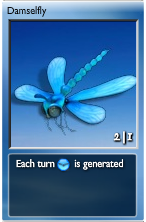 |
 | Wyrm/Elite Wyrm The word originates from Germanic mythology and sorta means dragon. "Sorta" because dragon doesn't equal wyrm, though they are very similar in a lot of features. In many cases wyrms are wingless and often limbless as well, pretty much a snakelike appearence. Dragons are mostly winged. (Drakes being wingless, but have limbs.) Wyrms often has a poisonous breath, in later mythological stories it can be even fiery. Elements' version looks very oddly. It not just sports wings, but these also has a fin-like appearence, plus the creature has a snake-y thingie protruding from its abdomen, which makes it look even more confusing*. And it isn't just a flier, but also an excellent flier with the dive ability. The fat, slithering monsters got turned into sleek raptors. Just like male ducks... don't google it! I told ya! :D |  |
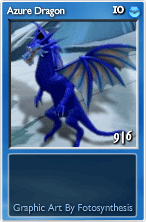 | Azure/Sky Dragon Another dragon. It is blue. Like this Element. And why Azure? Just a reminder: Zanz is Italian. SPOILER: , (https://i.ytimg.com/vi/uyH9EyOW8nE/maxresdefault.jpg) | 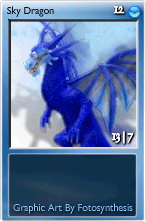 |
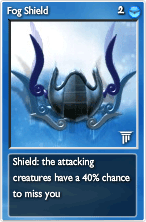 | Fog Shield What is a fog? It is a meteorological phenomenon, and like all of these phenomena, it has a physical-chemical background. You could simply say that a fog is a cloud near the Earth's surface. They are both dispersions, namely aerosols, which means they consist of tiny droplets of water (or ice crystals) suspended in air. Technically it can be any material which is fluid at a given temperature, but in nature you will experience fogs made out of water. The size of the particles is in the range of 5-15 micrometers. Normally, the first condition for a fog to happen is having near 100% relative humidity (this is the maximum amount of water vapour the air can hold at that temperature and pressure). Then water vapour needs to be condensed to form a fog. For the phase change nucleation must happen. In this case we need condensation nuclei, which can be dust or any other small solid particle floating in the air. On these nuclei the water starts condensing creating the fog. Another phenomenon, mist is very similar to fog though it is thinner and more transparent (also having bigger droplets, in the range of 50-100 micrometers). By definition fog reduces visibility to less than 1 km, while mist is causing milder visibility issues. Using 'Mist Shield' as an unupgraded counterpart would have been better. Fog Shield is famously overpowered. Remembering how hard is to drive in fog we'll understand why this shield is so terribly strong. Though it is insanely cheap. I somehow feel that a possible :water synergy has been dropped here, and that would have been a nice balance for this shield. For each successful block it would deduct 1 :water quantum. Having no :water quanta would reduce its efficiency to only 20%. And why does the fog look white, when water is transparent? The water droplets in fog are relatively big - compared to the wavelengths of visible light - so it disperses every wavelength of it evenly (one could say the dispersion in this case is not wavelength dependent - unlike in colloids). | 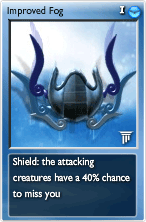 |
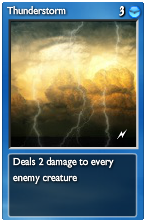 | Thunderstorm/Lightning Storm Another meteorological phenomenon. It has relations to the previous one since clouds are needed for a thunderstorm to happen, but the formation and the physics behind it is a bit more complex. A thunderstorm's main characteristic is in its name: the cloud produces lightnings which causes an acoustic effect on the air called thunder. Cumulonimbus is the name of this type of cloud which is able to host such storms. It is a vertically developed cloud, its top often resembling to an anvil. Most thunderstorms are accompanied by strong winds and they often produce heavy rains (sometimes snow, sleet or hail). The thunderstorm itself forms when warm, moist air rises quickly into cold air. This happens due to density differences. Then the warm air cools, water condenses, and the cooled air drops lower again, warms, rises again. This is called a convection cell. A small convection cell leads to the creation of a cloud, while a big one leads to a thunderstorm. Huge thunderstorms are called supercells which can cause devastating effects (tornadoes etc.). A simple cloud is white, because it doesn't contain that much water droplet, while a thunderstorm looks grey, because it is more dense in those droplets. Oddly enough :aether has the Lightning card, which is pretty much the same phenomenon. We will discuss the properties of Lightning there. Lightning heats the air to around 30000 Celsius, and this extreme heat causes the air to expand explosively fast. This creates a sonic shock wave that turns into a booming sound wave, the thunder. More about shock waves later. And how much does a cloud weigh? A single, 1 km3 cloud weighs 551 tons!!! | 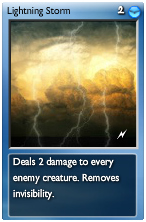 |
 | Flying/Animate Weapon Another fantasy trope, so let's quote from tvtropes.org: "A flying weapon is a weapon capable of fighting without anyone touching it.". Here, it is a mean by which our weapon turns into a flying weapon retaining its abilities and damage output. Hit points and damage output are different for each weapon. | 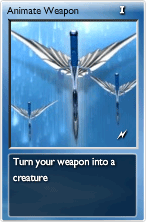 |
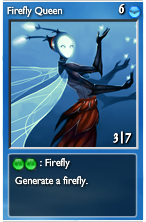 | Firefly/Elite Queen Fun fact: fireflies doesn't have queens. (Not considering that some male fireflies may feel their mate as their queen. :) ) In this game they're spawning fireflies. The synergy is nice with :life. However many insects have so-called queens whose only purpose is to lay eggs. The idea for this card clearly originates from this fact. |  |
 | Firefly/Elite Firefly We already discussed at Luciferin that many living organisms are capable of bioluminescence. Fireflies are the best known among them. The exact name of the family is Lampyridae with more than 2000 beetles - many of them light-emitting. It is thought that originally it was a mere signal for predators that their larvae are distasteful. Later on it evolved to a mating signal, and as a perverse twist some female fireflies use this as a bait to capture and eat other male firefly species. Their existence catched human attention early on, watching fireflies as their signal each other and mate on late Spring / early Summer nights is a beautiful spectacle. In Japan this signifies the changing of the seasons. In their country firefly viewing is a popular pastime activity, there are even parks for this purpose. Many civilizational "side effects" endanger fireflies like light pollution, pesticides, invasive species, over-collection and climate change. Firefly luciferase is used to detect the presence of ATP or magnesium ions. In Hungarian fireflies are called szentjanosbogar* (=saint john's bug/beetle). In the game they produce :light quanta, which is a nice allusion again. The same can be said about their elite counterparts, but they produce :fire quanta. I think it is one of the most interesting upgrade choices, which are great both on an aesthetic and gameplay level. (https://i.ibb.co/Y3Xy02Y/sztj.png) | 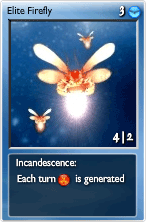 |
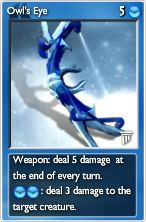 | Owl's/Eagle's Eye Owls and Eagles are famous for their great eyesight. Owls can't move their eyes in any direction, because they are fixed in a tube. Instead of that they are able to rotate their heads and necks as much as 270 degree. They can do this, because they have 14 neck vertebrae (humans have only 7), giving them more flexibility. They also have a large binocular field of view, which is among some of the bests in their avian fellows due to their most frontally placed eyes. They are important figures of mythology and serve as symbols in many cultures. Sometimes they have a positive meaning (wisdom, a good omen, wealth), sometimes a bad (harbinger of death). Eagle eye is among the sharpest in the animal kingdom. Eagles are said to be able to spot a rabbit from 3.2 km away (extrapolating from the fact that they have 4-8 times better visual acuity than humans). Their large eyes fill their sockets so much that it causes them difficulties moving those eyes - so instead of that they have to turn their entire head to see off to the side. Their retina's fovea has about 5 times more cells per mm2 compared to humans. (Fovea is the part of the eye which is responsible for sharp central vision.) Eagles are also capable to dive at speeds of 200-300 km/h and as they approach the target they still have to focus perfectly on it. The muscles in the eyeballs continuously adjust its curvature to maintain sharp focus. You have to have good eyesight to aim and hit accurately with a bow. Someone having a keen eye for something is often called eagle-eyed. Otherwise, this permanent is CC-on-a-stick... Oddly enough in alchemy air's elemental weapon is a dagger. | 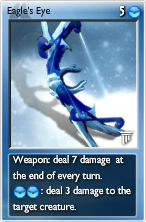 |
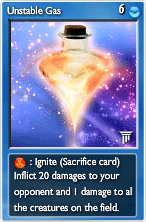 | Unstable Gas How do you define unstable? I would define it as a system which isn't just not at equilibrium, but even a small nudge can send it into a more stable state. Materials can be unstable chemically and/or nuclearly. We will talk about the previous here, since in the game there is a classical explosion started with :fire. By the game's definition a lot of gases are unstable: natural gas (consists of mostly methane - CH4), hydrogen (H2), dimethyl ether ((CH3)2O) and so on. The danger level grows in this order. But they are all stable gases. They need some external energy source (fire, electric spark etc.) to react at room temperature. Acetylene (C2H2) is more dangerous than those previous three, but still considered stable (at standard atmospheric pressure; it gets unstable if its pressure exceeds 200 kPa). If you are looking for some real instability, you must search for pyrophoric gases like diborane (B2H6) or silane (SiH4). Pyrophoric means that they burn instantly upon contact with oxygen/air. And we have one more serious classification of gases: unstable gases. These are so edgy, their bonds might just break spontaneously, like ethylene-oxide (CH2CH2O). "May react explosively even in the absence of air" - says the MSDS (Material Safety Data Sheet) document, and they have the code H230. The previous groups are also defined in this standard: acetylene and co. are called "flammable gases" and have the code H220/H221, while the pyrophoric gases got the code H250. So in fact the in-game Unstable Gas is "just" a Flammable Gas. Maybe Extremely Flammable Gas, since only 1 :fire is enough to set it off. Zanz's choice is defendable, he wanted to have that nice :fire synergy and having the cool name, too. :) And we haven't even mentioned those gases which are simply so unstable at room temperatures that they only exist cooled. | 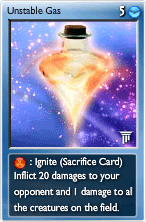 |
 | Shockwave A shock wave is created when a strong pressure wave in any elastic medium moves faster then the local speed of sound in the medium. A good example for that when an aeroplane (or a bullet) breaks the sound barrier or when a detonation happens. Bombs or natural events (like a bigger meteor, like the one from 2013 in Russia) can both trigger the latter. The sound of a thunder is caused by shock waves, too. (The sudden increase in temperature and pressure - caused by the lightning - leads to a rapid expansion of the air.) A properly wielded bullwhip is also capable of creating shock waves*. Let's go back to airplanes. Until the airplane travels less than the speed of sound, the air ahead begins to flow out of its way before the plane reaches it. The pressure waves are smooth and gradual. Reaching the speed of sound the airplane catches up its own pressure waves, thus the air can't move out of the way of the airplane. It has to plow through air, creating a shock wave. Shock waves can cause serious damage. A thunderclap can rupture the eardrum of people being too close to it. Detonations can even shatter windows. It is important to note that shock waves are not air-exclusive phenomenons, they can happen in any sort of medium. Because of that it is a bit strange that it ended up here, though regarding that most shock waves experienced are air shock waves it earned its place. It also has a nice synergy with water (ice), which rhymes perfectly with its damaging capabilities (think of those windows). Earthquakes generate seismic waves, sometimes also called shock waves, but they are different from the "real" shock waves. These waves travel in the Earth's crust, like ripples propagate on water. They are essentially sound waves. If the speed of the sound wave exceeds the seismic shear wave velocity (about 3-7 km/s) it can create "real" shock waves. Shockwave Flash ;-( |  |
 | Wings Evolution produced wings for many different types of animals: birds, mammals, insects. I'd like to stick more to biology here than physics. The wings role in both cases (nature/machines) is to produce a lift while moving through a fluid. Birds have feathered wing, bats have a membrane of skin between their limbs, while insects has an even thinner membran attached to their thorax. Some birds use their wings to propel through water. Since the in-game graphics clearly shows a feathered wing, I'll focus on bird's wing here. They are paired forelimbs. This means that they are homologous with our (and other vertebrates') arms. This means that their evolutionary origin is similar. This also means that the forelimbs in tetrapods (=animals with 4 limbs) consist the same bones. Though bones of the hand are somewhat reduced and some bones are fused together in wings. The bones of three fingers are preserved in the bird wing. Most of the bird wings can be categorized into 4 types - but I won't go into details here. Instead of that, here is a record: White-throated needletail (Hirundapus caudacutus) owns the record of the fastest observed flight (straight flight, not a dive!) at 170 km/h. On game terms it works properly: to attack a winged defender you must also have wings or a ranged weapon. Wings are also OP, think of Bellerophon, how Pegasus made him untouchable. |  |
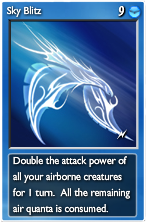 | Sky Blitz An old android game, a fireworks brand and a really old comic. That's what I found when I was googling for "Sky Blitz". Had to scroll down a dozen pages until I've found something Elements-related. Looking at the dates maybe that old comic gave the idea to Zanz? Who knows. Anyways, this spell causes mass dive on flyers. Hard to find anything related to real life. But let's try anyways: the speed record for diving is 389 km/h, and the holder is the peregrine falcon. Fighter pilots can handle up to 8-9 Gs. (*G-Force = gravitational acceleration, 9,81 m/s2). Peregrines and gyrfalcons can withstand up to 25 Gs. They have many interesting body features to enable this unbelievable stooping speed. In their nostrils there is a structure called tubercle. Without it - when diving - the air would rush into their lungs in a straight way which would damage it. The tubercle serves as a baffle, it "detours" the air to go in a spiral way which slows it down to be safe enough for the bird's lung. They also have "third eyelid", a semi-transparent membrane which protects the eye from dust particles, rushing air and also lubricates and cleans the eye. Their tears are also quite thick (as maple syrup - as my source claims) which protects the eye from drying out. Other interesting body structures are the huge keel bone (breastbone) - this is the place where their strong major muscles are attached - and extra pair of vertebrae on their tailbone - provides a larger area to attach for muscles for maneuvering - and a highly efficient lung. Their heart beats up to 900 times per minute! This allows them to flap their wings up to 4 times per second... I think I proved why can Sky Blitz be lethal. | 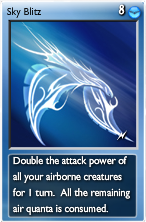 |
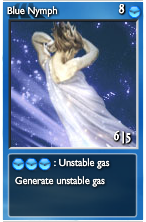 | Blue/Air Nymph The ladies with flatulence problems. :D For 3 quanta they can produce some flammable gas (probably methane) and use it to damage everyone. I say the real unstability here isn't with the gas, but with their digestion. Maybe you tried the same in the bathtub or at a campfire - we hope you didn't have any long-term damages from the experiment. | 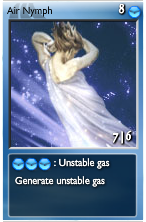 |
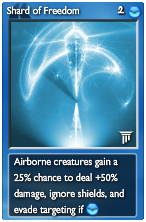 | Shard of Freedom C'mon. | 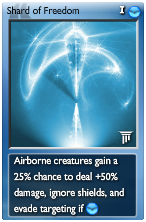 |
Post by: Wyand on May 10, 2023, 10:01:53 pm
:timebig | TIME | |
| A phenomenon no one can explain satisfyingly. What the clock measures*. That's too arbitrary. The fourth dimension. Too scientific, and tells really nothing about the nature of time. The change of entropy shows the arrow of time. That's true also, but even more confusing for an average person. Time is one of the seven fundamental physics quantities in the SI (Systeme international d'unites** - International System of Units). Its unit of time is the second, which is defined by measuring a specific electronic transition frequency of caesium atoms. Ugh. Well-defined, but still complicated. A human way to measure change. That's my own definition - because I don't really believe in time. Time is an illusion. It is sure a handy idea to define a lot of things, and make the passing of all things more understandable. You are on a train, an hour passed, and you are now closer to your goals. You have to sleep 12 times until Christmas. (Damn, this phrase already has an extra "time" in it!) Your dog has passed away after 15 years. The Roman Empire crumbled after centuries of existing. Thousands of years and humans are still stupid. I've spent ages playing Diablo II - and never found a 40/15 IAS jewel!*** After 10^1500 years The Universe may be filled with iron stars. And with strange eons even death may die. It is a way to measure intervals between events. Believe it or not, that's the official definition by physics. Through history time was measured by sundials, oil lamps, candles, water clocks, hourglasses, mechanical clocks, digital watches and atomic clocks. (https://i.ibb.co/qYJ9xgG/SI.png) Hard to unsee the irony. | ||
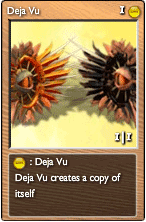 | Deja Vu/Elite Deja Vu A french loanword, or rather expression.* The term was coined in 1876 by a French philosopher Emile Boirac. It is a strange feeling when you could have just sworn that some experience already happened to you once or more times in your earlier life though it seems paradoxical, because in fact you never been at that special place earlier. They say it happens more often while we are younger. If you have a more fulfilled life, more experiences, you might feel more deja vus. We don't exactly know the neurological reasons behind deja vus. Maybe we just picked up some information passively, then reliving something similar again our brain signals, or we just actively forget something which passively gets still stored in our brain and similar experiences trigger that feeling, or maybe it is related to the fact that we have 2 hemispheres and signals arriving to the left and right temporal lobes sometimes aren't synchronized properly. Or maybe they are just linked to experiences in our dreams... There are other related psychological phenomena, worth checking them (like jamais vu, the opposite of our topic). It is not by accident that this Element contains even more cards which are linked to psychology. These cards, phenomena somehow carry some UNCERTAINTY. Like time. You might say time is very much certain, because everything must end sometimes in the future... but WHEN? That's why I think that my favorite Element, Entropy should be paired with Time. Zanz should have added more Entropy-Time synergies.** Also some Gravity-Time synergy would be also nice, since gravity slows time... All in all not that scientific, but another great metaphor from Zanz. English language does not conserve foreign accents - the original writing is (https://i.ibb.co/x2Ltcw1/dejavu.png) . It means "I've already seen it". Anyways, these colors do look so nice side by side to each other... like some retro ice cream, strawberry and vanilla (punch and vanilla for Hungarians, especially for 90s kids and older :D ). |  |
 | Fate Egg Another nice connection to Entropy. But here the question isn't "When?", but "What?". But "Why" an egg? Most of the time an egg itself is just a cell surrounded by a soft or hard shell, full of nutrients, used for consumption. Of course, the original "usage" is to spawn offsprings which will happen only under the right conditions. Which means the egg will soon hatch - only time will tell when. (Usually when you have one free time quanta to spend. :) ) And then comes the "What?" question, with some random funkiness. But still: why an egg? Why does an egg represent some mystery? You could easily just say "think about Kinder Surprise"*, but surely their usage must have some earlier connotation, so it is more than just a nice way of packaging. Eggs are important symbols in folklore and mythology often representing life and rebirth, and it isn't really surprising that some creation myths are also connected to it. The reason is simple: a lot of different animals reproduce by eggs - not just birds! The list includes reptiles and some mammals, too. Though not really "classical looking", but some fishes, amphibians, insects, mollusks, crustaceans and worms lay eggs as well. In their case surprise is not an element, since most of the time a new member of the correct species will emerge from the reproductive husk. In Elements fate decides what will appear**. Oddly enough Kinder Surprise is banned in the USA. But you can still run along with firearms. *cough* *cough* You might say fate still has a role in the case of normal eggs, since genetics and environmental factors can affect the exact qualities of the offspring - but the spectrum is way wider in Elements. |  |
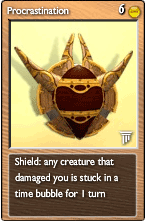 | Procrastination/Turtle Shield Oh boy, Zanz going meta with the naming of this shield! If you are playing online games like Element, it'll surely worsen your habit of procrastination... But why do we procrastinate when we know that it will only make things worse? The short answer is that procrastinating reduces anxiety in the SHORT RUN. It is thought that a little bit of procrastination is just alright, because it helps prioritizing tasks. On the other hand, too much procrastination leads to stress, even more anxiety, guilt and all of this can result a loss of productivity, and of course, which ultimately will cause social disapproval which further erodes self-esteem. And of course leads to more procrastination. A vicious downward spiral. It must be noted that perfectionism also can lead to procrastination. Though this is mostly true for those who saw their perfectionism as a problem. The physiological roots are linked to the prefrontal cortex, since this is the area in the brain which is responsible for impulse control, attention and planning. The human brain innately values immediate rewards more highly than possible future rewards. That's why the prefrontal cortex has a crucial role in battling procrastination. About Turtle Shield... well... upgrade name disease... what's slow? A turtle*. Yep. (Yet, it is still faster than Achilles, but that's an entirely different story**.) An idea for a better upgrade name: Akrasia. This word was coined by Socrates and Aristotle to describe this kind of behaviour. The exact meaning of this word is "the state of acting against your better judgment". It is quite entertaining how Zeno's paradox - maybe unknowingly - describes the problem of limit, which was explained more than two millenia later. | 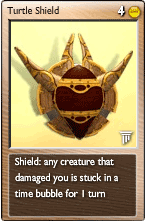 |
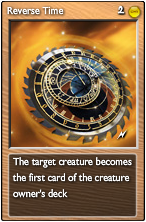 | Reverse Time/Rewind The card which makes Cher's fantasies come true. According to physics backward time travel is highly unlikely. Like stated earlier thermodynamics defines the arrow of time and it is in conjuction with the growth of entropy. You could say entropy is time-sensitive, or more exactly: not time-symmetric. For example if you play a video backwards one will notice that it is played backwards, because the order of events doesn't make a sense, it lacks causality. That is one of the problems with backward time travel: things happen with a cause and backward time travel would create paradoxes. Talking about videos: it was a nice upped name from Zanz, older members here might have experiences with rewinding audio or video cassettes... All in all: you cannot really travel back in time, but that won't stop our imagination. And it won't even stop theoretical physicist, you can find really interesting ideas about "how to time travel?" (mostly using general relativity and/or quantum mechanics). Considering how time travel seems impossible, it is strange how these cards are so extremely cheap. Especially if we add how they behave in-game, not just making a creature disappear from the table, but also hindering the flow of your deck. "Balance reasons" - I guess. But the Skeleton/Mummy + RT combo is really the cherry on the cake! :) | 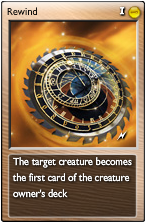 |
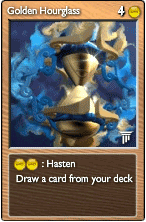 | Golden/Electrum Hourglass The latin phrase tempus fugit (time flies) even had a depiction, and it was a winged hourglass. The hourglass is an old instrument for measuring time. The origins is unclear. We know about the clepsydra, the water clock, which can be viewed as a predecessor and was used since ancient times (Babylon, Egypt). Some hypothetised that Ancient Greeks might have used hourglasses, since they had a mean to make glass. No documents about it to proof, though. Certain sources name the Frankish monk, Liutprand from the 8th century as the original inventor of this item, but many other sources are sceptical about this information. It became a common instrument in the 14th century. They were used extensively, the most important usage was maybe in navigation*. Many art pieces contain hourglasses - these are the best proof for their usage in the middle ages. Some paintings feature both a skull and an hourglass to evoke not so subtly passing. (If you are too fast with this permanent when playing you may also "kill" yourself!) This item fits nicely this Element - not just by name and behaviour, but also aesthetically: gold is yellow, like the Element's base color, and the sand** in it can be naturally yellow as well (seems :time has a monopoly on sand, think Pharaoh/Scarab!). Being electrum the game's currency it is understandable that Zanz chose it as an upgrade name, at the same time the mythical electrum is inferior compared to gold: it is a natural alloy of gold and silver (sometimes with traces of copper and other metals as well). Electrum's color is pale yellow. I see here a missed :gravity synergy: you need gravity to make the grains fall into the lower bulb! Magellan took 18 hourglasses for his expedition. Many other materials were used instead of sand as a granular material, like powdered marble, metal oxides, pulverized eggshell etc.. Modern hourglasses mostly contain special glass beads (so-called ballotini; they are round shaped and flow freely). It is found that the optimal grain size is between 1/12 and 1/2 of the bulb neck. | 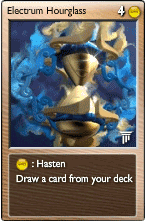 |
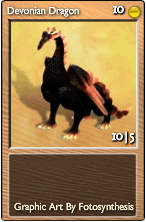 | Devonian/Silurian Dragon Finding thematically good dragons for time? Not an easy task. Zanz chose "time travel" to ancient times: Devonian and Silurian. The Devonian geological period and system of the Paleozoic era happened from 419.2 Mya until 358.9 Mya. (Mya = Million years ago.) Before this period there was the Silurian period from 443.8 Mya until 419.2 Mya. So these two are grandpa/great-grandpa dragons. But. Funnily enough life wasn't evolved enough for having tetrapods (vertebrates with four legs) in these periods. The Devonian period is also dubbed as "the age of fishes". Drylands were mostly populated by mites, scorpions, centipedes and the swarm of other exotic small buglike thingies which could make anyone scream. In the Silurian the situation was even more dire. At the late Ordovician period (just before Silurian) there was a big cataclysmical event which just wiped about 85% of the marine species. No one is really sure what was causing it, though there are different hypothesises. So the Silurian was a time of recuperation/recovery for life. Millipeds and other scream-inducing inverterbrates were roaming around the land. The first bony fishes emerged around this time. Trilobites were still common. Nautiloids are also well-known animals of this period. Bryozoa, crinoids and other exotic marine animals were also abundant and diverse. Leeches first appeared in the Silurian. But no dragons. :( Guess Zanz thought it would be corny to have Jurassic Dragons, though the Cretaceous and the Triassic periods are still there instead of them, when dinosaurs also ruled the Earth. Oh, and did you know that birds (Aves) are dinosaurs?) |  |
 | Anubis/Elite Anubis Sand-->yellow-->time. And mystical. And ancient. And sort of stargate-y. Especially if we consider the aether synergy, they've come from the space*... This card could easily have ended up in :death, because Anubis was strongly linked to death. He was the god of funerary rites, protector of graves and until the Middle Kingdom the lord of the underworld, who ushered souls into the afterlife (then he got replaced by Osiris, that's cruel). This sorta explains the 'immortality' in-game skill. The Jackal God. But why a jackal? Jackals are scavengers and often dug up shallow graves eating up on the corpse's flesh. So oddly enough, in the spirit of "fighting like with like," the jackal as a symbol was chosen to protect the dead. I think Zanz may have thought that we already have one dead-eater creature with scavengers skills, and probably really wanted a time-aether synergy, so the game's Anubises ended up differing pretty much in portfolio. He also has a female counterpart in mythology, Anput. Maybe from the Orion. :-) | 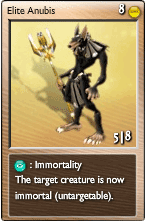 |
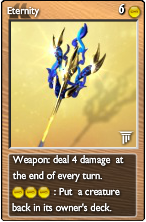 | Eternity A game can take an eternity if both players have an Eternity, enough quanta and no more permanent control in the deck. :) But what is 'eternity'? Can something be eternal? According to our current knowledge our Universe had a start, the Big Bang*. Though there are probably scenarios in which the Universe will eternally grow, expand. Moving from physics to philosophy, different philosophers had different stance on the topic. Thomas Hobbes for example thought that "eternity is a permanent now". In a different game this item might have been named to Ouroboros, the great serpent/dragon eating itself, thus creating an infinite cycle. There are other endlessness/infinity symbols. These symbols share the same common idea: eternity has no beginning nor end. I think because of this Big Bang theory sorta cancels the possibility of eternity in our Universe. But was there anything before the Big Bang? This Big Bang theory seems incomplete... I mean one of the most important basis of natural sciences is conservation of mass and energy. Big Bang theory helps us going back to the singularity from which everything got ejected violently by the Big Bang, but obviously, that matter needed to come from some place... or origin. Maybe the Big Bang was a part of a larger process. Maybe the Universe fluctuates between states: Big Bang, expansion, shrinking/retraction, start again with Big Bang. Or maybe we are just part of a bigger "Universe", where such singularities may happen which spawns newer and newer Universes. But... that begs for the question: what made the 1st Universe? Was there a first Universe? What happened to those Universes which weren't able to spawn life or even basic matter (excluding hydrogen). Oh, we are going too far... Point is: human thinking cannot fathom, comprehend ETERNITY or INFINITE. In our mind everything has a start and an end. Ok, then go look at a circle. Ouroboros. How stupid... why not the "Horrendous Space Kablooie"? :-) |  |
 | Sundial "- Sir, there is an enormous army approaching our position! - Relax, son, draw a circle on the ground, and put a stick perpendicularly into the center of the circle. - ...sir? - Just do what I've told. - ???" Probably the most hated card in the entire game. Anyways, it is the oldest time-measuring device - though you need direct sunlight to work. A normal sundial (not a makeshift one mentioned in the intro) contains a 'gnomon' (="one that knows/examines") which casts a shadow onto the dial. The style is the part of the gnomon which tells the time, its shadow marks the time on the edge of the circle. The style must be parallel with the axis of the Earth's rotation to be accurate throughout the year. Because of this sundials can have funky designs, check for an example of a sundial which made to work properly at the equator*. According to current archeological records earliers sundials appeared around 1500 BC in ancient Egypt and Babylon. Probably earlier humans also noticed that shadows can help predicting the current time of the day. If you are interested worth checking on the topic, since there is an immense amount of different sundials. But how does it align with Elements? Well, half of the working is certainly consistent with the hourglass: spend a quanta, get a card. But this time it is light quanta, since the sundial works by the sun's light (beautiful!). But what about that loathful stasis? What's the explanation? How to interpret it? A device for measuring time certainly doesn't stop time. It was just probably a funky move from Zanz to strengthen stalls. https://sundials.org/index.php/videos/shadows-of-time-roger-dignard/video/shadows-of-time-an-equatorial-sundial |  |
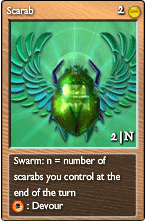 | Scarab/Elite Scarab Egypt, sand, yellow, time again. One could simply call them dung beetles, but that sounds... less ceremonial. The family Scarabaeidea contains more than 30,000 species of beetles. In all honesty not all Scarabaeidea members eat and play with dung, but the Scarabaeus sacer, the sacred scarab which was the divine manifestation of the morning sun, well... does that. But why are they the holy bug? Do you know the feeling when you see something common and something clicks in your brain, and you say: "oooh, but it is like when {some completely irrelevant other event of the day}"? Well, Egyptians looked at the scarabs rolling globular fecal matter, and they thought they found some meaning in life: "oh, but it is like when the sun rises!". Their lore insisted that the Egyptian god Khepri rolled the sun across the sky at daybreak, just like the scarab does that with a piece of... well, yep. But let's not be judgemental, one man's trash is another man's treasure. And don't forget that even Monty Python sang about that life is a piece of... so why not dung ~ Sun metaphor? One must add that there are many bright, metallic looking scarabs, but the scarab the Egyptian worshipped is black. But still, the amulets, seals and other objects picturing a scarab were often colored to green or blue. It was an incredibly popular symbol. The Scarab on the card is shown with its wings spread out, which was a popular way to depict them in ancient Egypt. OK, if the scarab has ties to the morning sun, why not having some :light synergy with different skills than devour? The scarab has also been linked to manifestation, growth, rebirth, regeneration and as a reflection on the heavenly cycle in Egyptian culture. These fit together nicely with devour, and especially with the 'Pharaoh' card. And I sorta think this was Zanz's take on the Pharaoh's curse thematic. Devour somehow needs :gravity quanta*. Swarm passive is also interesting, but scarabs aren't really swarming bugs nor devouring bugs, the idea possibly came from locusts. But locusts doesn't fit the whole Egyptian design of this element. Or maybe just Zanz liked the movie The Mummy too much. :D Yes, here is a wished :time :gravity synergy, but this one just doesn't click. |  |
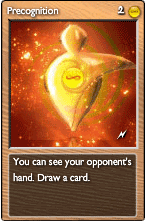 | Precognition A card of many topics: psychology/parapsychology/religion. Let's ruin the party: it is not possible, because it would violate the rule of causality. Of course it doesn't stop people from believing in it, because our brain wants to believe in miracles. And most notably because we have a tendency to remember only those cases when our "precognition" was correct, and forgot those when we missed. "I was dreaming about Joe last night, and poor Joe now is dead." Wow, buddy, you must be very dangerous! Except not. Probably you were dreaming about Joe like 762 times in your entire life, you haven't even remembered most cases, and Joe just kept living... :D That's pretty bad statistics I say! Or I just should have told it is a cognitive bias, namely confirmation bias. Another problem that it is very hard to prove that someone has precog abilities. Alternative explanations for apparent precognition even list deja vu as a possibility. By the way my favorite precognition test is in Ghostbusters. :D And if I mention movies it would be a great mistake to omit the great Philip K. Dick's work The Minority Report (which have been turned into a blockbuster hit in 2002 by Spielberg/Cruise). This isn't the only PKD-work where precogs appear, the most notable other example is Ubik. Anyways... you draw a card from your deck and meanwhile you are able to see your opponent's hand. A beautiful mechanism, since many precognition tests work by cards, the participant must guess what card the other person holds currently. (Just like in that Ghostbuster clip.) | 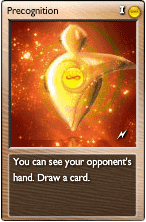 |
 | Pharaoh Egypt, sand, yellow, time, ancient agaaain. The rulers of Egypt weren't always called Pharaoh in the ancient times. I wouldn't go into details, because they are dizzying. Many times they were just called 'King' - regardless of gender. The etimology also complex, but ultimately comes from "great house", written with the hieroglyphs "house" and "column". The Pharaohs ruled Egypt for about 3200 years. Then the Romans marched in. But practically Augustus and subsequent emperors were the Pharaohs of Egypt. There were also 8 different crowns and headdresses for Pharaohs... The royal titulary is convoluted as hell, too. Initially there were 3 titles for the king. Then they turned to 5. Though we heard about 'curse of the mummy', it was never really the 'curse of the pharaoh'. So it is unclear how this idea born, that the Pharaoh card should spawn Scarabs. The base of many scarabs were inscribed with the pharaoh's name on it as a form of impression seal. That's the only close connection between the two. |  |
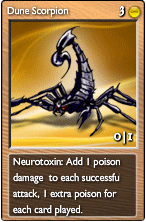 | Dune Scorpion Saaaand etc.etc.etc. again. And the 3rd scorpion so far, because deserts and scorpies are almost like tropes. They are very good on enduring, surviving in these extreme conditions. In fact, there is a taxonomical group called sand scorpions. Moreover there is a dune scorpion! Plot twist: it isn't black, like the one in the game. That's sort of the black sand scorpion (only the pincers and the head are dark :D ). The dune scorpion is actually common in the US and Mexico. The black sand scorpion is endemic to Australia. (Endemic = not just indigenious, but also can be found only there.) Another sand scorpion is the yellow sand scorpion, which is native to Australia. OK, let's just skip taxonomy, shall we? That neurotoxin is more interesting, I say! If you were thorough enough with your reading, you may remember that pufferfishes also have neurotoxin (IRL). They destroy nerve tissue. Scorpion toxins are proteins, they can be specific to certain animal groups (mammal, insect etc.) and they often inhibit the working of voltage-based sodium or potassium channels. Scorpions have venoms, so Zanz only using these words as gameplay-wise grammar trickery. Remember? Deathstalker had venom, now we have neurotoxin. Scorpions are venomous and have toxins. Pretty confusing, eh? Check back the Deathstalker section at :death ! :) Btw, the inner workings of neurotoxins in the game are pretty funky. Haven't broke the metaphor yet, what was Zanz's main idea. As if Zanz thought that these toxins cause more trouble if you try to do against it, as if moving/acting out would spread it more quickly in your body. If something starts blocking your sodium or potassium channels, chances are that you just slow down, and if help won't arrive, you just get immobilized quickly. | 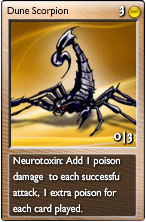 |
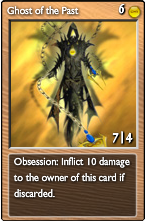 | Ghost of the Past Pure psychology again. Brutal psychology. A ghost of the past can render even the strongest weak, paralyzing him/her. Dickens' novella, A Christmas Carol contains 3 spirits, one them is the Ghost of Christmas Past. Classic WOW has an NPC named Ghost of the Past. There are poems, tv show episodes, songnames, other examples from computer games - we can say it is a well-known idiom. The ghost appears and your mind starts shaking, your brain will be full with the ghost. You get obsessed with the past. The best thing you can do with is to get rid of it as soon it is possible. But sometimes even that can cause harm to you. And this pretty much describes the inner working of this card, which is brilliant. (Yet, I hate this card...) | 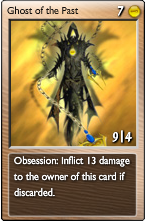 |
 | Golden Nymph These girls are the precogs of Elements. More precisely they are the living combination of the Golden Hourglass and the Precognition card. A good advice: you cannot cheat on her, she sees everything in advance... (But come on, why would a Time enthusiast cheat on her? Ask Oa or kaempfer. :) ) |  |
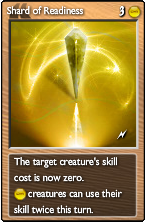 | Shard of Readiness Answers the aforementioned "When?" question with an unquestionable "Now!" Or: "I was born ready!". The equivalent of having infinite ammo in an fps game. Looking at the color of the card it (of course) resembles the Sun. Let's put it this way: once the sun's rays hit your eyes, you wake up, and you are ready to face today's challenges. Don't try to convince me that no, you need coffee, and such nonsense. :) You are doing it because of the Sun! Melatonine gets destroyed by the blue portion of the sunlight, which signals your body that it is ready to leave the place where you spend the third of your life: your bed. That's my metaphor to this card - while I don't know what was Zanz's idea, but it works, a very efficient shard. | 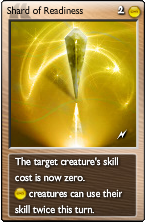 |
Post by: Wyand on May 10, 2023, 10:02:13 pm
:darknessbig | DARKNESS | |
| The complete opposite of light. Or more precisely: the lack of it*. Uncertainty, emptiness, fear. Or shield - for the opportunist. Dark objects absorb more photons than lighter objects. A black item absorbs almost 100% of the photons of visible light**. The Universe in its early state wasn't transparent: due to the extreme heat neutral atoms weren't able to form and while photons existed they couldn't pass through since they continually interacted with electrons. After 380,000 years of the Big Bang the Universe finally cooled down enough to form neutral atoms, and thus the Universe "became visible", transparent to photons. Oddly enough that marked the start of the "Dark Age". Why? Because the first stars started forming only after a few hundred million years later! It means we came from the darkness. It is possible that the last epoch of our Universe will be the "Dark Era", where even the black holes disappeared leaving only a dilute gas of leptons and photons. But without darkness, there is no meaning for light. Vantablack was invented in 2014, a strange material - vertically arrayed carbon nanotubes - which absorbes up to 99.965% of incident light. But it was the blackest of black only for 5 years - the new king of blackest materials is able to capture 99.995% of all incoming light. (Funny thing that it was invented by accident, that wasn't the original goal of the experiment. This black pigment also consist of carbon nanotubes.) | ||
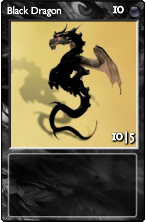 | Black/Obsidian Dragon Blacks are the classic evil dragons from D&D to Might And Magic. But obsidian... that's an interesting... mineraloid (=mineral-like). But why not calling it a 'mineral'? Because it does not have a crystalline structure (being a glassy material it is amorphous) and also its composition is too varied. It is natural, volcanic glass produced by volcanic eruptions from quickly cooled lava which is rich in silicon dioxide (70% or more in weight). Most obsidians are black (or dark brown) due to magnetite nanoparticles. Snowflake obsidian contains white-ish cristobalite patches which shows partial crystallization. (These are a form of silicon dioxide, too.) And why does a material lack crystalline structure? There are two reasons. If the lava cools too quickly the particles won't have enough time to take up a structure in which said particles would be in a strict periodical order in space. (This is pretty much the definition of amorphous materials - the order can exist only in very short distances, but not for the whole piece of material.) Also, rhyolitic lavas have high % of silica (SiO2), thus they have high viscosity which makes diffusion very slow. This inhibits the creation of nucleation points and crystallization won't start. But being an amorphous material is a metastable state. It means it will slowly crystallize, as atoms have the freedom to wander slowly even in a solid material. Given enough time it'll just turn into fine quartz (and other mineral) crystals (see snowflake obsidian!). Because of this obsidian counts as a young rock (yes, it can be classified as a rock, an igneous rock), rarely older than 20 million years. Proximity to water also has an effect on its life cycle, it speeds up the devitrification process (=turning to crystalline again). Obsidian has a hardness of 5-6 on the Mohs scale. The maximum of the scale is 10, glass has a hardness of 5.5, so it isn't a super hard material. It fractures conchoidally (=curved, shell-like shape) and the fresh surface is extremely sharp. Because of this obsidian had many uses since the dawn of human time. Our ancestors made a lot of different tools from obsidian, like cutting tools, knives, weapons (spearheads, arrowheads). Large polished slabs were used as mirror. Obsidian surgical blades are still in use in some cases since it has a better edge than metal blades, plus they aren't magnetic (think about a surgery combined with MRI). And of course it can be wielded as a gemstone. |  |
 | Devourer/Pest You'd suppose that a devourer devours. And yet it does not omnomnom anything. It devours your soul. It devours your precious life source, your quanta. The graphics are pretty strange. What's that colorful in the left part of the image? Cables? :) They can also burrow, which is logical if it is a bug-like thingie. At least the upgraded name suggests the latter. Colloquially every troublesome living being being can be labelled as pest. Bugs, wasps, aphids, ants, locusts, termites, fleas, bed bugs, mosquitoes, cockroaches - all sort of insects and its larvae -, worms, molluscs, pigeons, even some plants... feel free to add more. Anything which directly or indirectly bothers humans in large quantitites qualify for this category. The older meaning of 'pest' is a deadly epidemic disease, specifically plague. This meaning is maybe even closer to the mechanism of this card. Slowly draining you away. Though, one may add that the aforementioned pests work similarly: day by day you must fight them to fend them off, but eventually they come back, and continue harassing your enviroment and... nerves. (Have you ever noticed that PEST are only one letter transfer from PETS?) | 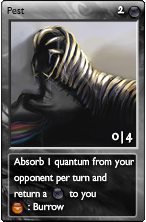 |
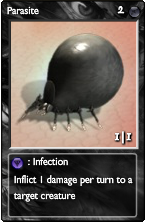 | Parasite/Bloodsucker Parasitism. A way of existing when someone/something lives using someone/something else's resources without giving back anything, without contributing anything useful for the HOST. Using only the language of biology it is a consumer-resource interaction, where the previous do not kill (maybe only slowly) the latter and using it for an extended period. Parasites usually specialize for a species. They range from single-celled (agents of certain sicknesses) to lice, fleas, mosquitoes, bugs, worms, vampire bats and even to birds; and there are also parasitic fungi and plants (think of the "cute Christmas thingie", the mistletoe). Viruses are also considered parasitic. I won't mention any extreme examples, you can find yourself enough on the internet. Evolution is very creative when it is about survival and suffering. Parasitos in Greek means "one who eats at the table of another". How poignant. Hosts and parasites evolve together and sometimes this "softens" their relationship as the parasite's interest is the host's extended survival, too. Parasites often affect the nervous system of the host making them expressing unfavorable behaviour to themselves, but useful for the parasite's reproduction and/or life cycle. Parasites can range from being a nuisance to lethal. It isn't surprising that the earlier records which show that our ancestors suffered from parasites as well go back until ancient Egypt or Rome. Many of these pests are simply just bloodsuckers, like bed bugs. In-game parasites deal only 1 damage, but can terrorise the opponent doing this repeatadly as real parasites did that with their hosts. Parasites reproduce quickly, so giving them a passive which makes them double after each turn would be logical, but that portfolio is already taken by the malignant cell. The issue is somewhat solved with Bloodsuckers, since they punch 3 dmg for only 2 quanta. The picture resembles a tick. These parasites are often vectors for certain diseases (=they spread them), so the in-game infect skill is rightfully earned. Do you know anglerfishes? You know those spectacular specimens with those cute luminescent thingies? They are ALL female. The males are tiny parasites who are permanently attached to the female's body. How depressing. | 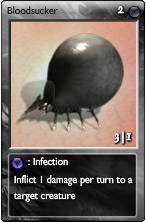 |
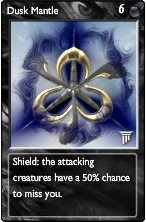 | Dusk Mantle/Improved Dusk Dusk. When the sun is already under the horizon. But how much exactly? Let's order how does an evening looks like: sunset, twilight, dusk. Sunset's time is definitive, but there are 3 types of twilights and dusks: civil, nautical and astronomical. Civil twilight - Sun is less than 6 degrees below the horizon, civil dusk - the moment when the center of the Sun is 6 degrees below the horizon in the evening, nautical twilight - Sun is between 6 and 12 degrees below the horizon, nautical dusk - exactly 12 degrees below, astronomical twilight - between 12 and 18 degrees below, astronomical dusk - exactly 18 degrees below. And then, it feels like the Earth is shrouded in dusk's mantle. After that there comes the night. The card is sorta a more expensive Fog Shield. They both play on a "reduced visibility will cause you do less accurate attacks, and thus less damage" idea. Fog Shield is cheaper - a nice little fog can be created anytime, regardless of daytime. But you'll have to wait for dusk to arrive - so this card is more expensive. Together with Vampire Dagger they are able to form a 2-card stall... The quintessential rogue outfit: you have a big black coat, wait until dusk and point that pointy dagger against someone - and maybe steal some valuables. | 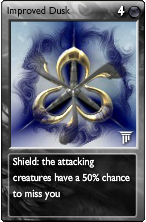 |
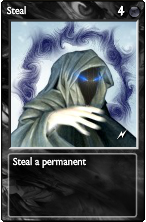 | Steal/Improved Steal Quoting wikipedia: "the illegal act of taking another person's property without that person's freely-given consent." Theft wasn't invented by human beings. It is a well-documented behaviour in the animal kingdom, and it is called kleptoparasitism - which means being a parasite by stealing someone's hardly earned food. Even certain arthropods are following this strategy to get sustenance. Some animals doing this as a lifestyle, while others indulging it only opportunistically. This card has more relations to law than natural sciences... Also it has a little connections to psychology, which is more interesting to me than arbitrary rulesets. The obvious motivations - economic, rebellion, drug addiction, conforming with a peer group - aren't so exciting, but things like compulsion, boredom, self-esteem problems can really titillate my attention... but not enough to search for those infos now. Sorry for stealing your time. |  |
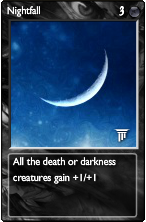 | Nightfall/Eclipse Let's catch up from Dusk Mantle: after dusk the night falls. Well, it can be hardly any darker when there is night already, right? The upgrade thinks otherwise. Let's explore eclipses, shall we? There are lunar and solar eclipses. Practically they are caused by huge shadows cast on and by celestial bodies. For this 3 objects must align (this is called a syzygy). Solar eclipse: the Moon gets between the Sun and the Earth and its shadow crosses the Earth's surface. Lunar eclipse: the Earth gets between the Moon and the Sun and its shadow crosses the Moon's surface. It can also apply to other systems, not just Earth-Moon-Sun. There are total and partial eclipses - the names itself tell everything. Let's talk only about total eclipses! Lunar eclipses happen more often. The Moon won't completely disappear from the sky at a total lunar eclipse. Instead it just turns reddish, because the only light which reaches the Moon gets refracted through our atmosphere. (The phenomenon caused by the Rayleigh-scattering, the same thing causes the Sun appear red at dawn or at sunset.) All in all a total lunar eclipse won't make the sky darker than a new moon. A solar eclipse achieves even less. In the moments of totality the area won't look like it's night. It will resemble more to dusk. So, sorry, this upgrade is fancy, but in nature first: it last only seconds/minutes (solar) or 2 hours max. (lunar), second: it won't get that dark. Let's say Zanz's approach here was more astrological than astronomical. :) Nightfall also means the nocturnal involuntary ejaculation... | 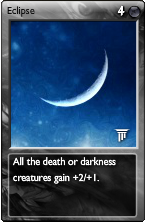 |
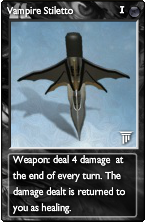 | Vampire Stiletto/Dagger I think Vampiric Stiletto would have been a more fitting name, since the blade itself isn't a vampire (or is in the property of a vampire), it has vampiric properties. Otherwise, vampiric weapons (life- or mana-leeching weapons) are a fantasy staple. Interestingly enough often dagger-type weapons are having these properties. (Other trope is the "poison dagger", which we already saw at Arsenic.) Also Stiletto sounding more 'elite', it should have been the upped version in my opinion. |  |
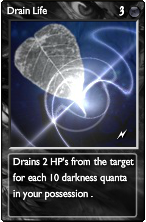 | Drain/Siphon Life Ooh, another vampiric thingie! And another often used spell in fantasy games. Anything else related explained at the next card... | 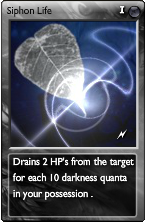 |
 | Minor Vampire/Vampire Children of the night. Bloodsucking undeads who are feeding on the blood of the living. The earliest depiction of vampires are from Mesopotamia, and they appeared in many different cultures (Ancient Greece, Rome, India, Jewish traditions, later Medieval and modern Europe, Asia, Africa, Americas). The exact origin of the word is unclear, most sources think the Slavic origin has the greatest chance to be true. Considering the many folk tales about vampires in the Carpatian basin and the Balkan it seems plausible. The vampire myth gained popularity after John Polidori's 1819 work, The Vampyre, which was followed by Bram Stoker's quintessential novel, Dracula in 1897. It spawned an entire subgenre in the horror genre, which is still popular. We can safely say B?la Lugosi immortalized Dracula. Stoker's inspiration for Dracula was Vlad Tepes, the voivode (=military leader/warlord) of Wallachia between 1448 and 1476/77. He earned the nickname Vlad the Impaler and Vlad Dracula. As a voivode he was famous for impaling two of the Ottoman Sultan's envoy. There were several anecdotes about his cruelty. His nickname Dracula* originated from his father who was the member of the Order of the Dragon, a chivalric order which was found in 1408 by Sigismund of Luxembourg the king of Hungary and Croatia. (The order was dedicated halting the Ottoman advance into Europe.) Different stories can concoct different abilities for vampires, but most of them uses Dracula's abilities as a basis. He possesses an ungodly amount of special abilities like superhuman strength, being immune to conventional attacks, flying, climbing, hypnotic, telepathic and illusionary skills, capable of limited teleportation, commanding animals, manipulating weather, shapeshifting... The game's batlike creatures are just novices compared to him. Since vampires cannot have a mirror image maybe it would have been logical to deny the usage of the Parallel/Twin Universe card on them. Dracula also has limitations. He is less powerful in the daylight. Shapeshifting ability works perfectly at night, but in the daylight only at dawn, noon and dusk. Many other abilities doesn't work in the daylight - though the sun doesn't burn him. He cannot control his bloodlust. Garlic and sacred items and symbols repulse him. His sleep is kinda like a torpor, a deep, almost deathlike slumber. He needs Transylvanian soil to be nearby to him in a foreign land. If we are about torture and blood-usage, let's not forget about The Blood Countess, Elizabeth B?thory, a Hungarian noblewoman. Legends say she bathed in the blood of virgins to retain her youth. She has been charged with the imprisonment and torture of more than 100 girls. She lived in the 16th century and these accusations lasted for more than 400 years. Scholars lately thought the she might have been the victim of greater schemes which caused her accusation and persecution. Her family's influence was a threat to her neighbors, including the Habsburg empire. Also let's not forget the large area she owned which just got bigger after the death of her husband. Fun fact: Hungarian King Matthias Corvinus held him in captivity from 1463 to 1475, which kinda means he imprisoned Dracula. :D OK, that's for the history lesson, now move on to biology. Many animals rely on drinking the blood of other animals: oxpecker bird, leeches, lampreys, mosquitoes, cooper's nutmeg (a marine snail), bed bugs, ticks aaaand vampire bats. So that's where from Dracula got that cool shapeshifting ability! Well, not entirely. Vampire bats are indigenous to South America, so they weren't discovered until the 16th century. The bats were named after the folkloric creature and not vice versa. Bats have been long associated with supernatural, their presence was ominous, because of their nocturnal habits - that might explain their place in the folklore. Vampire bats really drink blood - 2 species specialized primarily on birds, the other on mammals. Which means, the latter sometimes drinks human blood - though we aren't highly listed on its menu. They are able to consume half of their body weight - 20 grams - in a 20 minutes session! They are having a great infrared sense which is crucial detecting their targets in the dark. They can transmit rabies - thankfully that haven't got integrated into the game... But I do miss some weakness... granted, Holy Light onehits all :darkness creatures, but still...** Some pests and other nocturnal bugs have a negative phototaxis, which means they moves away from light sources. That's why you see cockroaches running away when you turn on the light. Ofc it does not kill them, but every moment spent in light improving their chances of getting squashed. Minor Vampire sounds like it is a child. :D (https://i.pinimg.com/736x/78/55/b1/7855b12b78be123b8056b9f5176bf74f.jpg) |  |
 | Liquid Shadow If you search for this term you will find mostly make-up products, namely eye shadows. :) Funky stuff. WOW has a similarly named item, but added only in 2012. Don't know what was Zanz's inspiration, but undead shadows or magic shadows is sort of a fantasy trope. Or think about the silvery liquid in the Matrix (ok, not shadowy, but you get it, if you saw the movie). The Liquid Shadow takes your skill away, gives you vampirism and also poisons you. Such a dreadful way to die. You lose your positivity and start leeching your surrounding, but it won't make you alive in the end anyways. As if a malevolent entity, a malevolent intention took over your body just to take away your body and spirit as well. Well, the whole :darkness as an Element is about malevolent exploitation and hiding away from those who wish to expose the exploiter. | 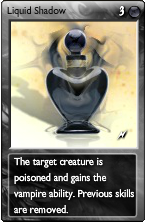 |
 | Gargoyle Oooh, satanic imaginery, goth stuff! They are inspired by an architectural element. On buildings these stone statues serve as a spout, to channel water away from the roof and from the side of the building (obviously the lessen the erosion of the wall by water). The word has Latin/French origins (with meanings like "throat" or "swallow"). Another architectural element is called grotesque, but they aren't gargoyle, they are fantastic or mythical creatures. The differences between them that gargoyles are specifically designed to drain water away from the side of a building. These gargoyles doesn't have to have a winged / demonic look, they were often just animal-shaped*. Most gargoyle monsters are made of stone and magically animated. In D&D they are chaotic evil, so their place in :darkness is well deserved. The stone form skill also understandable thinking about their origins. Google "alien gargoyle"! :-) My favorite in-game gargoyles are in Diablo - their stone form is so cool, and that leathery-papery sound when they die and crumble... :-) The Crow's main bad guy fell on a gargoyle and got impaled by it. It is probably the most gothic death ever in a movie. |  |
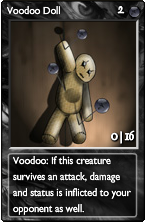 | Voodoo Doll Remote torture device. You know the drill: create a small effigy then push pins into it, hoping that the represented person will get hurt by this magic. This is perfectly represented by the game: any hurt done to the creature done to the opponent as well. Oddly enough it has nothing to do with Voodoo religion, but many cultures has these sort of magical practices in their "arsenal". 20th century books and movies made this distorted image, and these are the sort of connections which are hard to erase from people's mind. In fact Voodoo practitioners are really pissed off by Hollywood's work which made this strong connection. Nevertheless the notion fits well to :darkness. Something Hungarians might know. Something you wouldn't have thought that might exist... But hey, that's the internet. | 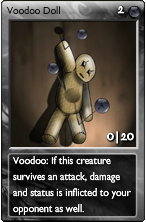 |
 | Nightmare Bad dreams which are causing great stress, fear and/or anxiety. These dreams are not just very upsetting, but often quite vivid as well. Sometimes the awaken individual is so terrified that he/she may find it hard to resume sleeping. I guess everyone has a technique for awaking from nightmares, mine is to turn on the lights for a few minutes, take a walk to the bathroom, have a glass of water, realize strongly that this is The Reality then go back to sleep. But what is a mare? It is a creature from Germanic/Slavic folklore who were thought to ride on people's chest while they sleep, and they were causing our topic, the nightmare to the recipient. This is aligned with the fact that people having a nightmare often feel if they were unable to move. Scientists hypothesised that maybe it is linked with sleep apnea, too. (Longer pauses in breathing while sleeping - simplest variant is snoring.) They haven't found a connection. Another study found quite the opposite, but they were studying OAD (obstructive airways disease) patients with or without asthma. The results showed the patients with asthma had significantly more nightmares. This hints an evolutionary purpose to awake the person who is in danger. We still don't know the exact origins of nightmares, but in different instances these may be stress, sickness (fever), PTSD, bad psychological conditioning (having a negative, fearful mindset). Anyways, dreams are an interesting topic, and we still don't know why do we dream, let alone having nightmares. The game uses a funky method, your opponent's hand (mind) will be filled with the targeted creatures (images), and each copy will deduct 2 from his/her hit points (sanity) and heal you with the same amount of hit points. Wicked, but another perfect metaphor from Zanz. I kinda miss that Nightmare doesn't have a positive counterpart, like "Wishful Thinking" or "Heavenly Dream", but with a different mechanism (obviously not hand filling, we have Fractal for that). Or an anti-anxiety medication/meditation which drives away that Nightmare-induced hand fill effect. :) Card graphics makes me think of those colorful rings when you rub your closed eyes. |  |
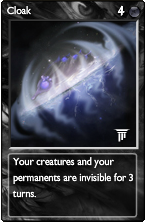 | Cloak Guess Nightfall would have been too op if it also protects the :darkness creatures, so Zanz separated the two, very similar permanents. Anyways, cloak is a cloth item, which is mostly worn as an outermost layer, covering the rest of the attire. Cloaks are popular in fantasy stories. These fantasy cloaks often have magical properties like invisibility or flying. They are also associated with vampires thanks to B?la Lugosi's outfit as Count Dracula. Last two phrases explains everything regarding their place in :darkness. It is not a metaphor, it simply does what magic or less magic cloaks used to do: hide someone/something away from prying eyes. Oddly enough chaos (pandemonium and other area of effect spells) will cancel out cloak. (Again, it is only problematic looking at the "real life logic", the in-game balance rightfully dictates this mechanism.) |  |
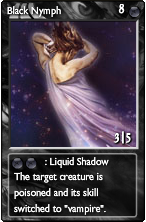 | Black/Dark Nymph Goth chicks. They are edgy - I wonder why Greys have the tattoo, not these babes - and can ruin every five o'clock tea party by poisoning the mood with that nasty Liquid Shadow spell. Their ability is to ruin others' ability. But hey, again: that's what :darkness is about. Reds drain you quickly these to that slowly... Don't know which is the better. :) | 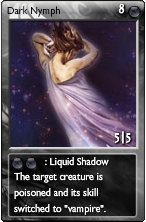 |
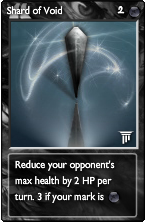 | Shard of Void Completely empty space. You may say "vacuum", but "void" is more scary, because it is less scientific, it refers to our fears of unknown and nothingness. You can see, it is both scientific and philosophical concept. Democritus thought the universe is composed of atoms and void. Aristotle had less fantasy, he thought nature hates the concept of void, stating "Horror vacui" which means "nature abhors a vacuum". History shows that Democritus was closer to the truth, but sadly, Aristotle had a much greater impact on science. (For centuries it was enough to quote him if someone wanted to disprove someone else's idea or argument.) He also denied the existence of finite entities. Later philosophers thought that outside of our known world is the void. Interestingly enough in the 17th century the idea of aether to fill that void was born. We all know that interstellar space is very sparingly filled with material. On average there is only 1 atom per cm3 there. Interstellar clouds are a bit denser: they contain about a million atom per cm3. While this sounds a big enough number, compare it with the amount of atoms in 1cm3 air on Earth: 10^19 (ten trillion times more). This already shows how thin interstellar space is. But what about artificial, man-made vacuums? An extremely high vacuum contain less than 10000 atoms/cm3. The highest vacuum ever achieved contained about a few hundred to few thousand atoms per cm3. You can see that it is still a few magnitudes away from the density of space. And perfect vacuum - just like absolute zero temperature - is unreachable. All in all, ancient thinkers were right: the space which surrounds Earth is very close to a void, but a true void exists only in philosophy. Let's think on an even larger scale! The Universe is not evenly filled with galaxies. There are surprisingly great areas which are less densely populated with galaxies than the rest of the Universe. These are called voids. Their density is less than 1/10 than the rest of the Universe. This means they aren't completely empty, but they contain very few or no galaxies. They can span from a few million to few billion lightyears. Their origin is unclear, though there are theories for explaining their presence. Simply we can look at the Universe as a big chunk of foamy material, where the bubbles are the voids, and the remaining material with clusters and filaments are the galaxy-rich regions. Currently it is believed that the material of the Universe at the Big Bang was anisotropic (=not equally distributed), and these small differences grew larger as the Universe expanded. You may still say that voids must be very rare, but currently we know dozens of voids. Supposedly our Milky Way is in the so-called KBC Void. The in-game item doesn't really reflect these. Maybe the philosophical void: with each passing turn your opponent's maximum potential gets reduced to the point when even a Miracle can't help him, and continuous divine interventions can only delay the inevitable. There is a final frontier and all living beings heading towards that. Into the unknown. |  |
Post by: Wyand on May 10, 2023, 10:02:33 pm
:aetherbig | AETHER | |
| The personification of the bright upper sky in Greek mythology. There are different approaches to its origin: he is either the son of Darkness (Erebus) and Night (Nyx) or the offspring of Time (Chronos) and the brother of Erebus and Chaos. * The word itself in Homeric Greek means "pure, fresh air" or "clear sky". It was also thought to be the pure essence gods breathed, filling the space where they lived. Ancient Greek philosophers (Plato, Aristotle)** continued this notion, adding aether to the 4 classical (terrestrial) elements (air, water, earth, fire) as 5th element noting that it is located in the celestial regions and heavenly bodies and does not share any of the qualities (dry, wet, cold, hot) of the terrestrial elements. He used this element as an explanation for the movements of planets and stars. Medieval alchemy continued this philosophy, even named this 5th element as quintessence and started trying to "extract" it through various methods from different materials. Oddly enough science also used the idea of aether - 17th century physics because they needed a medium which helps explaining the travelling of light through space. They called it "luminiferous aether". Known waves needed a medium to propagate, thus it was thought that light also need such a medium to travel through empty space. We have to mention Boyle's and Huygens's name here, they were two proponents of the idea of aether***. Experiments in the late 19th and early 20th century disproved this idea. Einstein's special theory of relativity also made serious blows on hypothetical aether. Nowadays the scientific community doesn't accept the existence of aether as a medium which helps propagating electromagnetic waves and gravitational waves/forces. I have to add that there is a new hypothesis which supports the idea that the still-mysterious dark matter may be 'aether' - the medium pervading the Universe. In this game :aether is home to cards which are related to godliness (invulnerability, special - not physical - damage), reality manipulation, space, mathematics, psionics. This is the domain of the ancient culture's :aether. Actually it is much more confusing, with more possible genealogies. Though Plato used the word aether, Aristotle haven't. He just named it "first element", later scholars started using the word 'aether' for his concept. You might heard Boyle's name in physics class, Boyle-Mariotte law bears his name, which states that the pressure and volume of gases are inversely proportional. Also you maybe heard about the Huygens probe which descended onto Titan, Saturn's biggest moon. There is a good reason naming it after Huygens, since among other fields he contributed a lot to astronomy. | ||
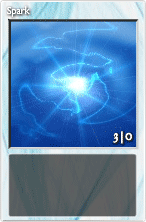 | Spark/Ball Lightning Two ephemeral phenomenons. Confusingly a "spark" can mean 2 different, but related things, and only one of them has an earned place here. One of the sparks is chemical, a glowing burning particle. It can be metallic or even organic. These fit the element :fire. Electric sparks though, fit :aether, since Zanz did put almost all electricity related stuff here. (There is a reason behind that, but let's explore that at Lightning!) It was only discovered in the 17th century that these sparks are associated with electricity. It is a short electric discharge accompanied by a flash of light and a snapping sound. But what is an electric discharge? Charges accumulate on an object, this causes a difference in potential (voltage) and when they reach a certain amount they can release this static electricity through a medium. The charges will flow from one object to another. The charge carriers in most cases are electrons which can then bump into air molecules creating ions which will make the surrounding area electrically conductive. But how dangerous is a spark? According to Zanz they are mildly dangerous for a moment then they'll just dissipate. (I'm inclined to call Elements' Sparks just 'Zap'!) That it is true for most of the sparks, supposing everyday circumstances. You remove your synthetic piece of clothing - you hear that familiar cracking noise and feel that tingling/slightly painful sensation... and it is gone. This sort of spark-creation called triboelectricity, it is resulted from rubbing together otherwise non-conductive materials. The rubbing separates electrons, moving them from one object to another which will in time cause an electric discharge (the electrons "walk" back, charges get evened out again). However, these small sparks can be a source of danger. Electric devices (especially computer components) can be very sensitive to these voltages, it can downright kill equipment parts. A spark can also cause fire if it meets flammable materials, gases, liquids or fine dust. Think about electric gas lighters. Using antistatic straps, boots etc. is very important for these workplaces. A spark can also directly kill a person!* In case of a heart operation it is very important not to produce triboelectric sparks, since it is enough to stop a heart. We will talk about bigger sparks later. Ball Lightnings are more mysterious. There are many records since medieval times which reported about glowing spherical objects (ranging from cms to meters) which last much longer than an ordinary lightning and moved often in an erratic manner. However investigating the phenomenon is problematic since it seems to appear randomly, we don't know how to reproduce it, so scientist most of the time depend on public sightings. The descriptions are very inconsistent, partially due to psychological factors. They are often associated with thunderstorms. Scientist came up with many different hypotheses - none of them are proved yet. Their greater attack in the game can be explained with the fact that often these stories about ball lightnings report big explosions/damages. Sadly I can't point to a source, so you might say this is anecdotal stuff, but consider that our body is a bioelectric-biochemical construct, and the heart has its own conduction and electric signal generator system which defines the base rhythm of it. The resting membran potential is about 60-90 mV. Currents greater than 75 mA cause ventricular fibrillation. If the electricity goes directly through the heart a mere 7 mA is enough to kill. (Which is not a surprise, considering that I found that the heart is capable only to produce 5 nA, which is less than one thousandth of the lethal amount.) | 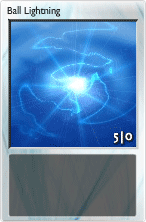 |
 | Lightning/Thunderbolt Big sparks - big electric discharges. They are the bigger brother of those small, finger-shocking nuisances, which are created by rubbing together materials. But what sort of things rub together in the air? Well, water droplets and/or ice crystals. The winds in those clouds are really fast and turbulent. The downdrafts and the updrafts meet and some electrons are stripped off. The top of the cloud gets positively charged while the middle/bottom negatively, and as the storm moves over the ground it starts attracting positive charges from there. They sorta start seeking out each other and when they've met we have the lightning+thunder phenomenon. In fact, the ground isn't necessarily needed: lightnings can happen inside a single cloud or between two clouds. Some interesting lightning facts. 1. They are hotter than the Sun's surface: they instantly heat up the surrounding air to 30000 Celsius! 2. Their electric current can reach 30-120 kA! 3. An average lightning flash produces so many energy that it could light a 100 W classic light bulb for 3 months. 4. About 44 lightnings per second happens on Earth. 5. They travel about 434000 km/h. 6. For a constant lightning show visit Lake Maracaibo in Venezuela. 140-160 days a year it is stormy there, 40000 lightning strikes per stormy night! 7. When lightning hits sand it instantly melts it into a peculiar glassy tube-like shape, named fulgurite. Probably Zanz's reason to put lightnings (and other shocking thingies) here, that they are produced in the atmosphere, high above our heads. From an ancient religious perspective they are something arriving from aether. For example Zeus throws them. :) There are other electric phenomenons, which are rarer than lightnings. One of them is the 'sprite' or 'red sprite'. They happen in the mesosphere, high above thunderstorm clouds, and are orange-red colored. We still don't know much about them, though some sightings and photographs do exist. | 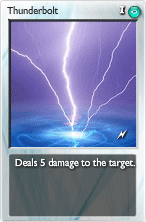 |
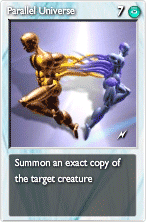 | Parallel/Twin Universe A lovely concept which is gaining popularity again "thanks" to comic books. But there are also complete scientific books about the possible existence about parallel universes. First I'd like to present my long-time idea about it. In every moment there is a "choice". For now let it be a choice by someone. For example you are choosing what to have for breakfast. You are torn between having fried or boiled eggs. You look at the dishes and see that your skillet is dirty. OK, too tired now, it'll be boiled eggs. I have 3 eggs in my fridge, should I have 3 or 2? Being only half-awake you drop one on them. Two will it be. Soft-boiled or hard-boiled? I'm way too hungry now, soft is good for this morning. Let's check the smartphone while waiting for the eggs... oh, 10 minutes passed and I'm still scrolling some stupid feed... hard-boiled eggs, here I come for you! You can see a pattern now - for each decision the space-time continuum gets bifurcated: there was a YOU walking toward that trajectory made by your choice, and a COPY OF YOU maybe making another choice. You may say the actions of this character was sorta predetermined, but for each situations/actions there are many previous situations/actions which influence the current one. And some of them are almost random. A roulette ball might hit 0, but some unexpected event (for example someone slipping and dropping to the ground) might change slightly the course of the ball and making it end in 32. This idea causes the creation of the multiverse, where infinite amount of universes co-exist parallel to each other. And it turns out quantum mechanics is able to explain my thoughts! The problem is linked to Schrodinger's Cat. If you remember the explanation at :entropy cards, the cat is in a superposition (both dead and alive) until we don't inspect the system. When we look at it, it gets fixed in that state. That's how small particles work. Let's apply this to our problem! Sadly, we must skip some confusingly difficult vital parts, so let's start with this: this interpretation asserts a few things related to quantum mechanics, without these assertions it won't work. The many-worlds interpretation states that the cat is really both alive and dead*, but they are in different branches of the multiverse. When a quantum event happens (in this case: the radioactive decay) a branch point is created. Quantum events are important here, since they are truly random events. Of course not every scientist is happy with this explanation. I really feel Zanz followed a similar logic, because that would explain why PU'd mutatees turn out being different than the original. This is called an entangled system. | 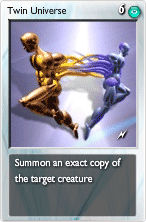 |
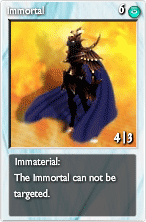 | Immortal/Elite Immortal The concept of being an exempt from death is an old one. The first known appearance was in the Epic of Gilgamesh. The notion itself probably goes back to the dawn of humanity. There are a huge number of mythological stories from different cultures which mention not just the gods (who are immortal by definition), but also mortals who were able to rise to immortality by various deeds. In most of the cases immortals also have eternal youth.* Sometimes immortality is a curse, just like in the case of undead creatures. There are cases when immortality is just a burden: look no further than the protagonist of Planescape: Torment. Or it is just a "Game" (Highlander). If we step away from fantasy toward science, we can talk about even more types of immortality. (Though some of these still belong to the "sci-fi" category.) There is a jellyfish species which is biologically immortal, since it can go back to its polyp state** under certain stress factors (not enough nutrients etc.). This is a unique ability in the animal kingdom. Some add bacteria to the immortals list, because they reproduce through binary fission, which means the newly created cell is a pure copy of the original (not factoring in eventual copy errors and mutations). Individual cells can also be immortal, but that's what we call cancer... these rogue cells have their "internal clock" hacked, thus they cannot die, their programmed cell death doesn't happen due to various factors. Immortality (or at least life extension) can be reached in the future by using advanced technologies. If we could manipulate our DNA's telomerase region (which gets shorter by every division) we could break the current age barriers. Nanomachines in the future also could help us reverse aging by repairing cells on a molecular level. Cryogenics also can help - at least in conserving victims of deadly diseases until the cure is found. And let's not forget about the immortality of the mind: in the far future one could upload his/her conciousness onto a computer system. Of course we could also create a cyborg body for this mind. Lastly we can talk about religious immortality, but I'd like to skip that, since listing only the greatest religions' take on it would take a full page. Let's just agree, that these religions mostly agree on the existence of a human soul which can be detached from the body. I do not share their views. I think everything we really are is stored in our nervous system - mostly in our brain.*** And how do these connect to this card? I strongly think Zanz just picked Immortal guards/warriors, who were elite infantry units in various empires (Persian, Byzantine, Sikh, Napoleon I's France). They cannot be targeted - a lesser equivalent of Phase Dragons, and because of this feels a bit superfluous. The choice for the passive is understandable, and their name itself explains it. Poor Tithonus! He was the lover of Eos, the goddess of dawn. Why poor then? Because Eos asked immortality for him from the gods. Which was granted. WHY poor then? Eos forgot to ask for eternal youth as well for him. When Tithonus got so old he wasn't able move and talk, she just turned him into a grasshopper. (By some sources into a cicada.) Most jellyfishes start their life as a sessile polyp and their transformation to the medusa form is a one-way change. Let's not forget how our gut's microbiome can affect our biochemistry and even our mood, thinking! | 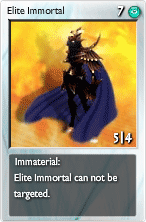 |
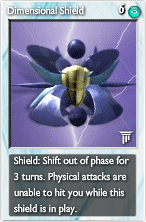 | Dimensional/Phase Shield We can safely assume that we are talking about physical/mathematical dimensions here, while 'Phase' can mean a lot of things. It can mean simply a region of space where the physical properties are uniform (often interchanged with "state of matter" though the two are not exactly the same), or mathematical phase space. The latter usage would be more fitting since it has connections to chaos theory, thermodynamics and quantum mechanics. Which would mean it is strongly connected to entropy (in my opinion :aether and :entropy are much, much closer to each other as it seems for the first look). Mathematical phase spaces are best explained throught dynamical systems*. These are described with unique mathematical theories. TL;DR - they are systems which change in time. But let's have a longer explanation... These are systems in which a function describes the time dependence of a point in a given space. Back to phase space: it is a space in which all possible states (unique particles' positions and momenta combined) of a dynamical system are represented. This all means that we can tell where a particle is located and what their momenta are at any given point and time. Shortly: it describes the system behaviour. Using this mathematics we can describe the behaviour of different dynamical systems like the flow of water in a pipe or the motion of random particles in air or how predators and preys affect each other. The best bet for that 'Dimensional' prefix that Zanz probably meant that the protected player simply shifts into another dimension. First, second, fourth - it doesn't matter. Just something different from normal 3D-space. But what about 'Phase'? Let's take the usual, "region of space" approach for first. You have a glass of water and you add some oil. The water and the oil do touch each other on the surface, but they are in different phases. If we add another liquid which is 1) also isn't miscible with any of them 2) its density is between oil and water, then we completely separated them from contacting each other. This would explain why we can't touch an opponent with 'Phase Shield'. OK, now for the other approach. In a phase space each particle has its own position and momentum for each moment. Which means each of them has their own trajectory. By definition these particles' trajectory can never cross at any point in time! This would also explain why we cannot cross this sort of shield. Of course it is more possible that Zanz was just looking for something similar connotation like "shifting in and out of a dimension", and "phasing in and out of existence" and it just works perfectly. If you remember Lorenz-attractor from :entropy's Butterfly Effect, that is the visual description of a dynamical system. | 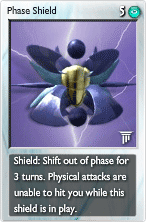 |
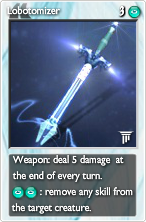 | Lobotomizer/Electrocutor Oh boy, such a horrible medical practice it was. The archetypical "at first, it sounded good" scientific discovery. The notion goes back to the 19th century when it was thought that certain areas of the cortex are responsible for the behavioral disorders of psychiatric patients. So far so good, but the idea here was that these areas should be disabled, removed from these patients. The pioneer of these studies was a Swiss psychiatrist Gottlieb Burckhardt. The results were mixed and colleagues dismissed his idea, so decades had to pass until another scientist tried experimenting in this area. This time the method was less crude, but still quite disturbing: they bored a hole into the patient's skull then injected pure alcohol into the frontal lobe. (Alcohol coagulates and possibly denaturates proteins thus killing the tissue.) The good doc - Portuguese neurologist Antonio Egas Moniz - got a Nobel prize for his treatment. The next step was to enter the skull through the orbital bone (eyesockets) - the injection remained either alcohol, or the more toxic formalin. The method went quickly popular, possibly because it was promoted strongly and the handling of these patients were much easier after the surgical procedure... In two decades more than 70000 people were lobotomized in the US and Europe. Oddly enough Scandinavian hospitals lobotomized 2.5 times as many people per capita as US hospitals. After so many decades and experiments the results were still mixed, and while there were patients who transitioned from badly controlled behaviour to childlike behaviour, many patients' health worsened - some of them even died after the surgery. Ironically the Soviet Union was the first to ban the practice in 1950 on moral grounds. Scientific and public criticism made the practice less and less popular. The development of new antidepressant and antipsychotic drugs also made it more and more obsolete. Still, we had to wait until the late 70s to reach the twilight of lobotomy. Nowadays lobotomy is banned in many countries, though it is performed in some rare cases as a last resort. The method is more refined and used in some severe OCD cases. Electrocution is 'just' causing severe injury or death by passing electric current through the body. Originally it meant only electrical execution (sounds like a portmanteau), but with time it was applied to all sort of electric accidents. Just a curious question: how much electricity is provided by the in-game weapon? It does not kill its victim, it "just" takes away its skill. 1 mA of AC or 5 mA of DC can be sensed by a person. About 10 mA of DC is enough to cause strong muscular convulsions for an average person, above that the victim cannot release voluntarily the electrified object. 30 mA of AC or 300-500 mA of DC is enough to cause fibrillation (which can cause cardiac arrest). Of course, these are only the currents, together with that a high enough voltage is needed, because the skin's resistance is quite big. If the current can bypass the skin (e.g. through electrodes inserted to the body) 10 microamper is enough to cause heart fibrillation. Though electricity is used as self-defense or as an enforcing tool by the police, I'm sure Zanz took the idea from medical therapies, namely the electroconvulsive therapy used for mental disorders. Through the 50s to 70s it was not rare to use it unethically, even as a sort of punishment for too problematic patients. The method often causes memory-loss. For a few weeks patients may feel better, but after the therapy 84% of the patients relapse within 6 months. Patients sometimes are convinced by professionals that this is really their last resort, just to get hugely disappointed by the results. All in all: humanity still has to find effective and humanitarian methods for curing mental diseases, because all current methods - surgical, electrical, biochemical - are very crude. I feel like I meandered a bit, but this topic really touched me. Maybe Zanz felt the same when seeing a famous American film, it could have been his inspiration*. The naming shows the upgrade-disease again: the base item has the cooler and more menacing name, since a psychiatric patient would first get electroconvulsive therapy and just later the lobotomy. Both of them results in losing a part of your humanity. Perfect and painful metaphor. I really don't want to spoil the movie, perhaps someone haven't seen it already. |  |
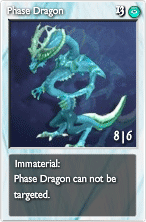 | Phase Dragon/Elite Phase Dragon The possible meanings for 'Phase' was completely explored at Phase Shield. Pick your favorite explanation and apply that to Phase Dragon as well. This creature isn't targetable -which is in accord with its name, and I prefer it largely over Immortals, since 'immaterial' somehow sounds logical for them (maybe just my fantasy game experiences...). | 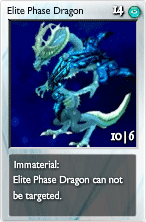 |
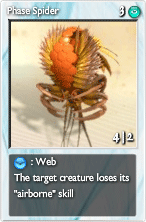 | Phase Spider/Recluse It seems that after a time Zanz fell in love with the word 'Phase'. And borrowed this critter from D&D - except this one cannot magically shift from the Material Plane to the Ethereal Plane, or vice versa. It would have been too much dodge for :aether creatures... So he just made them very punchy as their :death counterparts: greater attack to show the cunningness, and less health to show some fragility. | 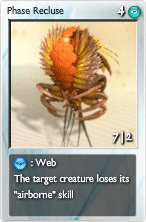 |
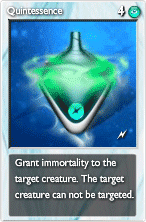 | Quintessence Oh, the philosophical quintessence I mentioned in :aether's intro. It means it is the most :aether card. Quintessence was just another name for aether as an element. And if we look at the origins (the air the gods breath in) it is understandable that this card rewards a creature with immortality. Medieval alchemy really liked the concept of quintessence and popularized it. Medicinal alchemy even tried to isolate it as a material and incorporate it into elixirs. Supposedly quintessence was able to get rid of any impurities (sicknesses etc.) of the body. They hoped to create quintessence by distilling alcohol 7 times. Granted, using this method you could easily feel yourself godly after imbibing the 96% alcohol - for a while. :)* In medieval times it was normal to think that these distillates are 'acque vitae' (water of life). Even dying people got spirits administered to them to give them a last breath of life. As mentioned alchemist also believed that the same could be done with any other material, not just alcohol, to concentrate them through distillation and get their 'quintessence'. We can say that these enthusiastic fellows did a lot for chemistry, since they refined the same material over and over, meaning they put down the basis of purification methods. At the same time they also improved the procedure of extraction, since they used alcohol as a solvent to extract the essences of plants. These liquids were called elixirs. These elixirs - being the extractions of useful herbs - were really useful, maybe not THAT useful they thought philosophically. Herbal concoctions are still called quintessences or elixirs sometimes, and producers of hard liquors often refer to their best drinks simply as quintessence. In current physics quintessence is used to refer for the ever-elusive dark energy. The Universe's rate of expansion accelerates, and it really gives scientists a headache, because there is no apparent reason for that. To tackle the problem it is hypothesised that there is a so-called dark energy, which is responsible for the phenomenon. In short, quintessence is a hypothetical form of dark energy. Some scientists even proposed that it is the fifth fundamental force of nature. For my taste there is too much hypotheses around the topic, which almost seem like constant guesswork. This could be explained by that 'I'm not an expert and should not comment things I do not fully grasp', but there is another problem. Physicists have a tendency of being idealists. That's bad. Because being an idealist one might think that the Universe is perfect and everything can be described with simple and eloquent functions and formulas. I think there is no place for such idealism in science.** It is very plausible to align our hypotheses to match an idealist picture (which was very popular in Ancient Greek philosophy), but science is more than that, one must have clear proofs. Confusingly this quintessence is described as either repulsive or attractive depending on the ratio of kinetic and potential energy. Its current repulsiveness should explain the acceleration in the expansion of the Universe - says the hypothesis. Let's leave it to future to fathom out this conundrum. The word 'alcohol' originally meant 'The Stibnite', which is a mineral with the formula of Sb2S3. (Originated from Arabic, ultimately derived from Akkadian.) This mineral's dust was used as antiseptic or eyeliner. They obtained it by sublimating stibnite, then depositing the vapours. The resulting very fine powder was considered the 'spirit' or 'essence' of stibnite. Later the word alcohol was used for all sort of distilled substances, then it was used exclusively for ethanol. This also explains why hard liquors are called 'spirits'. So when you read somewhere that alcohol means the 'spirit of wine', that's the story behind it. You can read more about the issue of idealism in physics in Sabine Hossenfelder's book Lost In Math (How Beauty Leads Physics Astray). |  |
 | Fractal Ever saw a picture which was quite colorful, and had funky, repeating patterns? Then you already saw a fractal. Chances are that you've seen the Mandelbrot set, the most common fractal. It was named after the mathematician who coined the name 'fractal' using the Latin word 'fractus', which means 'broken' or 'fractured', which refers to the strangest feature of the fractals: their dimension is not an integer, they have fractional dimensions*. It is interesting that the concept of fractals are so difficult, that it is nigh impossible to give a perfect definition of it. Although we can try to create some rudimentary one. Let's create a simple line, then branch it into two directions, forming a V-like structure. Repeat the process (this is called an iteration), then repeat it again and again. After several iterations a tree-like structure will emerge, a simple fractal**. Let's pick a fractal and zoom into it indefinitely - which is often shown by LSD-like GIFs - and see that no matter how deep we zoom we will always find similar patterns emerging. It is called self-similarity. Another typical property that they are incredibly detailed, it feels like they fill out the plane perfectly. You can see these properties yourself, if you try drawing the aforementioned simple "tree". Mathematicians agree that these are the most important characteristics of a fractal: they are infinitely self-similar iterated and detailed mathematical constructs. Fractals also have a finite area, but an infinite circumference. And we can apply this to fractals existing in a 3-dimensional space: they have a finite volume, but an infinite surface.*** And here we arrived to the point which is probably was awaited by some of you: nature is making some beautiful fractal symmetries! Be it a lighning in the sky, the roots and crown of a tree, the veins of a leaf, clouds, snowflakes, frost crystals on a window, our lung with its bronchioles, blood vessels, Romanesco broccoli, coastlines, river networks, microfilaments in the cytoskeleton, the molecule of glycogen... they are all fractals.**** There is an overarching symmetry. It is also proved that humans prefer fractal symmetries, which is rarely implemented in city planning which can be stressful for individuals living there. The easiest way to understand how this symmetry emerges everywhere is if we inspect our lungs, and remember the "finite volume, infinite surface"-property. Evolutions "goal" was to create an organ which has a relatively great surface compared to the available space in our rib cage. Millions of iterations resulted in our superior organ. The inner workings of the card are neat, and shows the "infinite iterations" and "perfect plane/space-fill" properties of a fractal. Just perfect. It is understandable that Zanz put this card into :aether because I think he wanted to underline the "aether permeates space" notion. This symmetry is seen everywhere. There is even a theory which claims that the Universe itself is a fractal (and/or the distribution of matter in the Universe). Fractals also shows a strong connection between :entropy and :aether. They have a relevance in chaos theory as they show up in the geometric depictions of most chaotic processes (see the Lorentz-attractor). Thus they have a connection to the butterfly effect: a small change in a single variable can have an unpredictable outcome. This fact is used by popular fractal generating programs. Also do consider that entropy likes to produce more and more possible configurations from which the most probable will be the dominant and at the same time a fractal is trying to find the most effective of these configurations. We can say that entropy is the wireframe, while the fractal (aether) is the realization.***** One must add that fractal dimensions are different from topological dimensions. There are some really cool definitions. 'An object which is chaotic in space.' OR: 'A geometric figure that does not become simpler when you analyze it into smaller and smaller parts.' For more interesting facts check the Sierpinski carpet and/or the Menger sponge. Of course not mathematically perfect ones, there are small differences in the patterns. I must add I wrote this section at least a year before the final editing before publishing :aether cards, and I am uncertain# about the last two phrases - I even wrote a small memo here earlier 'isthisgoodlikethat?'. I wanted to cover up my laziness not writing down sources, and tried to find them now, but alas, was not able to track them down. So it is possible that these were my own idea deducted from reading a lot about this topic. I also have to add that when scientific papers discussing the relation of entropy and fractals, they do not talk about thermodynamic or Boltzmann-type statistic entropy. They have their own concept and related more to the information content of a system. But of course, information theory's entropy has grown, evolved from Boltzmann's statistical explanation. It is directly analogous to it. The concept was introduced by Claude Shannon in 1948. hehe One last thought - mandalas are not fractals. Though they can use fractal-like elements, they do not obey to the basic rules of fractals. | 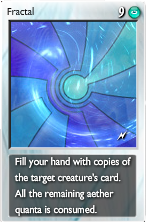 |
 | Mindgate :aether contains a few mind-related, let's say parapsychological cards. It is interesting how :aether and :time got these sort of cards. This card is about mind-reading. You won't be surprised if I conclude things early on: no matter what parapsychology claimed as an unusual ability/phenomenon none of them were ever proved. Famous skeptic James Randi even offered a 1 million dollar prize to anyone who is able to prove his/her supposed psychic abilities. Over a thousand people applied to it, but none of them were able to present their 'skills'. This card seems to be a mix between mentalism, telepathy and even precognition. But somewhat limited, since you know only the top card of the deck. What's interesting that this permanent's active skill is called 'duality'. To me this word connects to quantum mechanics, namely the wave-particle dualism AND quantum entanglement. (Of course it may mean the duality of electricity and magnetism, but that's less probable.) What is entanglement! Let's have two particles - if they are entangled it means that their quantum properties are linked together NO MATTER THE DISTANCE between them. Properties can be position, momentum, spin or polarization. Experiments shows that these properties are correlated for these particles. For example when a particle with a spin of zero decays and that produces a pair of particles one of them will have an 'up' spin*, and detecting that we can be completely sure that the other one has a 'down' spin.** Why is it strange? Because nothing can move faster than light, not even information. These experiments show as if somehow information is transmitted between the two particles. We can treat them as not individual particles, but as an inseparable whole. Why am I bringing this up? Because this card's inner workings are very similar to this. As if it would create an entanglement between your opponent's deck and yours. What's next there will be your next as well. Fractal copies your cards, Mindgate copies your opponent's topdeck and Parallel Universe copies any targetable card on the field to your field. All these cards ended up at :aether. These cards about creation, though not 'ex nihilo'-creation. Remember how :aether was considered the gods residing place in ancient times... For easier understanding let's just say that the spin is a magnetic property. Spins must be conserved that's why it is logical that from a zero spin particle there will be one with a +1/2 and another one with a -1/2 spin. |  |
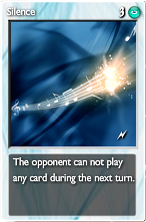 | Silence "In space no one can hear you scream." Why? Because of the almost perfect vacuum - without particles there isn't anything which could propagate sound. Silence can have a lot of meanings and causes - danger signalling, spiritual, commemorative, musical - but in this case it is the complete muting of a player. Certainly a situation when you wouldn't feel that "silence is golden". Since :aether isn't about forcing your opponent physically, but much more about being elusive, we can safely say that it isn't about numbing the vocal cord or some similar physical trick. Zanz's logic must be like "if we replace air with aether (space) than no talky-talky". | 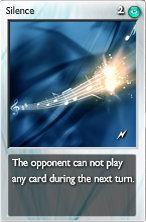 |
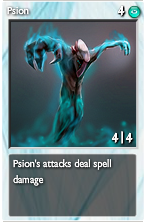 | Psion Here comes parapsychology again... or comic books? DC has an alien race named psions, and because they don't have psionic abilities, I'd say they weren't the inspiration for this card. The name would dictate it has a relationship to psionics - especially psychokinesis - but this creature has magic damage, not "remote physical damage". Since the mind seems to be :aether's domain in this game, we can say that Zanz simply added MIND damage to psions, but instead of having that as a skill like Mind Flayers (which uses :aether as a fuel!) they cause direct damage to your opponent. (Indeed, there are illithid psions in D&D.) Also it is worth noting that the word 'psionics' is a portmanteau from 'psi' and '-onics' (from electronics). This must be the reason that the attack of these creatures looks like an electric discharge. There is also a particle named 'psion'. It is better knows as J/Psi meson and it contains a charm quark and and a charm antiquark. Did you really think that I won't mention Starcraft??? :D I'm pretty sure the Protoss history, lore, those units with psionic powers really affected Zanz and/or the creator of the card graphics. :) | 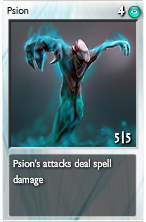 |
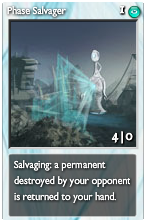 | Phase Salvager Environmental card no.2. Still a mystery to me why :gravity and :aether got the two permanent-saver card, but it was a bit more logical for :gravity, since recycling is a very physical thing. Gravity can certainly help in hoarding stuff in space, think about planet and star formation. We can say it happens in space, so let's add such a card to :aether... It is really funny, that the element which harbors the most hated shield also gets a save feature for that shield. :) All in all, Protect Artifact makes both less useful. Also Phase Salvager not having any health points, makes it even harder to use it for its feature. Btw, this duo makes me think of Wall-E and EVE. |  |
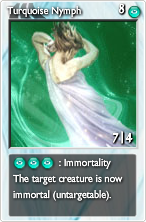 | Turquoise/Aether Nymph The general color for :aether is turqouise. These girls' touch will make you untouchable. Sounds like a curse in normal circumstances, a blessing in this game. | 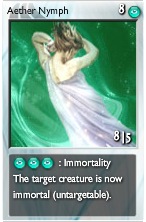 |
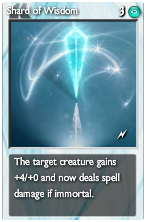 | Shard of Wisdom :aether sorta has a solution for everything: Lobo takes away 'wisdom', SoW gives another sort of wisdom. This sort of wisdom gives you psionic abilities, so you will be able to do that Psion-like mind damage - if the creature was immortal in the first place. It is more of a philosophical, religious card: an immortal gains extra powers. You must be long-lived to earn that wisdom... | 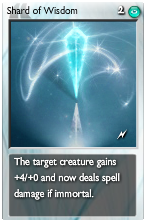 |
| ...to transcend to the higher spheres. Zanz is an artist. Thank you Zanz, for creating this fantastic game! |
Post by: Wyand on May 10, 2023, 10:02:56 pm
Post by: antiaverage on May 11, 2023, 01:11:10 pm
Post by: Wyand on June 13, 2023, 09:33:35 pm
Post by: Wyand on June 22, 2023, 10:05:21 pm
Post by: Wyand on April 17, 2024, 09:34:14 pm
Post by: Wyand on April 20, 2024, 11:31:24 pm
Post by: Wyand on May 05, 2024, 01:11:30 pm
Post by: Wyand on May 08, 2024, 11:12:10 pm